MaxStream XBEEPRO XBEE-PRO OEM RF MODULE User Manual revised users manual
MaxStream Inc. XBEE-PRO OEM RF MODULE revised users manual
Contents
- 1. ANTENNA LISTS
- 2. revised users manual
- 3. User Manual
revised users manual
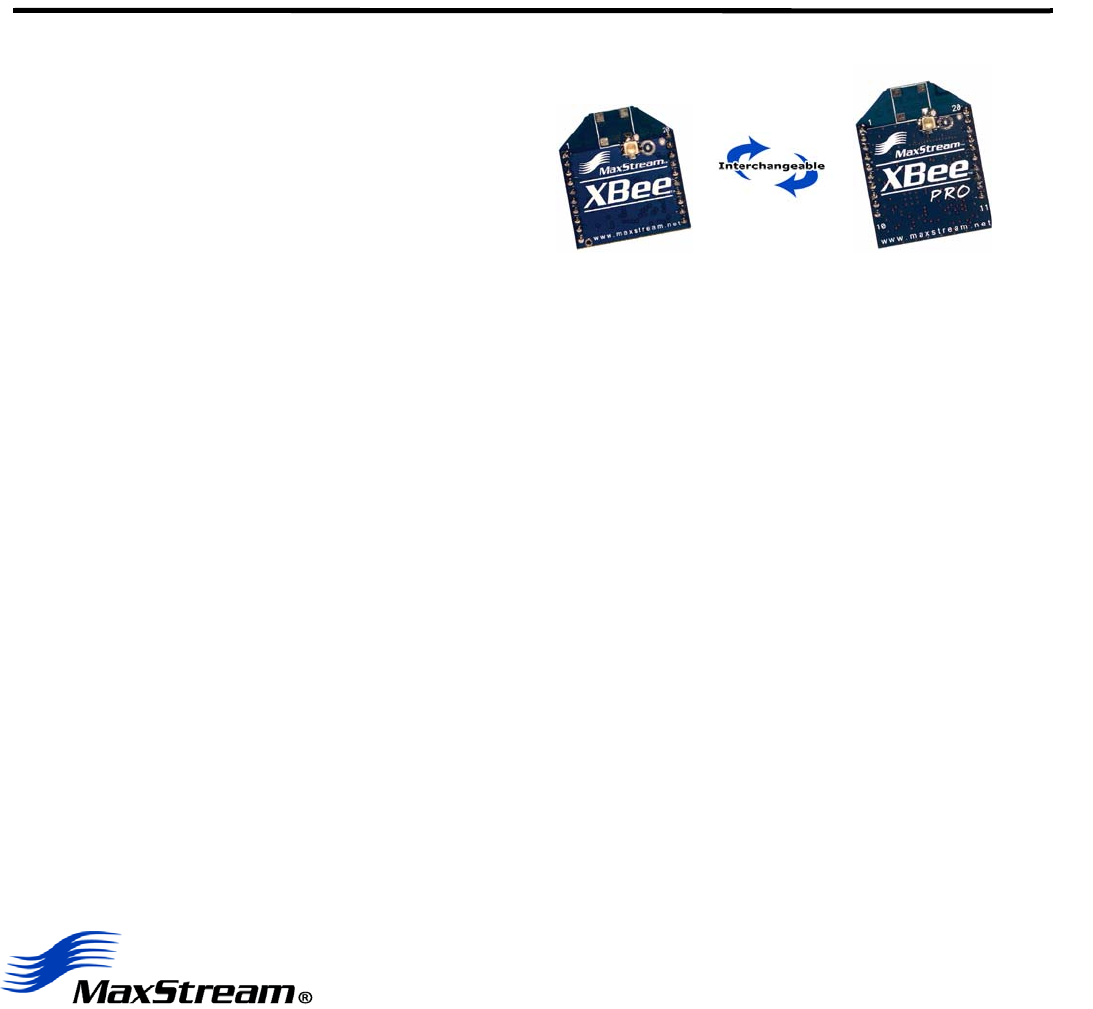
355 South 520 West, Suite 180
Lindon, UT 84042
Phone: (801) 765-9885
Fax: (801) 765-9895
rf-xperts@maxstream.net
www.MaxStream.net (live chat suport)
XBee™/XBee-PRO™ OEM RF Modules
XBee/XBee-PRO OEM RF Modules
RF Module Operation
RF Module Configuration
Appendices
Product Manual v1.x7C BETA
For OEM RF Module Part Numbers: XB24-...-001, XB24-...-002
XBP24-...-001, XBP24-...-002
ZigBee™/IEEE® 802.15.4 OEM RF Modules by MaxStream, Inc.
M100232
2005.12.02

XBee™/XBee‐PRO™OEMRFModules‐ProductManualv1.x7CBETA[2005.12.02]
©2005MaxStream,Inc.,Confidential&Proprietary‐AllRightsReserved ii
© 2005 MaxStream, Inc. All rights reserved
Nopartofthecontentsofthismanualmaybetransmittedorreproducedinany
formorbyanymeanswithoutthewrittenpermissionofMaxStream,Inc.
XBee™andXBee‐PRO™aretrademarksofMaxStream,Inc.
ZigBee™isaregisteredtrademarkoftheZigBeeAlliance.
TechnicalSupport:Phone:(801)765‐9885
LiveChat:www.maxstream.net
E‐mail:rf‐xperts@maxstream.net

Contents
XBee™/XBee‐PRO™OEMRFModules–ProductManualv1.x7CBETA[2005.12.02]
©2005MaxStream,Inc.,Confidential&Proprietary‐AllRightsReserved iii
1. XBee/XBee-PRO OEM RF Modules 4
1.1. Key Features 4
1.1.1. Worldwide Acceptance 4
1.2. Specifications 5
1.3. Mechanical Drawings 5
1.4. Pin Signals 6
1.5. Electrical Characteristics 6
2. RF Module Operation 7
2.1. Serial Communications 7
2.1.1. UART Data Flow 7
2.1.2. Flow Control 8
2.1.3. Transparent Operation 9
2.1.4. API Operation 9
2.2. Networking Systems 10
2.2.1. NonBeacon 10
2.2.2. NonBeacon (w/ Coordinator) 10
2.2.3. Beacon-enabled 11
2.2.4. Association 12
2.3. Modes of Operation 15
2.3.1. Idle Mode 15
2.3.2. Transmit & Receive Modes 15
2.3.3. Sleep Mode 18
2.3.4. Command Mode 20
3. RF Module Configuration 21
3.1. Programming the RF Module 21
3.1.1. Programming Examples 21
3.2. Command Reference Tables 22
3.3. Command Descriptions 28
3.4. API Operation 43
3.4.1. API Frame Specifications 43
3.4.2. API Types 44
Appendix A: Agency Certifications 48
FCC Certification 48
OEM Labeling Requirements 48
FCC Notices 48
FCC-Approved Antennas (2.4 GHz) 49
European Certification 50
OEM Labeling Requirements 50
Restrictions 50
Declarations of Conformity 50
Appendix B: Development Guide 51
Development Kit Contents 51
Interfacing Options 51
RS-232 Interface Board 52
Physical Interface 52
RS-232 Pin Signals 53
Wiring Diagrams 54
Adapters 55
USB Interface Board 56
Physical Interface 56
USB Pin Signals 56
Appendix C: Additional Information 57
1-Year Warranty 57
Ordering Information 57
Contact MaxStream 58
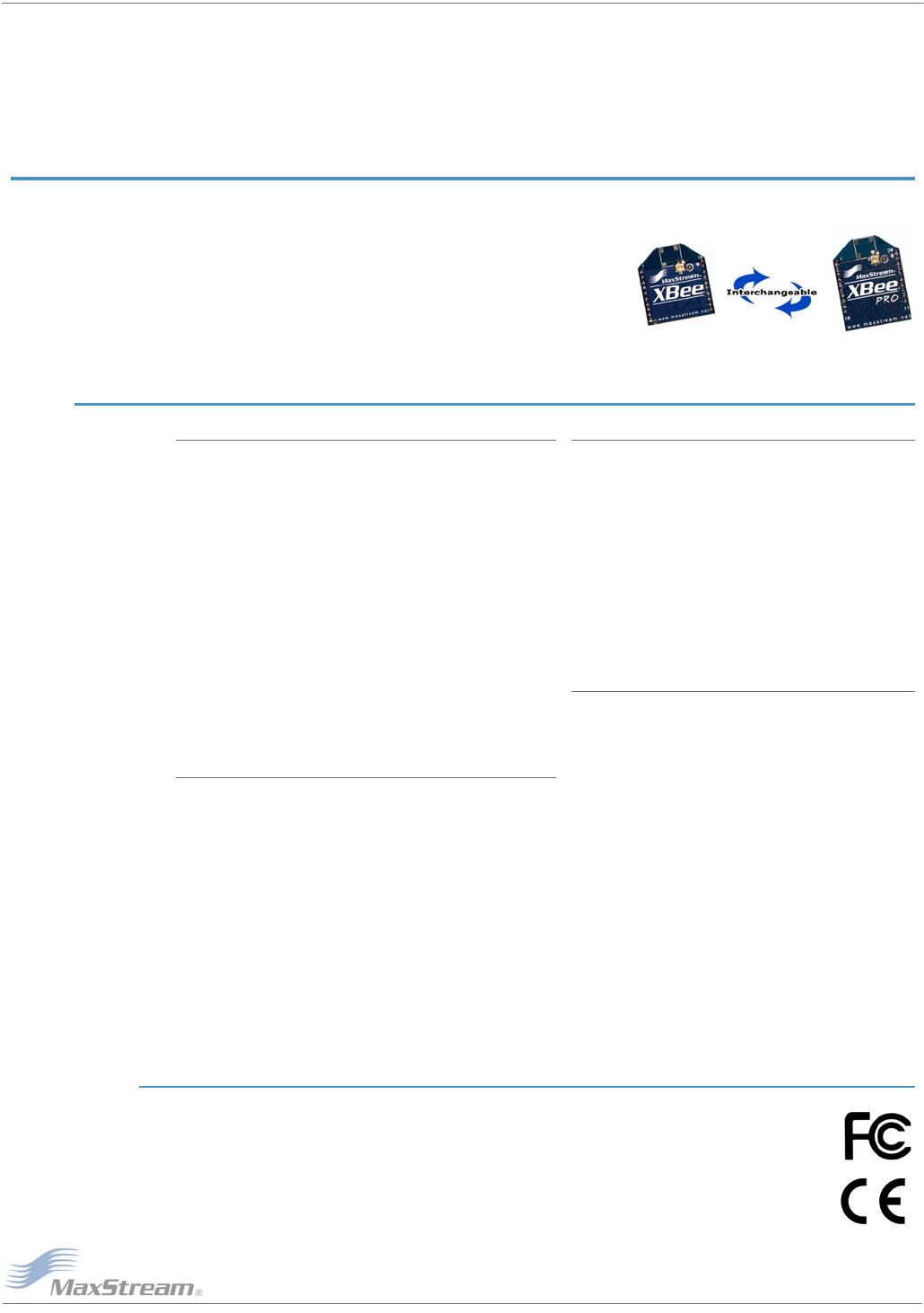
XBee™/XBee‐PROOEMRFModules–ProductManualv1.x7CBETA[2005.12.02]
©2005MaxStream,Inc.,Confidential&Proprietary‐AllRightsReserved 4
1.XBee/XBee‐PROOEMRFModules
XBee and XBee-PRO Modules were engineered to meet
ZigBee/IEEE 802.15.4 standards and support the unique
needs of low-cost, low-power wireless sensor networks.
The modules require minimal power and provide reliable
delivery of critical data between devices.
The modules operate within the ISM 2.4 GHz frequency
band and are pin-for-pin compatible with each other.
1.1. Key Features
High Performance, Low Cost
XBee
• Indoor/Urban: up to 100’ (30 m)
• Outdoor line-of-sight: up to 300’ (100 m)
• Transmit Power: 1 mW (0 dBm)
• Receiver Sensitivity: -92 dBm
XBee-PRO
• Indoor/Urban: up to 300’ (100 m)
• Outdoor line-of-sight: up to 1 mile (1500 m)
• Transmit Power: 100 mW (20 dBm) EIRP
• Receiver Sensitivity: -100 dBm
RF Data Rate: 250,000 bps
Advanced Networking & Security
Retries and Acknowledgements
DSSS (Direct Sequence Spread Spectrum)
Each direct sequence channels has over
65,000 unique network addresses available
Point-to-point, point-to-multipoint
and peer-to-peer topologies supported
128-bit Encryption (downloadable firmware
version coming soon)
Self-routing/Self-healing mesh networking
(downloadable firmware version coming soon)
Low Power
XBee
• TX Current: 45 mA (@3.3 V)
• RX Current: 50 mA (@3.3 V)
• Power-down Current: < 10 µA
XBee-PRO
• TX Current: 270 mA (@3.3 V)
• RX Current: 55 mA (@3.3 V)
• Power-down Current: < 10 µA
Easy-to-Use
No configuration necessary for out-of box
RF communications
Free X-CTU Software
(Testing and configuration software)
AT and API Command Modes for
configuring module parameters
Small form factor
Network compatible with other
ZigBee/802.15.4 devices
Free & Unlimited Technical Support
1.1.1. Worldwide Acceptance
FCC Approval (USA) Refer to Appendix A [p48] for FCC Requirements.
Systems that include XBee/XBee-PRO Modules inherit MaxStream’s Certifications.
ISM (Industrial, Scientific & Medical) 2.4 GHz frequency band
Manufactured under ISO 9001:2000 registered standards
XBee/XBee-PRO RF Modules are optimized for use in US, Canada, Australia, Israel
and Europe (contact MaxStream for complete list of approvals).
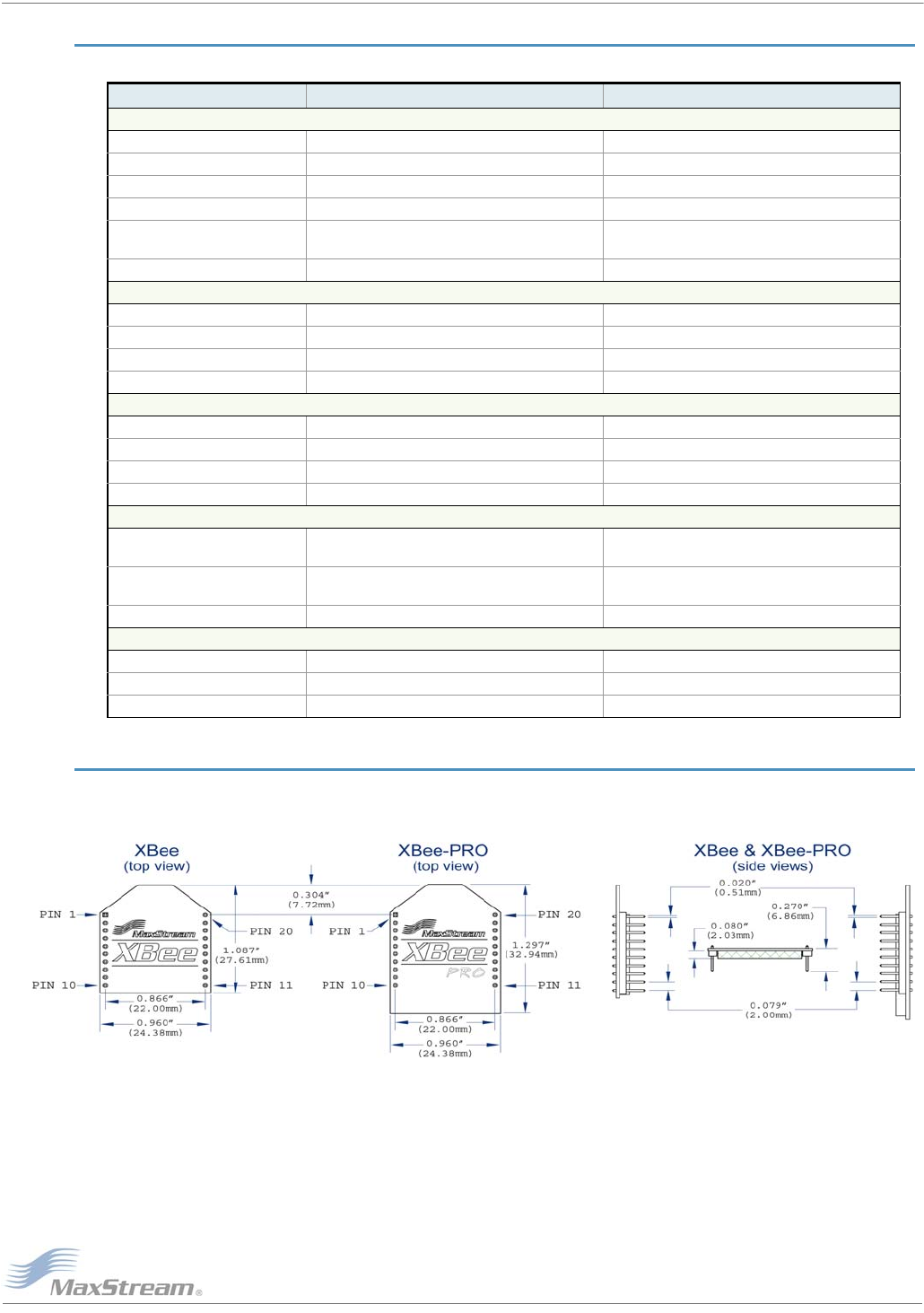
XBee™/XBee‐PROOEMRFModules–ProductManualv1.x7CBETA[2005.12.02]
©2005MaxStream,Inc.,Confidential&Proprietary‐AllRightsReserved 5
1.2. Specifications
1.3. Mechanical Drawings
Figure1‐01. MechanicaldrawingsoftheXBee/XBee‐PROOEMRFModules(antennaoptionsnotshown)
XBeeandXBee‐PRORFModulesarepin‐for‐pincompatible.
Table1‐01. SpecificationsoftheXBee/XBee‐PROOEMRFModules
Specification XBee XBee-Pro
Performance
Indoor/Urban Range up to 100 ft. (30 m) Up to 300’ (100 m)
Outdoor RF line-of-sight Range up to 300 ft. (100 m) Up to 1 mile (1500 m)
Transmit Power Output 1mW (0 dBm) 60 mW (18 dBm) conducted, 100 mW (20 dBm) EIRP
RF Data Rate 250,000 bps 250,000 bps
Interface Data Rate
(software selectable) 1200 - 115200 bps
(non-standard baud rates also supported) 1200 - 115200 bps
(non-standard baud rates also supported)
Receiver Sensitivity -92 dBm (1% packet error rate) -100 dBm (1% packet error rate)
Power Requirements
Supply Voltage 2.8 – 3.4 V 2.8 – 3.4 V
Transmit Current (typical) 45 mA (@ 3.3 V) 270 mA (@ 3.3 V)
Receive Current (typical) 50 mA (@ 3.3 V) 55 mA (@ 3.3 V)
Power-down Current < 10 µA < 10 µA
General
Operating Frequency ISM 2.4 GHz ISM 2.4 GHz
Dimensions 0.960” x 1.087” (2.438cm x 2.761cm) 0.960” x 1.297” (2.438cm x 3.294cm)
Operating Temperature -40 to 85º C (industrial) -40 to 85º C (industrial)
Antenna Options U.FL Connector, Chip Antenna or Whip Antenna U.FL Connector, Chip Antenna or Whip Antenna
Networking & Security
Supported Network Topologies Point-to-Point, Point-to-Multipoint,
Peer-to-Peer and Mesh (coming soon) Point-to-Point, Point-to-Multipoint,
Peer-to-Peer and Mesh (coming soon)
Number of Channels
(software selectable) 16 Direct Sequence Channels 13 Direct Sequence Channels
Filtration Options PAN ID, Channel and Source/Destination Addresses PAN ID, Channel and Source/Destination Addresses
Agency Approvals
FCC Part 15.247 OUR-XBEE pending
Industry Canada (IC) pending pending
Europe pending pending
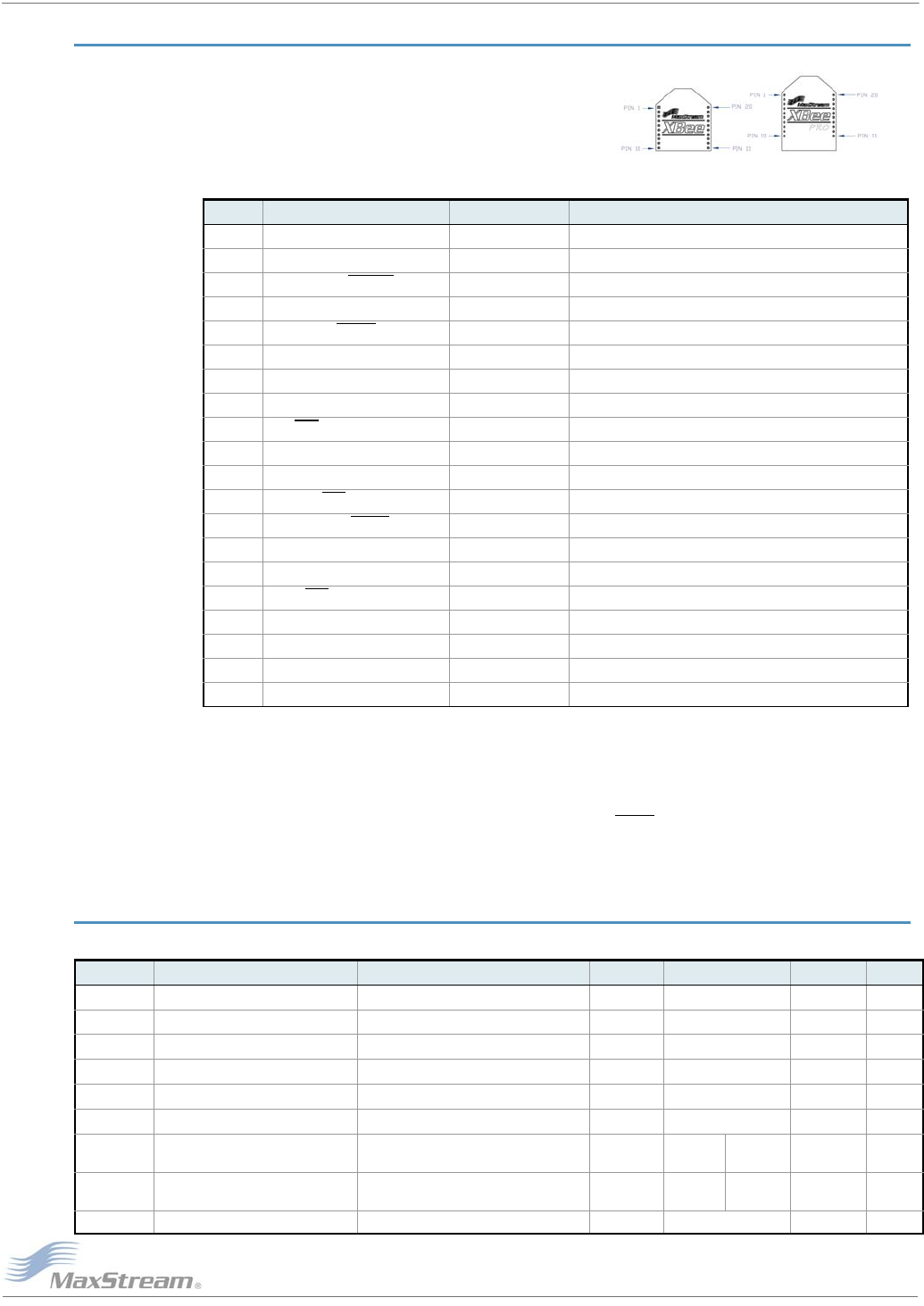
XBee™/XBee‐PROOEMRFModules–ProductManualv1.x7CBETA[2005.12.02]
©2005MaxStream,Inc.,Confidential&Proprietary‐AllRightsReserved 6
1.4. Pin Signals
Figure1‐02. XBee/XBee‐PRORFModulePinNumber
(topsidesshown‐shieldsonbottom)
*Functionsnotsupportedatthetimeofthisrelease.
Design Notes:
• Minimum connections are: VCC, GND, DOUT and DIN.
• Signal Direction is specified with respect to the module
• Module includes a 50k Ω pull-up resistor attached to RESET
• Several input pull-ups can be configured using the PE command
• Unused pins should be left disconnected
1.5. Electrical Characteristics
Table1‐02. PinAssignmentsfortheXBeeandXBee‐PROModules
(Low‐assertedsignalsaredistinguishedwithahorizontallineabovesignalname.)
Pin # Name Direction Description
1 VCC - Power supply
2 DOUT Output UART Data Out
3 DIN / CONFIG Input UART Data In
4 CD* / DOUT_EN* / DO8* Output Carrier Detect, TX_enable or Digital Output 8
5RESET Input Module Reset
6 PWM0 / RSSI Output PWM Output 0 or RX Signal Strength Indicator
7 [reserved] - Do not connect
8 [reserved] - Do not connect
9DTR
/ SLEEP_RQ / DI8 Input Pin Sleep Control Line or Digital Input 8
10 GND - Ground
11 RF_TX* / AD4* / DIO4* Either Transmission Indicator, Analog Input 4 or Digital I/O 4
12 CTS / DIO7* Either Clear-to-Send Flow Control or Digital I/O 7
13 ON / SLEEP Output Module Status Indicator
14 VREF* Input Voltage Reference for A/D Inputs
15 Associate / AD5* / DIO5* Either Associated Indicator, Analog Input 5 or Digital I/O 5
16 RTS / AD6* / DIO6* Either Request-to-Send Flow Control, Analog Input 6 or Digital I/O 6
17 COORD_SEL* / AD3* / DIO3* Either Analog Input 3, Digital I/O 3 or Coordinator Select
18 AD2* / DIO2* Either Analog Input 2 or Digital I/O 2
19 AD1* / DIO1* Either Analog Input 1 or Digital I/O 1
20 AD0* / DIO0* Either Analog Input 0 or Digital I/O 0
Table1‐03. DCCharacteristicsoftheXBee&XBee‐PRO(VCC=2.8‐3.4VDC)
Symbol Parameter Condition Min Typical Max Units
VIL Input Low Voltage All Digital Inputs - - 0.35 * VCC V
VIH Input High Voltage All Digital Inputs 0.7 * VCC - - V
VOL Output Low Voltage IOL = 2 mA, VCC >= 2.7 V --0.5V
VOH Output High Voltage IOH = -2 mA, VCC >= 2.7 V VCC - 0.5 - - V
IIIN Input Leakage Current VIN = VCC or GND, all inputs, per pin -0.0251uA
IIOZ High Impedance Leakage Current VIN = VCC or GND, all I/O High-Z, per pin -0.0251uA
TX Transmit Current VCC = 3.3 V - 45
(XBee) 270
(PRO) -mA
RX Receive Current VCC = 3.3 V - 50
(XBee) 55
(PRO) -mA
PWR-DWN Power-down Current SM parameter = 1 - < 10 - uA
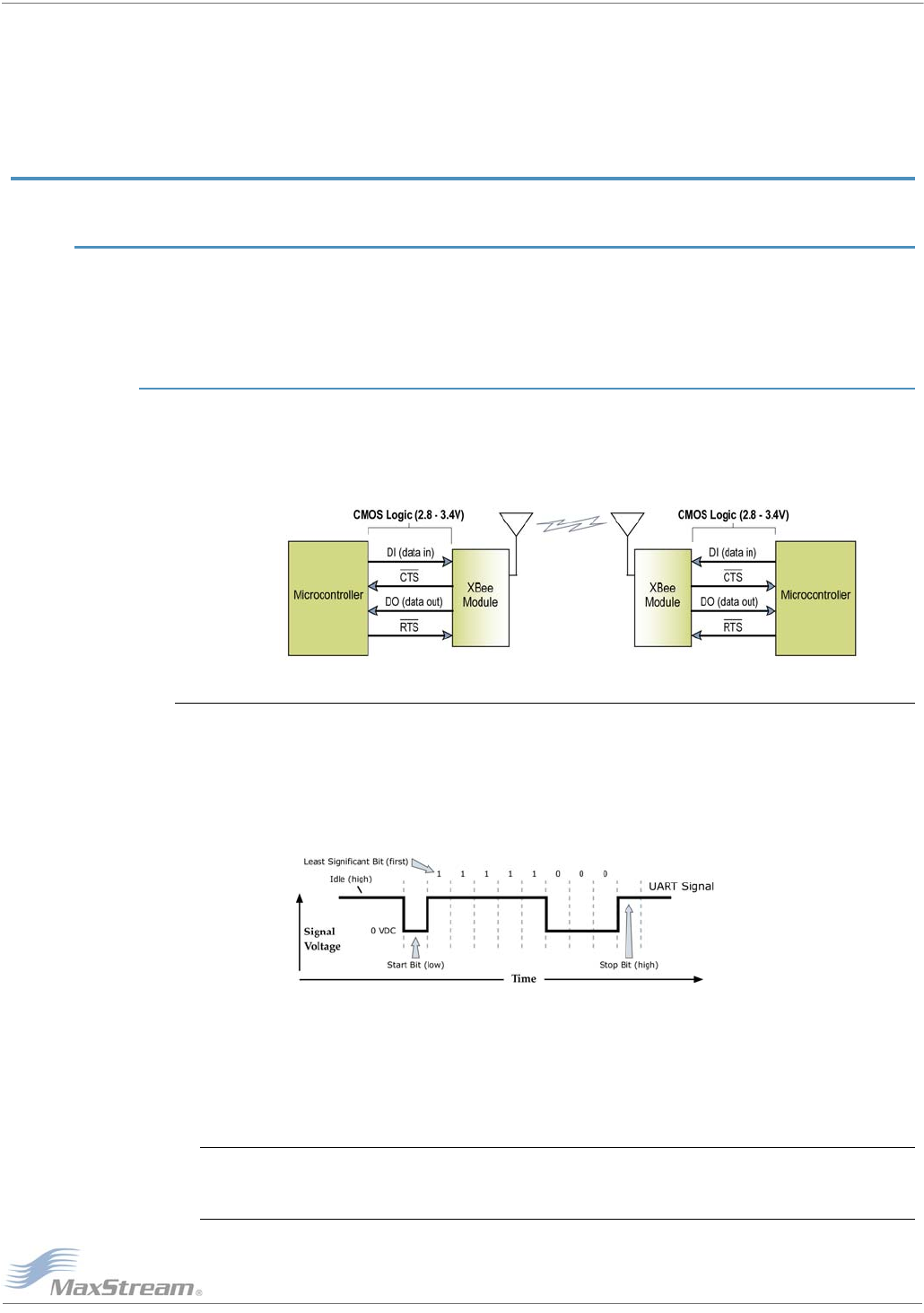
XBee™/XBee‐PROOEMRFModules–ProductManualv1.x7CBETA[2005.12.02]
©2005MaxStream,Inc.,Confidential&Proprietary‐AllRightsReserved 7
2.RFModuleOperation
2.1. Serial Communications
The XBee/XBee-PRO OEM RF Modules interface to a host device through a logic-level asynchro-
nous serial port. Through its serial port, the module can communicate with any logic and voltage
compatible UART; or through a level translator to any serial device (For example: RS-232/485/
422 or USB interface board).
2.1.1. UART Data Flow
Devices that have a UART interface can connect directly to the pins of the RF module as shown in
the figure below.
Figure2‐01. SystemDataFlowDiagraminaUART‐interfacedenvironment
(Low‐assertedsignalsdistinguishedwithhorizontallineoversignalname.)
Serial Data
Data enters the module UART through the DI pin (pin 3) as an asynchronous serial signal. The sig-
nal should idle high when no data is being transmitted.
Each data byte consists of a start bit (low), 8 data bits (least significant bit first) and a stop bit
(high). The following figure illustrates the serial bit pattern of data passing through the module.
Figure2‐02. UARTdatapacket0x1F(decimalnumberʺ31ʺ)astransmittedthroughtheRFmodule
ExampleDataFormatis8‐N‐1(bits‐parity‐#ofstopbits)
The module UART performs tasks, such as timing and parity checking, that are needed for data
communications. Serial communications depend on the two UARTs to be configured with compati-
ble settings (baud rate, parity, start bits, stop bits, data bits).
Both the module and host (PC) settings can be viewed and adjusted using MaxStream's propri-
etary X-CTU Software. Use the "PC Settings" tab to configure host settings. Use the "Terminal" or
"RF Module Configuration" tab to configure the module settings.
NOTE: Failure to enter AT Command Mode is most commonly due to baud rate mismatch. Ensure the
‘Baud’ setting on the “PC Settings” tab matches the interface data rate of the RF module (by default, BD
parameter = 3 (9600 bps)).
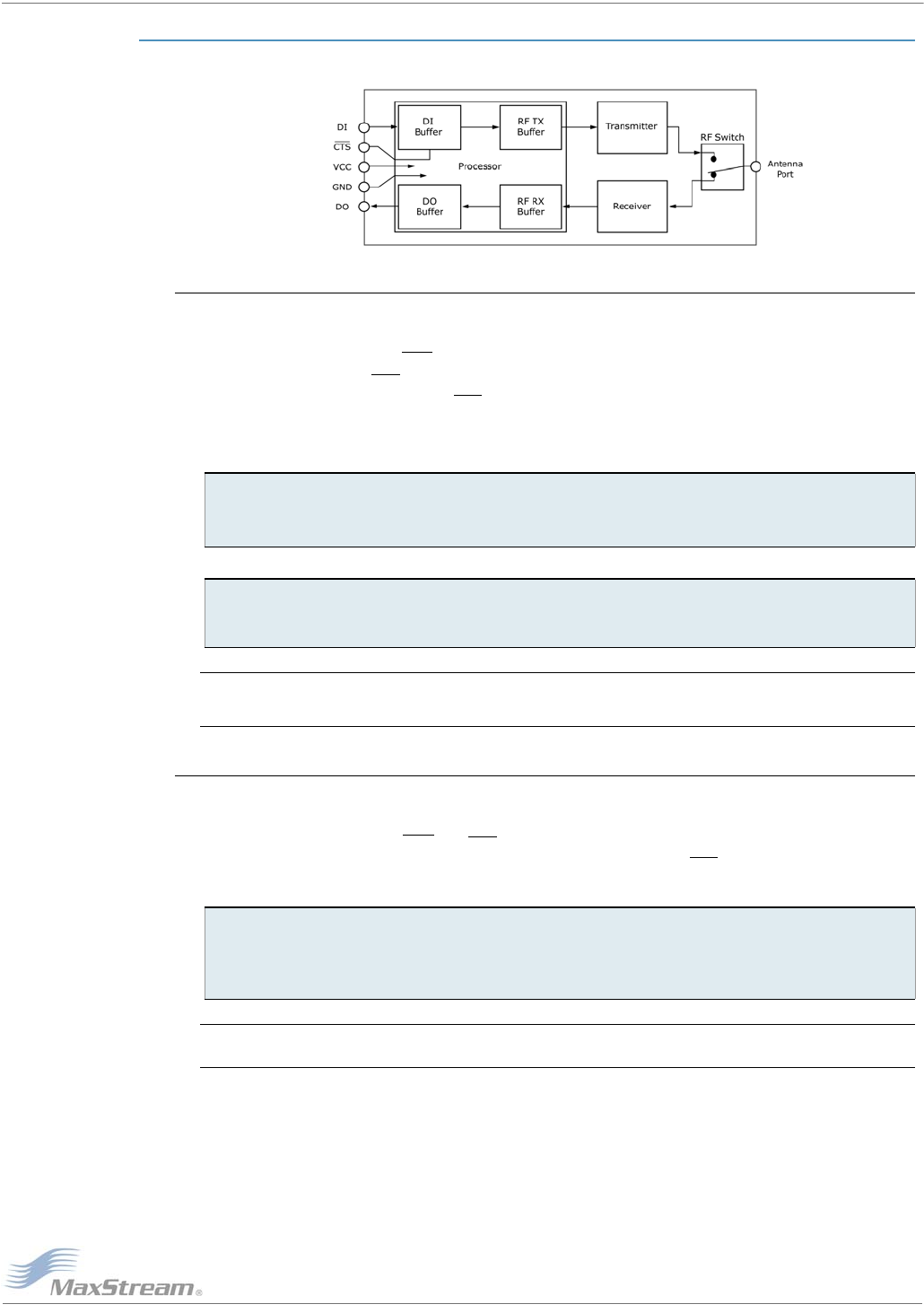
XBee™/XBee‐PROOEMRFModules–ProductManualv1.x7CBETA[2005.12.02]
©2005MaxStream,Inc.,Confidential&Proprietary‐AllRightsReserved 8
2.1.2. Flow Control
Figure2‐03. InternalDataFlowDiagram
DI (Data In) Buffer
When serial data enters the RF module through the DI pin (pin 3), the data is stored in the DI
Buffer until it can be processed.
Hardware Flow Control (CTS). When the DI buffer is 17 bytes away from being full; by default,
the module de-asserts CTS (high) to signal to the host device to stop sending data [refer to D7
(DIO7 Configuration) parameter]. CTS is re-asserted after the DI Buffer has 34 bytes of memory
available.
How to eliminate the need for flow control:
Case in which the DI Buffer may become full and possibly overflow:
Refer to the RO (Packetization Timeout) [p38], BD (Baud Rate) [p30] and D7 (DIO7 Configuration) [p33]
command descriptions for more information.
DO (Data Out) Buffer
When RF data is received, the data enters the DO buffer and is sent out the serial port to a host
device. Once the DO Buffer reaches capacity, any additional incoming RF data is lost.
Hardware Flow Control (RTS). If RTS is enabled for flow control (D6 (DIO6 Configuration)
Parameter = 1), data will not be sent out the DO Buffer as long as RTS (pin 16) is de-asserted.
Two cases in which the DO Buffer may become full and possibly overflow:
Refer to the D6 (DIO6 Configuration) [p33] command description for more information.
1. Send messages that are smaller than the DI buffer size.
2. Interface at a lower baud rate [BD (Interface Data Rate) parameter] than the throughput
data rate.
If the module is receiving a continuous stream of RF data, any serial data that arrives on the DI
pin is placed in the DI Buffer. The data in the DI buffer will be transmitted over-the-air when the
module is no longer receiving RF data in the network.
1. If the RF data rate is set higher than the interface data rate of the module, the module will
receive data from the transmitting module faster than it can send the data to the host.
2. If the host does not allow the module to transmit data out from the DO buffer because of
being held off by hardware or software flow control.
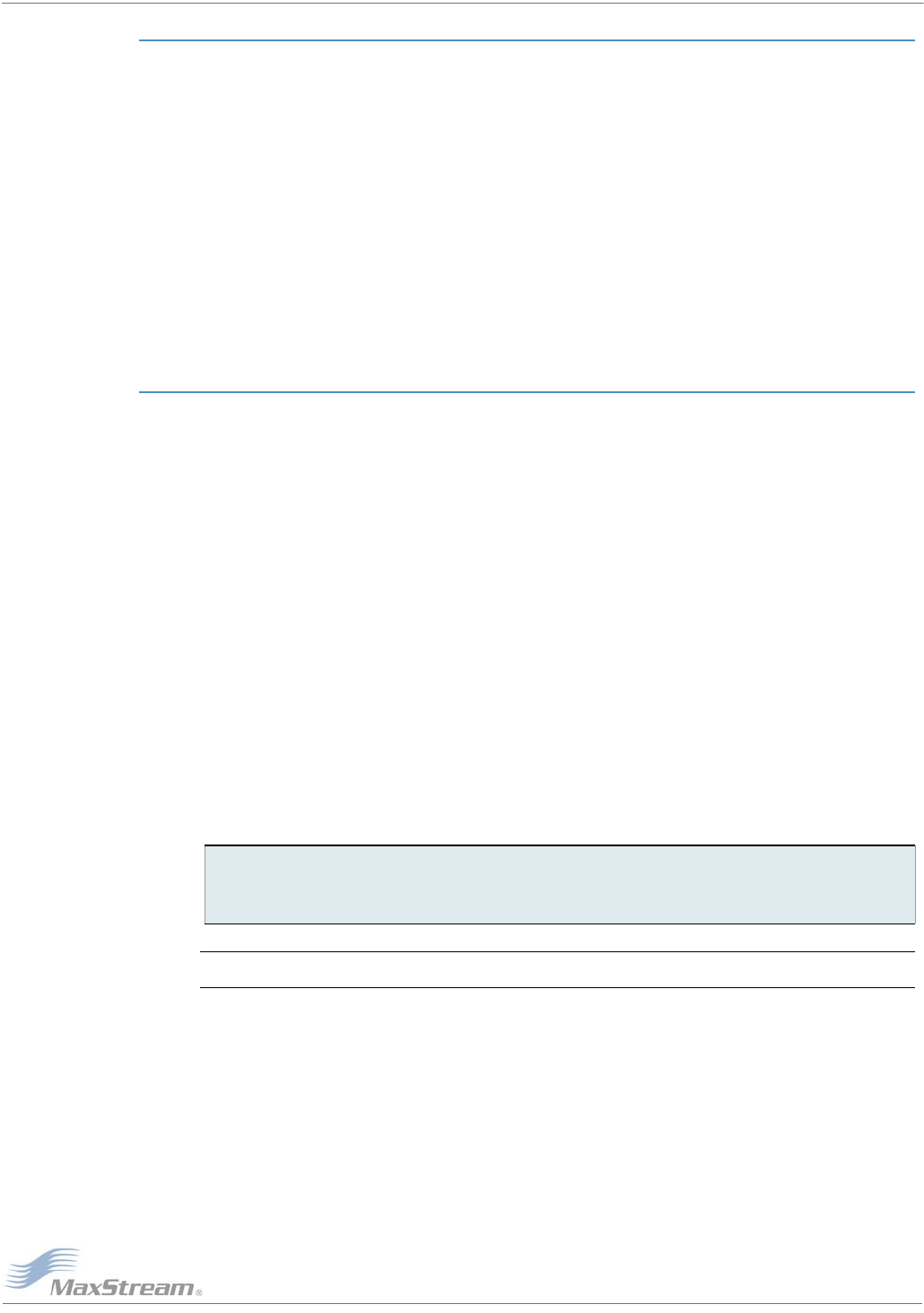
XBee™/XBee‐PROOEMRFModules–ProductManualv1.x7CBETA[2005.12.02]
©2005MaxStream,Inc.,Confidential&Proprietary‐AllRightsReserved 9
2.1.3. Transparent Operation
By default, XBee/XBee-PRO RF Modules operate in Transparent Mode. When operating in this
mode, the modules act as a serial line replacement - all UART data received through the DI pin is
queued up for RF transmission. When RF data is received, the data is sent out the DO pin.
When the RO (Packetization Timeout) parameter threshold is satisfied [refer to RO command
description], the module attempts to initialize an RF transmission. If the module cannot immedi-
ately transmit (for instance, if it is already receiving RF data), the serial data continues to be
stored in the DI Buffer. Data is packetized and sent at any RO timeout or when 100 bytes (maxi-
mum packet size) are received.
The module operates as described above unless the Command Mode Sequence is detected. The
Command Mode Sequence consists of three copies of the command sequence character [CC
parameter] surrounded by before and after guard times [GT parameter].
If the DI buffer becomes full, hardware or software flow control must be implemented in order to
prevent overflow (loss of data between the host and module).
2.1.4. API Operation
API (Application Programming Interface) Operation is an alternative to the default Transparent
Operation. The frame-based API extends the level to which a host application can interact with the
networking capabilities of the module.
When in API mode, all data entering and leaving the module is contained in frames that define
operations or events within the module.
Transmit Data Frames (received through the DI pin (pin 3)) include:
• RF Transmit Data Frame
• Command Frame (equivalent to AT commands)
Receive Data Frames (sent out the DO pin (pin 2)) include:
• Showing a received RF packet
• A response to a command
• Showing events such as reset, associate, disassociate, etc.
The API provides alternative means of configuring modules and routing data at the host applica-
tion layer. A host application can send data frames to the module that contain address and pay-
load information instead of using command mode to modify addresses. The module will send data
frames to the application containing status packets; as well as source, RSSI and payload informa-
tion from received data packets.
The API operation option facilitates many operations such as the examples cited below:
To implement API operations, refer to API sections [p43].
-> Change destination addresses without having to enter command mode
-> Receive success/failure status of each RF packet
-> Identify the source address of each received packet
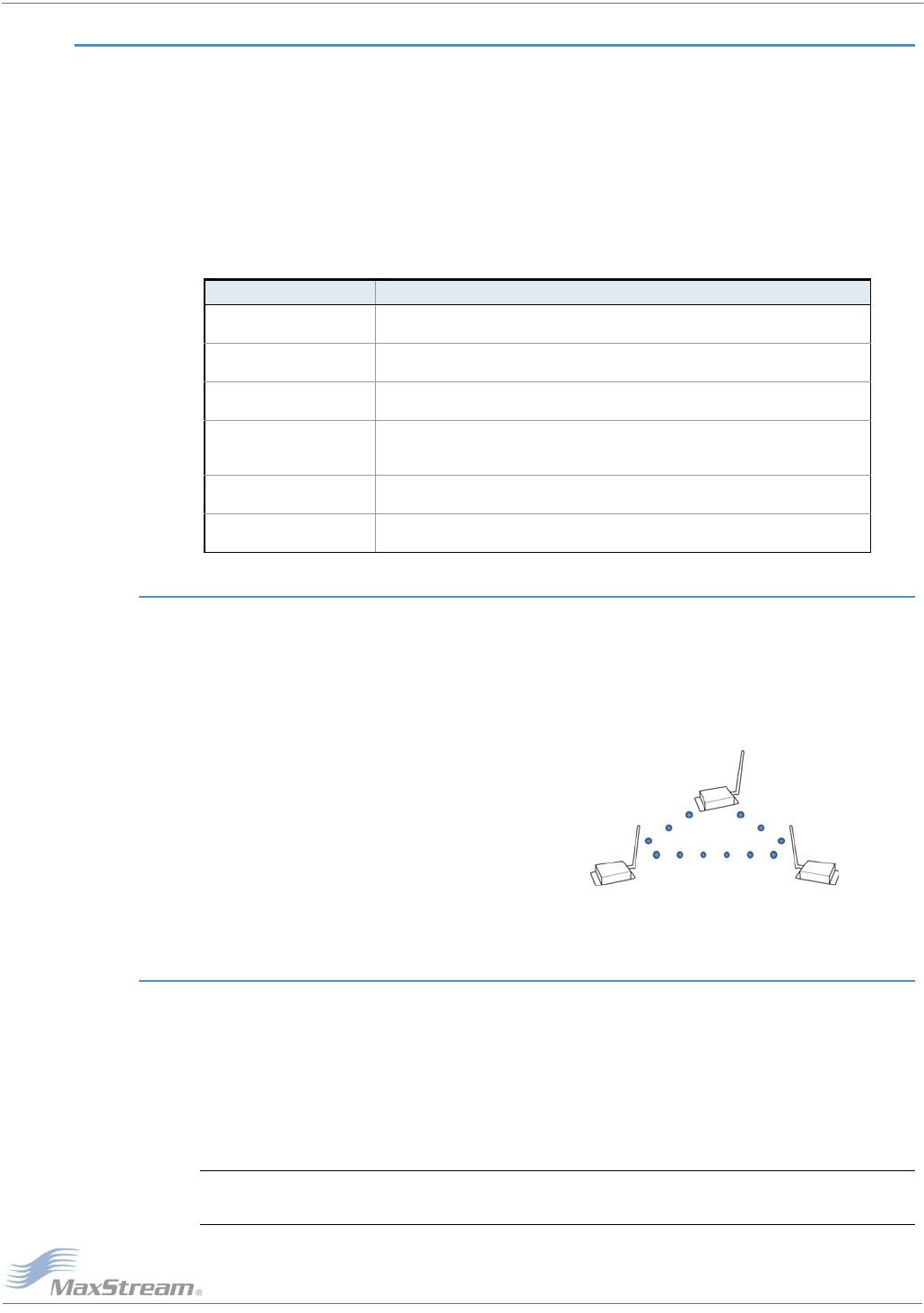
XBee™/XBee‐PROOEMRFModules–ProductManualv1.x7CBETA[2005.12.02]
©2005MaxStream,Inc.,Confidential&Proprietary‐AllRightsReserved 10
2.2. Networking Systems
NonBeacon and Beacon-enabled systems require different firmware versions be loaded to the
module. Both firmware versions can be loaded to the module using MaxStream’s X-CTU Software.
The available configurations operate within the following networking system types:
•NonBeacon
• NonBeacon (w/ Coordinator)*
•Beacon-enabled*
*Networkingsystemtypesnotsupportedatthetimeofthisrelease(v1.x7CBETA)
The following terms will be used to explicate the networking system types:
2.2.1. NonBeacon
By default, XBee/XBee-PRO RF Modules are configured to support NonBeacon (no Coordinator)
communications. NonBeacon systems operate within a Peer-to-Peer network topology and are not
dependent upon Master/Slave relationships. This means that modules remain synchronized with-
out use of master/server configurations and each module in the network shares both roles of mas-
ter and slave. MaxStream's peer-to-peer architecture features fast synchronization times and fast
cold start times. This default configuration accommodates a wide range of RF data applications.
Figure2‐04. NonBeaconPeer‐to‐PeerArchitecture
A peer-to-peer network can be established by
configuring each module to operate as an End Device (CE = 0), disabling End Device Association
on all modules (A1 = 0) and setting ID and CH parameters to be identical across the network.
2.2.2. NonBeacon (w/ Coordinator)
A device is configured as a Coordinator by setting the CE (Coordinator Enable) parameter to “1”.
Coordinator power-up is governed by the A2 (Coordinator Association) command.
In a NonBeacon (w/ Coordinator) system, the Coordinator can be configured to use direct or indi-
rect transmissions. If the SP (Cyclic Sleep Period) parameter is set to “0”, the Coordinator will
send data immediately. Otherwise, the SP parameter determines the length of time the Coordina-
tor will retain the data before discarding it. Generally, SP (Cyclic Sleep Period) and ST (Time
before Sleep) parameters should be set to match the SP and ST settings of the End Devices.
Association plays a critical role in the implementation of a NonBeacon (w/ Coordinator) system. Refer
to the Association section [p12] for more information.
Table2‐01. Termsanddefinitions(Applicablenetworkingsystemtypesaredesignatedwithin<brackets>.)
Term Definition
Active Period <Beacon-enabled systems only> A period of time that follows a beacon in which wireless data
communication can take place within a PAN.
Association <Beacon-enabled and NonBeacon (w/ Coordinator) systems only>
The establishment of membership between End Devices and a Coordinator.
Beacon <Beacon-enabled systems only> Transmissions used to synchronize networked RF modules,
identify the PAN and describe the structure of the superframes.
Coordinator <Beacon-enabled and NonBeacon (w/ Coordinator) systems only>
A central RF module that is configured to provide synchronization services through the
transmission of beacons.
End Device When in the same network as a Coordinator - RF modules that rely on a Coordinator for
synchronization and can be put into states of sleep for low-power applications.
PAN Personal Area Network - A data communication network that includes one or more End
Devices and optionally a Coordinator.
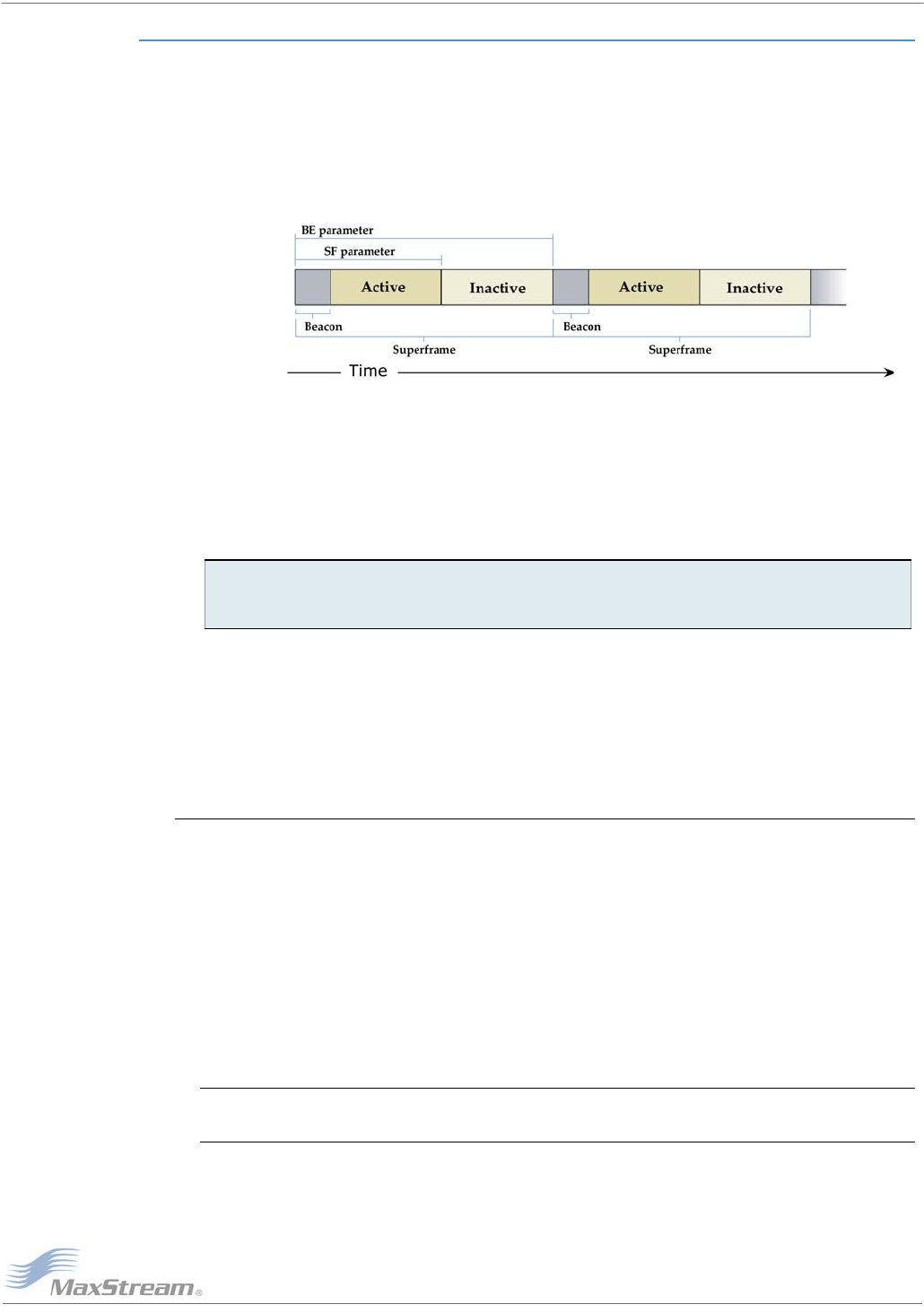
XBee™/XBee‐PROOEMRFModules–ProductManualv1.x7CBETA[2005.12.02]
©2005MaxStream,Inc.,Confidential&Proprietary‐AllRightsReserved 11
2.2.3. Beacon-enabled
A Beacon-enabled network relies upon a Coordinator that sends a periodic beacon to all devices in
the network. The beacon is used to synchronize communications with End Devices and determine
wake periods.
Beacon-enabled networks are governed by the Beacon Order and active Superframe Order (BE
and SF parameters respectively) as defined by the Coordinator. All transmissions between the
Coordinator and End Device(s) must occur during the active portion of the Superframe.
Figure2‐05. Beacon&SuperframeOrder(relativetotime)
The period between successive beacons is bound by a Superframe. Each superframe period con-
tains an Active and Inactive period. The SF command specifies the Active portion of the Super-
frame. If SF = BE, there is no Inactive period. If SF < BE, an Inactive period exists.
Durations of time are determined by the following formulas:
• Actual time is calculated from BE as: Time (msec) = (2 ^ BE) * 15.36 ms
• Actual Active Period time is calculated from SF as: Time (msec) = (2 ^ SF) * 15.36 ms.
Proper settings of the BE and SF parameters are application specific.
Beacon-enabled communications are contention-based. This means a module will only transmit if
it first detects that no other transmissions are present.
End devices always use indirect messaging [refer to “Indirect Transmission” section, p16] and End
devices will always sleep during inactive periods.
For more information, refer to the BE and SF command descriptions ([p31] and [p40] respec-
tively).
In Relation to Cyclic Sleep Configurations
End Devices can be configured to sleep during the Inactive period of the Superframe. This requires
the End Device be configured to operate as a Cyclic Sleep Remote [SM (Sleep Mode) parameter =
4) and SP (Cyclic Sleep Period) = 0].
In this scenario, the End Device will wake for each beacon to determine if the Coordinator is hold-
ing a message for it. If a message exists, it will poll the Coordinator to extract the data. Alterna-
tively, End Devices can sleep through multiple beacons. For example, with BE = 4 (245 ms), and
SF = 1 (30.7 ms), an End Device could be configured to wake every 9th beacon (2.2 sec) by set-
ting SP = 9. Note that SP on the Coordinator should match the highest SP on any End Device since
the Coordinator’s SP parameter determines the number of beacons that a Coordinator will hold a
message for an End Device to poll it. If sleeping through multiple beacons, the End Device will be
awake for at least one full beacon period before returning to sleep.
Sleep Modes and Association play critical roles in the implementation of a Beacon-enabled system.
Refer to the Sleep Mode [p18] and Association [following paragraph] sections for more information.
For example: A sensor may need to relay a few bytes of information every 4 minutes. A proper
configuration for such a scenario would set BE = 14 (4.19 min), SF = 1 (30.7 ms). Thus, after
each periodic beacon, transmissions may occur in a 30.7ms window; then the radios are silent.
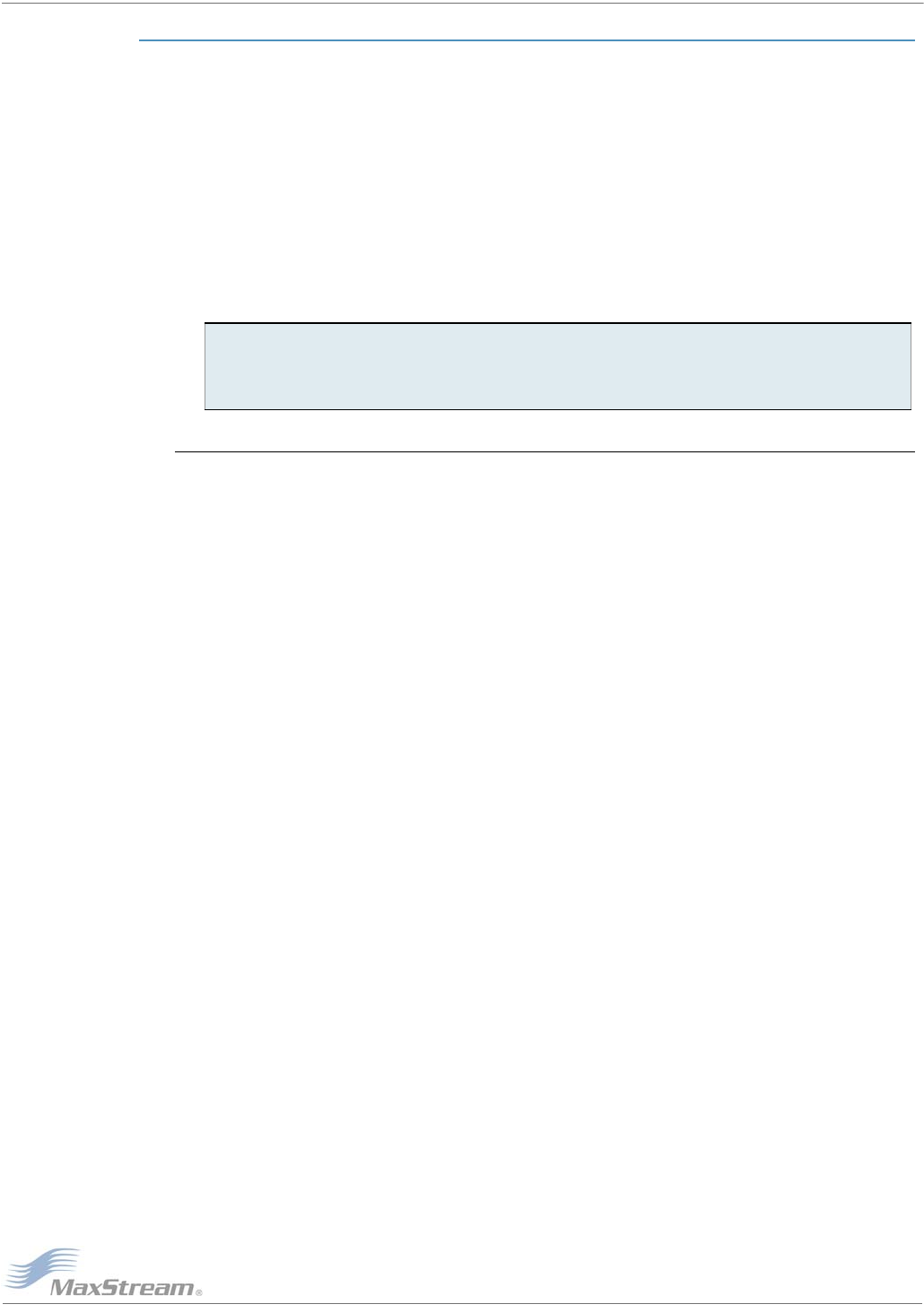
XBee™/XBee‐PROOEMRFModules–ProductManualv1.x7CBETA[2005.12.02]
©2005MaxStream,Inc.,Confidential&Proprietary‐AllRightsReserved 12
2.2.4. Association
Association is the establishment of membership between End Devices and a Coordinator. It is only
applicable in Beacon-enabled and NonBeacon (w/ Coordinator) systems. The establishment of
membership is useful in scenarios that require a central unit (Coordinator) to relay messages to or
gather messages from several remote units (End Devices), assign channels or assign PAN IDs.
An RF data network that consists of one Coordinator and one or more End Devices forms a PAN
(Personal Area Network). Each device in a PAN has a PAN Identifier [ID (PAN ID) parameter]. PAN
IDs must be unique to prevent miscommunication between PANs. The Coordinator PAN ID is set
using the ID (PAN ID) and A2 (Coordinator Association) commands.
An End Device can associate to a Coordinator without knowing the address, PAN ID or channel of
the Coordinator. The A1 (End Device Association) parameter bit fields determine the flexibility of
an End Device during association. The A1 parameter can be used for an End Device to dynamically
set its destination address, PAN ID and/or channel.
Coordinator and End Device Setup and Operation
To configure a module to operate as a Coordinator, set the CE (Coordinator Enable) parameter to
‘1’. Set the CE parameter of End Devices to ‘0’ (default). Coordinator and End Devices should con-
tain matching firmware versions (Beacon-enabled or NonBeacon).
Beacon-enabled Systems
If an End Device contains Beacon-enabled firmware and the AutoAssociate bit of the A1 (End
Device Association Options) parameter is set, the End Device will attempt to associate to a bea-
coning Coordinator. To ensure the Coordinator is detected, set the SD (Scan Duration) parameter
to be equal to or greater than the BE (Beacon Order) parameter of the Coordinator.
The frequency of beacons is determined by the BE (Beacon Order) parameter. End Devices can be
configured to sleep through multiple beacons or wake on every beacon. An ‘active period’ exists
after each beacon where communications can take place throughout the PAN. Communication
cannot take place outside of this active period. The active period after each beacon is determined
by the SF (Superframe) parameter. For example, if BE = 8 and SF = 2, beacons will be sent out
every 3.93 seconds and an active period of 61 ms exists after every beacon.
When a beaconing Coordinator receives data for an End Device, it will retain the message until the
End Device requests the data. This is called an ‘indirect transmission’. The beaconing Coordinator
will add the destination address of the message to the pending addresses field of the beacon. If an
End Device receives the beacon and finds its address included in the beacon, it will request the
data from the Coordinator. The Coordinator will only retain an indirect message for SP (Cyclic
Sleep Period) beacons. Refer to the Sleep Mode sections for more information [p18].
Consider the following guidelines when configuring a beaconing Coordinator:
• Set the SP (Cyclic Sleep Period) parameter to the largest SP setting of any End Device in the
PAN. (SP parameter determines the number of beacons that an End Device will sleep through
and thus, the number of beacons the Coordinator should retain an Indirect Message.)
• The ID (PAN ID) and CH (Channel) settings should be configured in conjunction with the A2
(Coordinator Association) parameter setting.
• If multiple Coordinators exist, the CD (Scan Duration) parameter should be set at least to the
largest BE value of any Coordinator that is expected to be operating in the area of the coordi-
nator that is being configured.
NonBeacon (w/ Coordinator) Systems
In a NonBeacon (w/ Coordinator) system, the Coordinator can be configured to use direct or indi-
rect transmissions. If the SP (Cyclic Sleep Period) parameter is set to ‘0’, the Coordinator will send
data immediately. Otherwise, the SP parameter determines the length of time the Coordinator will
retain the data before discarding it. Generally, SP (Cyclic Sleep Period) and ST (Time before Sleep)
parameters should be set to match the SP and ST settings of the End Devices.
For example: If the PAN ID of a Coordinator is known, but the operating channel is not; the A1
command on the End Device should be set to enable the ‘Auto_Associate’ and
‘Reassign_Channel’ bits. Additionally, the ID parameter should be set to match the PAN ID of
the associated Coordinator.

XBee™/XBee‐PROOEMRFModules–ProductManualv1.x7CBETA[2005.12.02]
©2005MaxStream,Inc.,Confidential&Proprietary‐AllRightsReserved 13
Coordinator Power-up
Coordinator power-up is governed by the A2 (Coordinator Association) command. On power up,
the Coordinator undergoes the following sequence of events:
1. Check A2 - Reassign_PANID Flag
Set - The Coordinator issues an Active Scan. The Active Scan selects one channel and transmits
a beacon request command to the broadcast address (0xFFFF) and broadcast PAN ID (0xFFFF).
It then listens on that channel for beacons from any Coordinator operating on that channel. The
listen time on each channel is determined by the SD (Scan Duraction) Parameter value. (To
ensure detection of all operating PANs, it is essential that SD be equal to the highest beacon
order (BE) of any beaconing Coordinators expected to be found.) Once the time expires on that
channel, the Active Scan selects another channel and again transmits the beacon request com-
mand as before. This process continues until all channels have been scanned, or until 5 PANs
have been discovered. When the Active Scan is complete, the results include a list of PAN IDs
and Channels that are being used by other PANs. This list is used to assign an unique PAN ID to
the new Coordinator. The ID parameter will be retained if it is not found in the Active Scan
results. Otherwise, the ID (PAN ID) parameter setting will be updated to a PAN ID that was not
detected.
Not Set - The Coordinator retains its ID setting. No active scan is performed.
2. Check A2 - Reassign_Channel Flag
Set - The Coordinator issues an Energy Scan. The Energy Scan selects one channel and scans
for energy on that channel. The duration of the scan is specified by SD. Once the scan is com-
pleted on a channel, the Energy Scan selects the next channel and begins a new scan on that
channel. This process continues until all channels have been scanned. When the Energy Scan is
complete, the results include the maximal energy values detected on each channel. This list is
used to determine a channel where the least energy was detected. If an Active Scan was per-
formed (Reassign_PANID Flag set), the channels used by the detected PANs are eliminated as
possible channels. Thus, the results of the Energy Scan and the Active Scan (if performed) are
used to find the best channel (channel with the least energy that is not used by any detected
PAN). Once the best channel has been selected, the CH (Channel) parameter value is updated
to that channel.
Not Set - The Coordinator retains its CH setting. No energy scan is performed.
3. Start Coordinator
The Coordinator starts on the specified channel (CH) and PAN ID (ID). Note, these may be
selected in steps 1 and/or 2 above. If Beaconing code is used, the Coordinator will start with the
specified Beacon Order (BE) and Superframe Order (SF). The Coordinator will only allow End
Devices to associate to it if the A2 - Allow_Association flag is set. Once the Coordinator has suc-
cessfully started, the Associate LED will blink 1x per second. (The LED is solid if the Coordinator
has not started.)
4. Coordinator Changes
Once a Coordinator has started, changing A2 (Reassign_Channel or Reassign_PANID bits), ID,
CH, MY, or BE/SF (for Beaconing Coordinator) will cause the Coordinator to restart. Changing
the A2 Allow_Association bit will not restart the Coordinator. In a non-beaconing system, any
End Devices that associated to the Coordinator prior to a Restart will not be alerted to the Coor-
dinator restart. Thus, if the Coordinator were to change its ID, CH, or MY settings, the End
Devices would no longer be able to communicate with the non-beacon Coordinator. Once a
Coordinator has started, the ID, CH, MY, or A2 (Reassign_Channel or Reassign_PANID bits)
should not be changed.

XBee™/XBee‐PROOEMRFModules–ProductManualv1.x7CBETA[2005.12.02]
©2005MaxStream,Inc.,Confidential&Proprietary‐AllRightsReserved 14
End Device Power-up
On power-up, the End Device undergoes the following sequence:
1. Check A1 - Auto-Associate Bit
Set - The End Device will attempt to associate to a Coordinator. (See steps 2-3).
Not Set - The End Device will not attempt to associate to a Coordinator. The End Device will
operate as specified by ID, CH, MY, etc. Association is considered complete, and the Associate
LED will blink quickly (5x per second). In this case, the remaining steps (2-3) do not apply.
2. Discover Coordinator (if Auto-Associate Bit Set)
The End Device issues an Active Scan. The Active Scan selects one channel and transmits a
beacon request command to the broadcast address (0xFFFF) and broadcast PAN ID (0xFFFF). It
then listens on that channel for beacons from any Coordinator operating on that channel. The
listen time on each channel is determined by SD. (To ensure detection of all operating PANs, it
is essential that SD be equal to the highest beacon order (BE) of any beaconing Coordinators.)
Once the time expires on that channel, the Active Scan selects another channel and again
transmits the beacon request command as before. This process continues until all channels
have been scanned, or until 5 PANs have been discovered. When the Active Scan is complete,
the results include a list of PAN IDs and Channels that are being used by detected PANs. The
End Device selects a Coordinator to associate with according to the A1 Reassign_PANID and
Reassign_Channel flags:
• Reassign_PANID Bit Set- The End Device can associate with a PAN with any ID value.
• Reassign_PANID Bit Not Set- The End Device will only associate with a PAN whose ID setting
matches the ID setting of the End Device.
• Reassign_Channel Bit Set- The End Device can associate with a PAN with any CH value.
• Reassign_Channel Bit Not Set- The End Device will only associate with a PAN whose CH set-
ting matches the CH setting of the End Device.
After applying these filters to the discovered Coordinators, if multiple candidate PANs exist, the
End Device will select the PAN whose transmission link quality is the strongest. If no valid Coor-
dinator is found, the End Device will wait for a random delay (value between 0 and AR hun-
dredths of a second) and then retry association. Note - an End Device will also disqualify
Coordinators if they are not allowing association (A2 - Allow Association bit), or, if the Coordina-
tor is not using the same Beacon/Non-Beacon scheme as the End Device. (They must both be
programmed with beaconing code, or both programmed with non-beaconing code.)
3. Associate to Valid Coordinator
Once a valid Coordinator is found (step 2), the End Device sends an Association Request mes-
sage to the Coordinator. It then waits for an Association Confirmation to be sent from the Coor-
dinator. Once the Confirmation is received, the End Device is Associated and the Associate LED
will blink rapidly (2x per second). (The LED is solid if the End Device has not associated.)
4. End Device Changes Once an End Device has associated
Changing A1, ID, or CH will cause the End Device to disassociate and restart the Association
procedure.
If the End Device fails to associate, the AI command can give some indication of the failure.
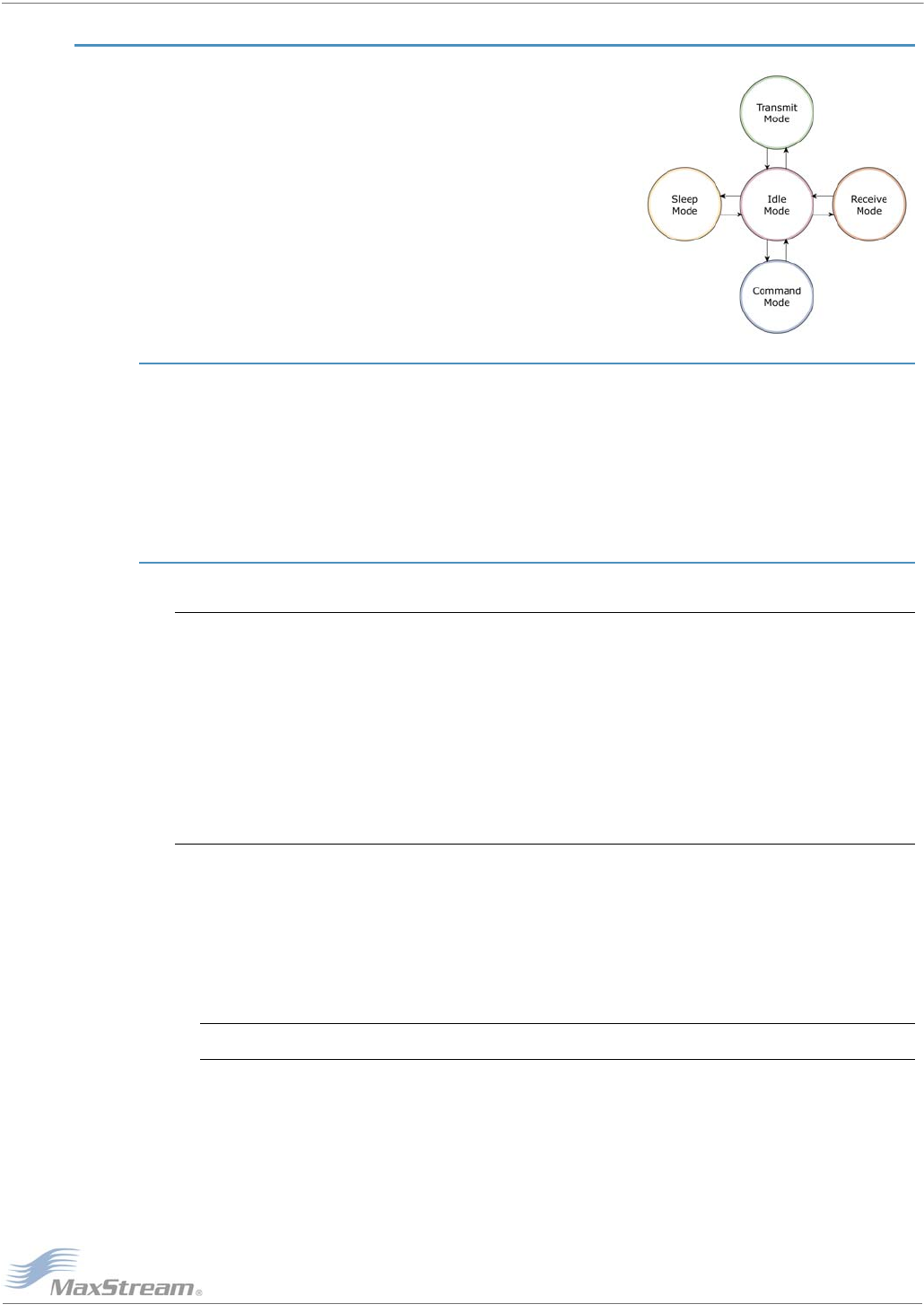
XBee™/XBee‐PROOEMRFModules–ProductManualv1.x7CBETA[2005.12.02]
©2005MaxStream,Inc.,Confidential&Proprietary‐AllRightsReserved 15
2.3. Modes of Operation
XBee/XBee-PRO RF Modules operate in five modes.
Figure2‐06. XBee/XBee‐PRORFModule
ModesofOperation
2.3.1. Idle Mode
When not receiving or transmitting data, the RF module is in Idle Mode. The RF module shifts into
the other modes of operation under the following conditions:
• Transmit Mode: Serial data is received in the DI Buffer
• Receive Mode: Valid RF data is received through the antenna
• Sleep Mode: Sleep Mode condition is met
• Command Mode: Command Mode Sequence is issued
2.3.2. Transmit & Receive Modes
RF Data Packets
Each transmitted data packet contains a <Source Address> and <Destination Address> field. The
<Source Address> matches the address of the transmitting radio as specified by either the MY
(Source Address) parameter (if MY >= 0xFFFE), the SH (Serial Number High) and SL (Serial Num-
ber Low) parameters. The <Destination Address> field is created from the DH and DL parameter
values. The <Source Address> and/or <Destination Address> fields will either contain a short 16-
bit or long 64-bit address.
The RF data packet structure follows the 802.15.4 specification.
[Refer to the Addressing section [p16] for more information]
Direct and Indirect Transmission
There are two methods to transmit data. The first method, Direct Transmission, transmits data
immediately to the <Destination Address>. The second method, Indirect Transmission, retains a
packet for a period of time and transmits the data only after the destination module (<RF Module
Source Address> = <Data Destination Address>) requests the data. Indirect Transmissions can
only occur on a Coordinator. Thus, if all devices in a network are End Devices, only Direct Trans-
missions will occur. Indirect Transmissions are useful to ensure packet delivery to a sleeping
device. The Coordinator currently is able to retain up to 2 indirect messages.
Note: A Beaconing Coordinator uses Indirect Transmission for all transmissions.

XBee™/XBee‐PROOEMRFModules–ProductManualv1.x7CBETA[2005.12.02]
©2005MaxStream,Inc.,Confidential&Proprietary‐AllRightsReserved 16
Direct Transmission
A NonBeaconing Coordinator can be configured to only use Direct Transmission by setting the SP
(Cyclic Sleep Period) parameter to “0”. Also, a NonBeaconing Coordinator using indirect transmis-
sions will revert to direct transmission if it knows the destination module is awake.
To enable this behavior, the ST (Time before Sleep) value of the Coordinator must be set to match
the ST value of the End Device. Once the End Device either transmits data to the Coordinator or
polls the Coordinator for data, the Coordinator will use direct transmission for all subsequent data
transmissions to that module address until ST time (or number of beacons) occurs with no activity
(at which point it will revert to using indirect transmissions for that module address). “No activity”
means no transmission or reception of messages with a specific address. Global messages will not
reset the ST timer.
Indirect Transmission
To configure Indirect Transmissions in a PAN (Personal Area Network), the SP (Cyclic Sleep Period)
parameter value on the Coordinator must be set to match the longest sleep value of any End
Device. The SP parameter represents time in NonBeacon systems and beacons in Beacon-enabled
systems. The sleep period value on the Coordinator determines how long (time or number of bea-
cons) the Coordinator will retain an indirect message before discarding it.
In a Beacon-enabled network, the Coordinator transmits the destination addresses of all pending
indirect messages with each beacon. When an End Device receives the beacon, it will automati-
cally poll the Coordinator and request the data (if it finds its address in the beacon).
In a NonBeacon network, an End Device must poll the Coordinator once it wakes from Sleep to
determine if the Coordinator has an indirect message for it. For cyclic sleep modes, this is done
automatically every time the radio wakes (after SP time). For pin sleep modes, the A1 (End Device
Association) parameter value must be set to enable Coordinator polling on pin wake-up. Alterna-
tively, an End Device can use the FP (Force Poll) command to poll the Coordinator as needed.
Transmission Algorithm
Prior to transmitting a packet, a CCA (Clear Channel Assessment) is performed on the channel to
determine if the channel is available for transmission. The detected energy on the channel is com-
pared with the CA (Clear Channel Assessment) parameter value. If the detected energy exceeds
the CA parameter value, the packet is not transmitted. Also, before transmission a delay is
inserted before a transmission takes place. This delay is settable using the RN (Backoff Exponent)
parameter. If RN is set to “0”, then there is no delay before the first CCA is performed. The RN is
equivalent of the “minBE” parameter in the 802.15.4 specification. The transmit sequence in both
beacon and NonBeacon modes follow the 802.15.4 specification.
Acknowledgement
If the transmission is not a broadcast message, the radio will expect to receive an acknowledge-
ment from the destination device. If an acknowledgement is not received, the packet will be resent
up to 3 more times. If the acknowledgement is not received after all transmissions, an ACK failure
is recorded.
Addressing
When communication occurs between two networked devices, each data packet contains a
<Source Address> and a <Destination Address> field. The XBee/XBee-PRO RF Module conforms
to the 802.15.4 specification and supports both short 16-bit addresses and long 64-bit addresses.
A unique 64-bit IEEE source address is assigned at the factory and can be read with the SL (Serial
Number Low) and SH (Serial Number High) parameters. Short addressing must be configured
manually. An RF module will use its unique 64-bit address as its Source Address if its MY value is
“0xFFFF” or “0xFFFE”.
To send a packet to a specific RF module using 64-bit addressing, set the Destination Address (DL
+ DH) to match the Source Address (SL + SH) of the intended destination RF module. To send a
packet to a specific RF module using 16-bit addressing, set the DL (Destination Address Low)
parameter to the MY (Source Address) parameter and set the DH (Destination Address High)
parameter to “0”.
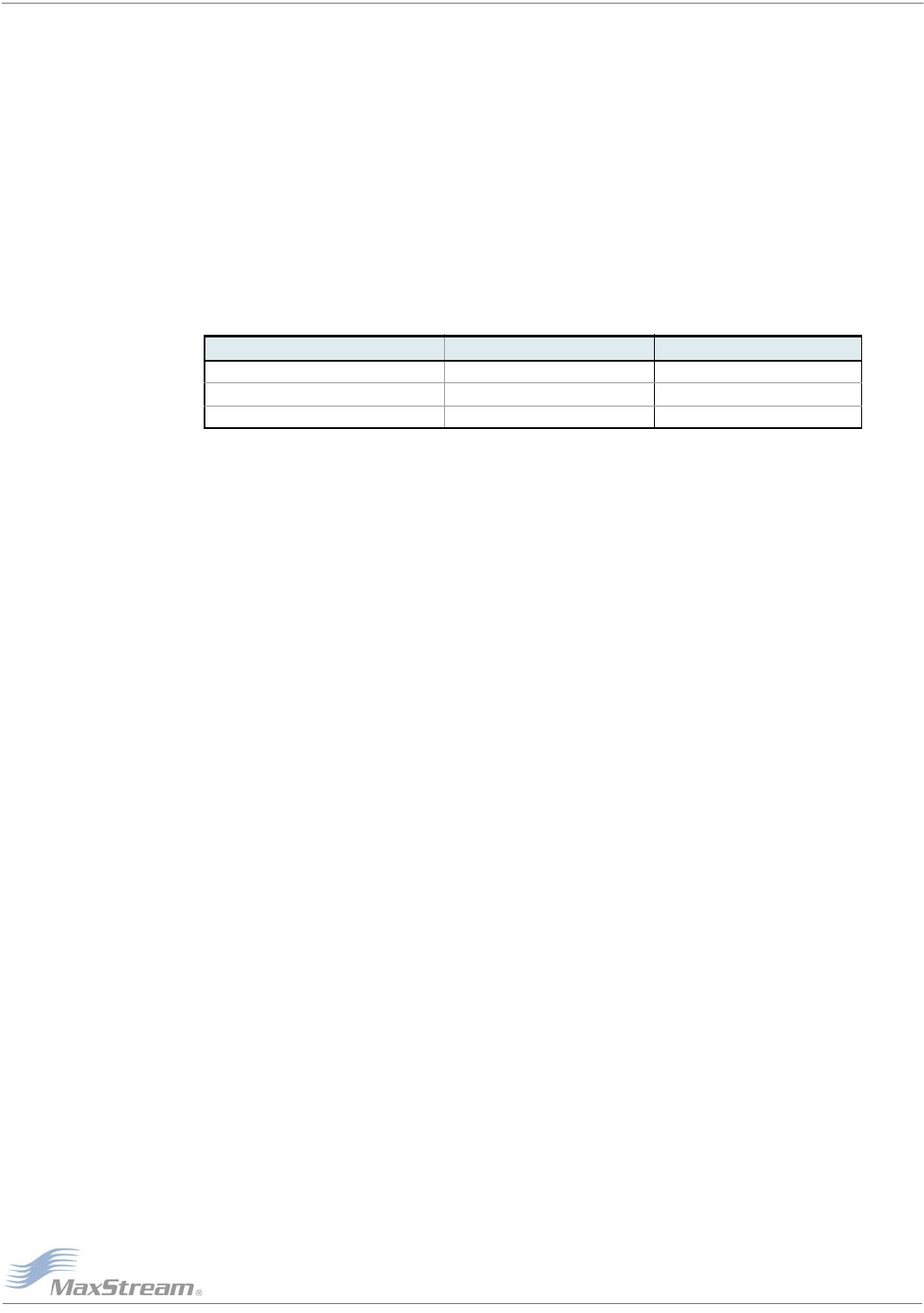
XBee™/XBee‐PROOEMRFModules–ProductManualv1.x7CBETA[2005.12.02]
©2005MaxStream,Inc.,Confidential&Proprietary‐AllRightsReserved 17
Unicast Mode
Unicast Mode enables acknowledged communications. While in this mode, receiving modules send
an ACK (acknowledgement) of RF packet reception to the transmitter. If the transmitting module
does not receive the ACK, the transmitter will re-send the packet up to three times until the ACK is
received.
Unicast Mode is the only mode that supports retries.
Short 16-bit addresses. The module can be configured to use short 16-bit addresses as the
Source Address by setting (MY < 0xFFFE). Setting the DH parameter (DH = 0) will configure the
Destination Address to be a short 16-bit address (if DL < 0xFFFE). For two modules to communi-
cate using short addressing, the Destination Address of the transmitter module must match the
MY parameter of the receiver.
The following table shows a sample network configuration that would enable Unicast Mode com-
munications using 16-bit short addresses.
Long 64-bit addresses. The RF module’s serial number (SL parameter concatenated to the SH
parameter) can be used as a 64-bit source address when the MY (16-bit Source Address) parame-
ter is disabled. When the MY parameter is disabled (set MY = 0xFFFF or 0xFFFE), the module’s
source address is set to the 64-bit IEEE address stored in the SH and SL parameters.
When an End Device associates to a Coordinator, its MY parameter is set to 0xFFFE to enable 64-
bit addressing. The 64-bit address of the module is stored as SH and SL parameters. To send a
packet to a specific module, the Destination Address (DL + DH) on one module must match the
Source Address (SL + SH) of the other.
Broadcast Mode
Any RF module will accept a packet that contains a broadcast address. When configured to operate
in Broadcast Mode, receiving modules do not send ACKs (Acknowledgements) and transmitting RF
modules do not automatically re-send packets as is the case in Unicast Mode.
To send a broadcast packet to all modules regardless of 16-bit or 64-bit addressing, set destina-
tion addresses of all the modules as shown below.
Sample Configuration (All modules in the network):
• DL (Destination Low Address) = 0x0000FFFF
• DH (Destination High Address) = 0x00000000
NOTE: When programming the module, parameters are entered in hexadecimal notation (without
the “0x” prefix). Leading zeros may be omitted.
Table2‐02. SampleUnicastConfiguration(using16‐bitaddressing)
Parameter RF Module 1 RF Module 2
MY (Source Address) 0x01 0x02
DH (Destination Address High) 0 0
DL (Destination Address Low) 0x02 0x01
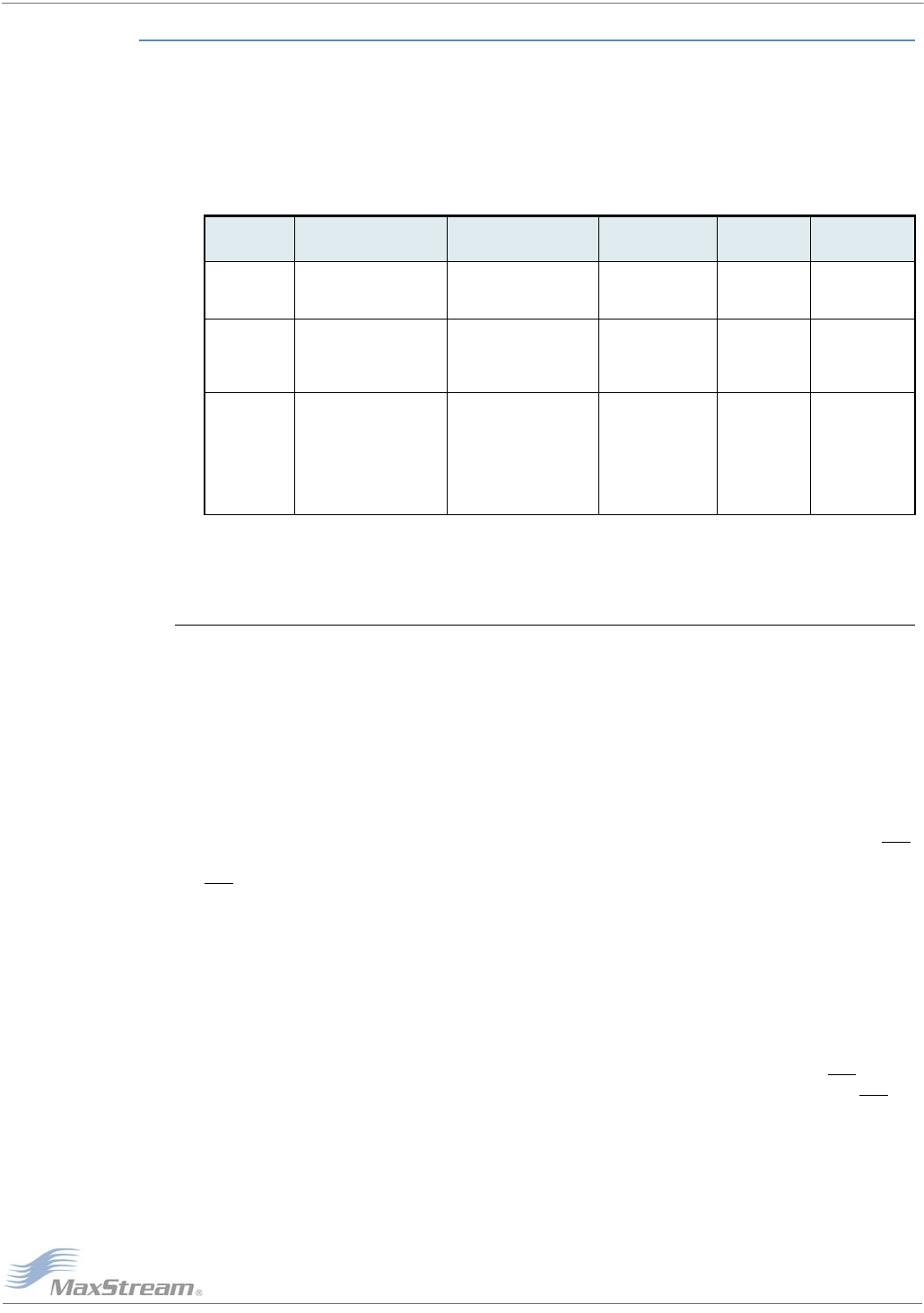
XBee™/XBee‐PROOEMRFModules–ProductManualv1.x7CBETA[2005.12.02]
©2005MaxStream,Inc.,Confidential&Proprietary‐AllRightsReserved 18
2.3.3. Sleep Mode
Sleep Modes enable the RF module to enter states of low-power consumption when not in use. In
order to enter Sleep Mode, one of the following conditions must be met (in addition to the module
having a non-zero SM parameter value):
• Sleep_RQ (pin 9) is asserted.
• The module is idle (no data transmission or reception) for the amount of time defined by the
ST (Time before Sleep) parameter. [NOTE: ST is only active when SM = 4-5.]
The SM command is central to setting Sleep Mode configurations. By default, Sleep Modes are dis-
abled (SM = 0) and the module remains in Idle/Receive Mode. When in this state, the module is
constantly ready to respond to serial or RF activity.
Pin/Host-controlled Sleep Modes
Pin Hibernate (SM = 1)
• Pin/Host-controlled
• Typical power-down current: < 10 µA (@3.0 VCC)
• Wake-up time: 13.2 msec
Pin Hibernate Mode minimizes quiescent power (power consumed when in a state of rest or inac-
tivity). This mode is voltage level-activated; when Sleep_RQ is asserted, the module will finish any
transmit, receive or association activities, enter Idle Mode and then enter a state of sleep. The
module will not respond to either serial or RF activity while in pin sleep.
To wake a sleeping module operating in Pin Hibernate Mode, de-assert Sleep_RQ (pin 9). The
module will wake when Sleep_RQ is de-asserted and is ready to transmit or receive when the CTS
line is low. When waking the module, the pin must be de-asserted at least two 'byte times' after
CTS goes low. This assures that there is time for the data to enter the DI buffer.
Pin Doze (SM = 2)
• Pin/Host-controlled
• Typical power-down current: < 50 µA
• Wake-up time: 2 msec
Pin Doze Mode functions as does Pin Hibernate Mode; however, Pin Doze features faster wake-up
time and higher power consumption.
To wake a sleeping module operating in Pin Doze Mode, de-assert Sleep_RQ (pin 9). The module
will wake when Sleep_RQ is de-asserted and is ready to transmit or receive when the CTS line is
low. When waking the module, the pin must be de-asserted at least two 'byte times' after CTS
goes low. This assures that there is time for the data to enter the DI buffer.
Table2‐03. SleepModeConfigurations
Sleep Mode
Setting Transition into
Sleep Mode Transition out of
Sleep Mode (wake) Characteristics Related
Commands Power
Consumption
Pin Hibernate
(SM = 1) Assert (high) Sleep_RQ
(pin 9) De-assert (low) Sleep_RQ Pin/Host-controlled /
NonBeacon systems
only / Lowest Power (SM) < 10 µA (@3.0
VCC)
Pin Doze
(SM = 2) Assert (high) Sleep_RQ
(pin 9 De-assert (low) Sleep_RQ
Pin/Host-controlled /
NonBeacon systems
only / Fastest Wake-
up
(SM) < 50 µA
Cyclic Sleep
(SM = 4 - 5)
Automatic transition to
Sleep Mode as defined by
the SM (Sleep Mode) and
ST (Time before Sleep)
parameters.
Transition occurs after the
cyclic sleep time interval
elapses. The time interval
is defined by the SP (Cyclic
Sleep Period) parameter.
RF Module wakes in
pre-determined time
intervals to detect if
RF data is present /
When SM = 5,
NonBeacon systems
only
(SM), SP, ST < 50 µA
when sleeping

XBee™/XBee‐PROOEMRFModules–ProductManualv1.x7CBETA[2005.12.02]
©2005MaxStream,Inc.,Confidential&Proprietary‐AllRightsReserved 19
Cyclic Sleep Modes
Cyclic Sleep Remote (SM = 4)
• Typical Power-down Current: < 50 µA (when asleep)
• Wake-up time: 2 msec
The Cyclic Sleep Modes allow modules to periodically check for RF data. When the SM parameter is
set to ‘4’, the module is configured to sleep, then wakes once a cycle to check for data from a
module configured as a Cyclic Sleep Coordinator (SM = 0, CE = 1). The Cyclic Sleep Remote sends
a poll request to the coordinator at a specific interval set by the SP (Cyclic Sleep Period) parame-
ter. The coordinator will transmit any queued data addressed to that specific remote upon receiv-
ing the poll request.
If no data is queued for the remote, the coordinator will not transmit and the remote will return to
sleep for another cycle. If queued data is transmitted back to the remote, it will stay awake to
allow for back and forth communication until the ST (Time before Sleep) timer expires.
Also note that CTS will go low each time the remote wakes, allowing for communication initiated
by the remote host if desired.
Cyclic Sleep Remote with Pin Wake-up (SM = 5)
Use this mode to wake a sleeping remote module through either the RF interface or by the de-
assertion of Sleep_RQ for event-driven communications. The cyclic sleep mode works as described
above (Cyclic Sleep Remote) with the addition of a pin-controlled wake-up at the remote module.
The Sleep_RQ pin is edge-triggered, not level-triggered. The module will wake when a low is
detected then set CTS low as soon as it is ready to transmit or receive.
Any activity will reset the ST (Time before Sleep) timer so the module will go back to sleep only
after Sleep_RQ is asserted and there is no activity for the duration of the timer. Once the module
wakes (pin-controlled), further pin activity is ignored. The module transitions back into sleep
according to the ST time regardless of the state of the pin.
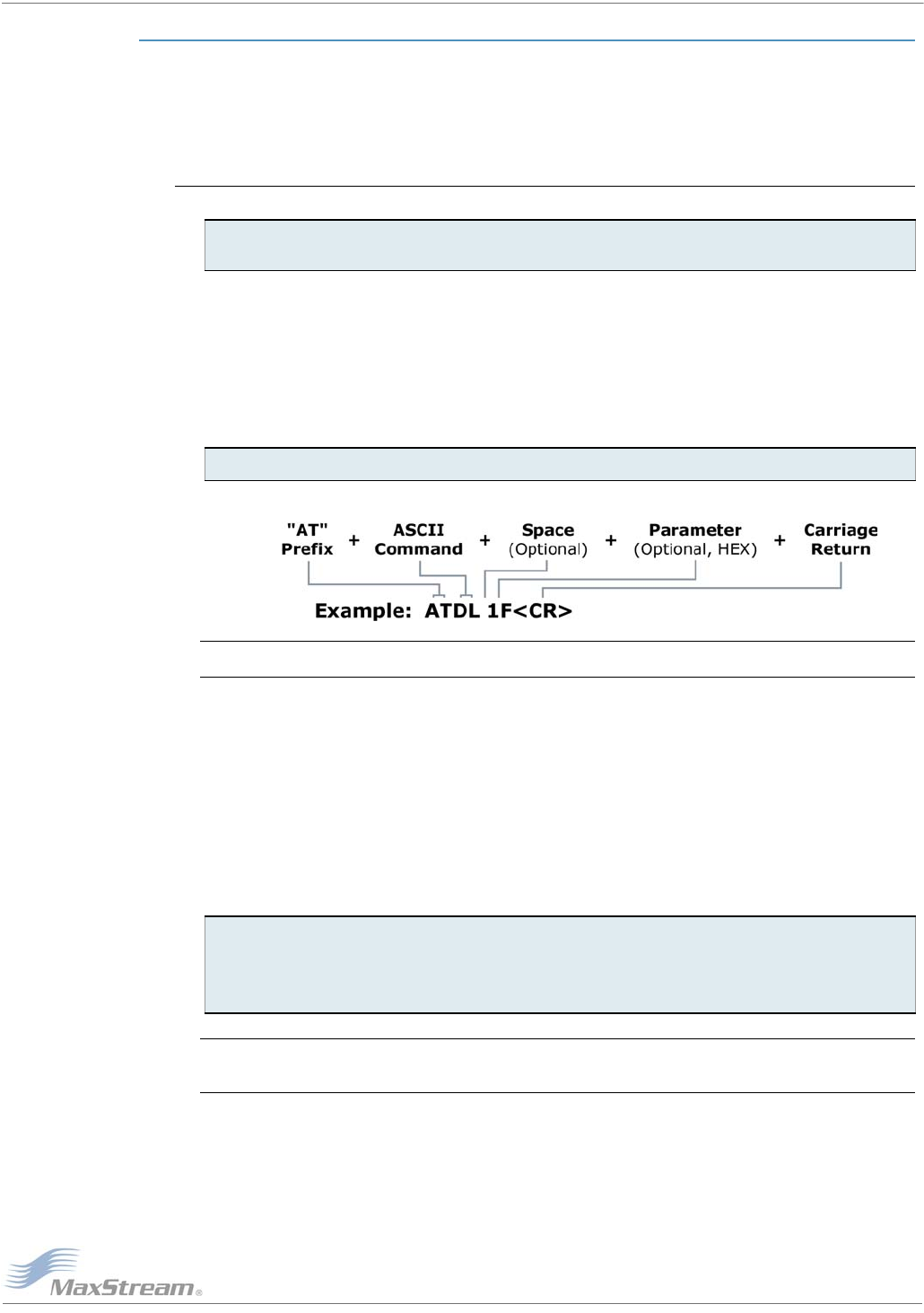
XBee™/XBee‐PROOEMRFModules–ProductManualv1.x7CBETA[2005.12.02]
©2005MaxStream,Inc.,Confidential&Proprietary‐AllRightsReserved 20
2.3.4. Command Mode
To modify or read RF Module parameters, the module must first enter into Command Mode - a
state in which incoming characters are interpreted as commands. Two command modes are sup-
ported: AT Command Mode and ATI Command Mode.
A robust set of AT Commands is available for programming and customizing the module.
AT Command Mode
To Enter AT Command Mode:
Default AT Command Mode Sequence (for transition to Command Mode):
• No characters sent for one second [GT (Guard Times) parameter = 0x3E8]
• Input three plus characters (“+++”) within one second [CC (Command Sequence Character)
parameter = 0x2B.]
• No characters sent for one second [GT (Guard Times) parameter = 0x3E8]
All of the parameter values in the sequence can be modified to reflect user preferences.
To Send AT Commands:
Figure2‐07.SyntaxforsendingATCommands
To read a parameter value stored in the RF module’s register, leave the parameter field blank.
The preceding example would change the RF module Destination Address (Low) to “0x1F”. To
store the new value to non-volatile (long term) memory, subsequently send the WR (Write) com-
mand.
For modified parameter values to persist in the module’s registry, changes must be saved to non-
volatile memory using the WR (Write) Command. Otherwise, parameters are restored to previ-
ously saved values after the module is powered off and then on again (or re-booted).
System Response. When a command is sent to the RF module, the module will parse and exe-
cute the command. Upon successful execution of a command, the module returns an “OK” mes-
sage. If execution of a command results in an error, the module returns an “ERROR” message.
To Exit AT Command Mode:
For an example of programming the RF module using AT Commands and descriptions of each config-
urable parameter, refer to the "RF Module Configuration" chapter [p21].
Send the 3-character command sequence “+++” and observe guard times before and after the
command characters. [Refer to the “Default AT Command Mode Sequence” below.]
Send AT commands and parameters using the syntax shown below.
1. Send ATCN (Exit Command Mode) Command.
[OR]
2. If no valid AT Commands are received within the time specified by CT (Command Mode
Timeout) Command, the RF module automatically returns to Idle Mode.

XBee™/XBee‐PROOEMRFModules–ProductManualv1.x7CBETA[2005.12.02]
©2005MaxStream,Inc.,Confidential&Proprietary‐AllRightsReserved 21
3.RFModuleConfiguration
3.1. Programming the RF Module
Refer to the “Command Mode” section [p20] for more information about entering Command Mode,
sending AT commands and exiting Command Mode.
3.1.1. Programming Examples
Setup
Sample Configuration: Modify RF Module Destination Address
Sample Configuration: Restore RF Module Defaults
The programming examples in this section require the installation of MaxStream's X-CTU Soft-
ware and a serial connection to a PC. (MaxStream stocks RS-232 and USB boards to facilitate
interfacing to a PC.)
1. Install MaxStream's X-CTU Software to a PC by double-clicking the "setup_X-CTU.exe" file.
(The file is located on the MaxStream CD and under the 'Software' section of the following
web page: www.maxstream.net/helpdesk/download.php)
2. Mount the RF module to an interface board, then connect the module assembly to a PC.
3. Launch the X-CTU Software and select the 'PC Settings' tab. Verify the baud and parity set-
tings of the Com Port match those of the RF module.
NOTE: Failure to enter AT Command Mode is most commonly due to baud rate mismatch.
Ensure the ‘Baud’ setting on the ‘PC Settings’ tab matches the interface data rate of the RF mod-
ule (by default, BD parameter = 3 (which corresponds to 9600 bps)).
Example: Utilize the 'Terminal' tab of the X-CTU Software to change the RF module's DL (Desti-
nation Address Low) parameter and save the new address to non-volatile memory.
After establishing a serial connection between the RF module and a PC [refer to the 'Setup' sec-
tion above], select the ‘Terminal’ tab of the X-CTU Software and enter the following command
lines (‘CR’ stands for carriage return):
Method 1 (One line per command)
Send AT Command
+++
ATDL <Enter>
ATDL1A0D <Enter>
ATWR <Enter>
ATCN <Enter>
System Response
OK <CR> (Enter into Command Mode)
{current value} <CR> (Read Destination Address Low)
OK <CR> (Modify Destination Address Low)
OK <CR> (Write to non-volatile memory)
OK <CR> (Exit Command Mode)
Method 2 (Multiple commands on one line)
Send AT Command
+++
ATDL <Enter>
ATDL1A0D,WR,CN <Enter>
System Response
OK <CR> (Enter into Command Mode)
{current value} <CR> (Read Destination Address Low)
OK <CR> (Execute commands)
Example: Utilize the 'Modem Configuration' tab of the X-CTU Software to restore default param-
eter values of the RF module.
After establishing a connection between the RF module and a PC [refer to the 'Setup' section
above], select the 'Modem Configuration' tab of the X-CTU Software.
1. Select the 'Read' button.
2. Select the 'Restore' button.
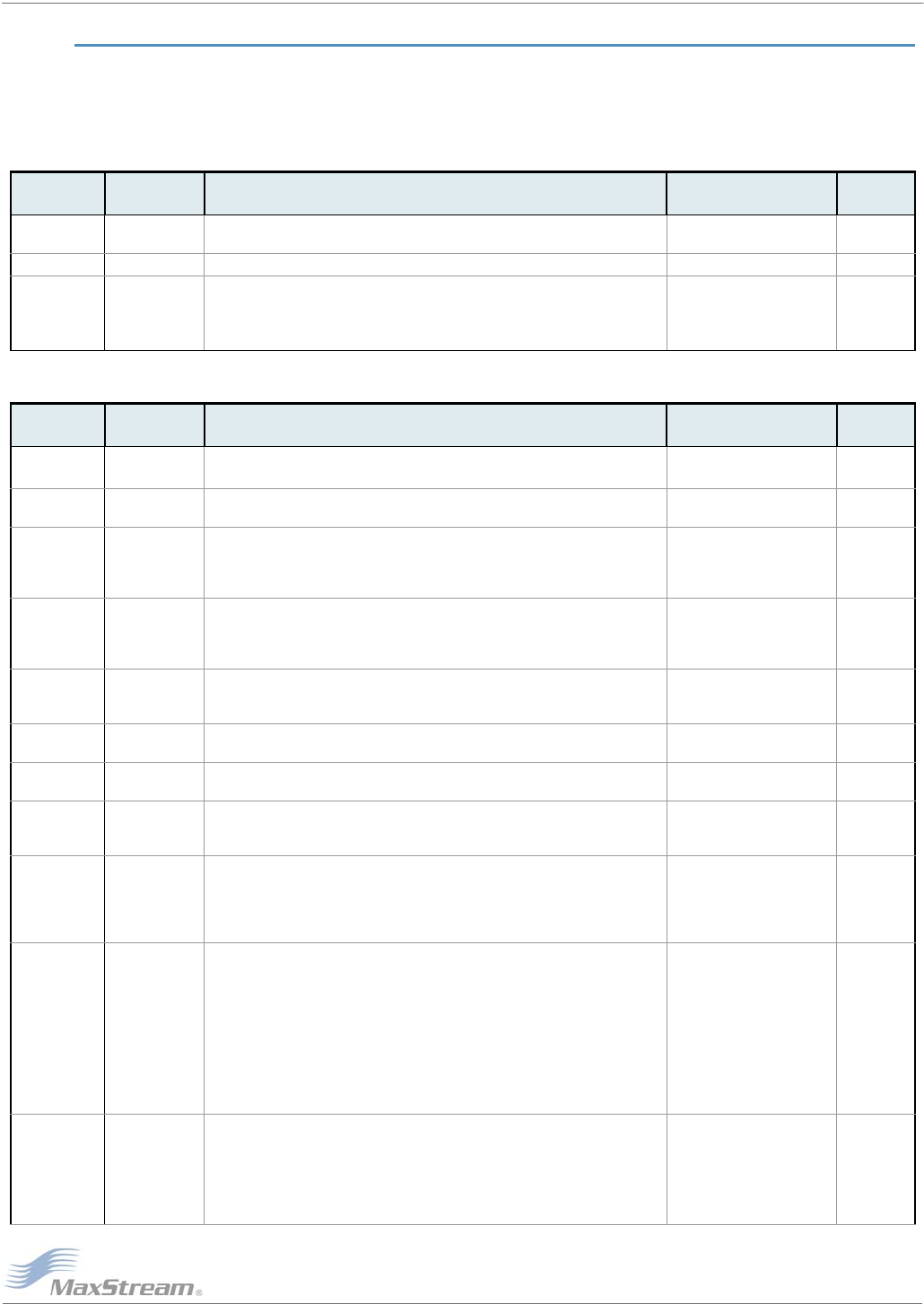
XBee™/XBee‐PROOEMRFModules–ProductManualv1.x7CBETA[2005.12.02]
©2005MaxStream,Inc.,Confidential&Proprietary‐AllRightsReserved 22
3.2. Command Reference Tables
RF modems expect numerical values in hexadecimal. Hexadecimal values are designated by the
“0x” prefix. Decimal equivalents are designated by the “d” suffix. Table rows are sorted by com-
mand category, then by logic of most commonly used.
Special
Networking
Table3‐01. XBee/XBee‐PROCommands‐Special
AT
Command Command
Category Name and Description Parameter Range Default
FR Special Software Reset. Responds immediately with an OK then performs a hard reset
~100ms later. --
RE Special Restore Defaults. Restore module parameters to factory defaults. - -
WR Special
Write. Write parameter values to non-volatile memory so that parameter modifications
persist through subsequent power-up or reset.
Note: Once WR is issued, no additional characters should be sent to the module until
after the response "OK\r" is received.
--
Table3‐02. XBee/XBee‐PROCommands‐Networking(Sub‐categoriesdesignatedwithin{brackets})
AT
Command Command
Category Name and Description Parameter Range Default
CH Networking
{Addressing} Channel. Set/Read the channel number used for transmitting and receiving between
RF modules. Uses 802.15.4 protocol channel numbers.
0x0B - 0x1A (XBee)
0x0C - 0x18 (XBee-PRO) 0x0C (12d)
ID Networking
{Addressing} PAN ID. Set/Read the PAN (Personal Area Network) ID.
Use 0xFFFF to send messages to all PANs. 0xFFFF 0x3332
(13106d)
DH Networking
{Addressing}
Destination Address High. Set/Read the upper 32 bits of the 64-bit destination
address. When combined with DL, it defines the destination address used for
transmission. To transmit using a 16-bit address, set DH parameter to zero and DL less
than 0xFFFF. 0x000000000000FFFF is the broadcast address for the PAN.
0 - 0xFFFFFFFF 0
DL Networking
{Addressing}
Destination Address Low. Set/Read the lower 32 bits of the 64-bit destination
address. When combined with DH, DL defines the destination address used for
transmission. To transmit using a 16-bit address, set DH parameter to zero and DL less
than 0xFFFF. 0x000000000000FFFF is the broadcast address for the PAN.
0 - 0xFFFFFFFF 0
MY Networking
{Addressing}
16-bit Source Address. Set/Read the RF module 16-bit source address. Set MY =
0xFFFF to disable reception of packets with 16-bit addresses. 64-bit source address
(serial number) and broadcast address (0x000000000000FFFF) is always enabled. 0 - 0xFFFF 0
SH Networking
{Addressing} Serial Number High. Read high 32 bits of the RF module's unique IEEE 64-bit
address. 64-bit source address is always enabled. 0 - 0xFFFFFFFF [read-only] Factory-set
SL Networking
{Addressing} Serial Number Low. Read low 32 bits of the RF module's unique IEEE 64-bit address.
64-bit source address is always enabled. 0 - 0xFFFFFFFF [read-only] Factory-set
RN Networking
{Addressing}
Random Delay Slots. Set/Read the minimum value of the back-off exponent in the
CSMA-CA algorithm that is used for collision avoidance. If RN = 0, collision avoidance
is disabled during the first iteration of the algorithm (802.15.4 - macMinBE). 0 - 3 [exponent] 0
MI Networking
{Identification}
Modem Identifier. Stores a string identifier. The register only accepts printable ASCII
data. A string can not start with a space. Carriage return ends command. Command will
automatically end when maximum bytes for the string have been entered. This string is
returned as part of the MD (Modem Discover) command. This identifier is also used with
the DM (Destination Modem) command.
20 byte ACII string -
MD Networking
{Identification}
Modem Discover. Discovers and reports all XBee Modems found. The following
information is reported for each modem discovered (refer to long command description
regarding differences between Transparent and API operation).
MY<CR>
SH<CR>
SL<CR>
MI<CR><CR>
After 500 msec, the command ends by returning a <CR> (carriage return).
MD also accepts a Modem Identifier as a parameter. In this case only a modem
matching the supplied identifier will respond.
optional - MI
DM Networking
{Identification}
Destination Modem. Resolves a Modem Identifier string to a physical address. The
following events occur upon successful command execution:
1. DL and DH are set to the address of the modem with the matching Modem Identifier.
2. OK is returned.
If there is no response from a modem within 200 msec or a parameter is not specified
(left blank), the command is terminated and ERROR is returned.
20 byte ACII string
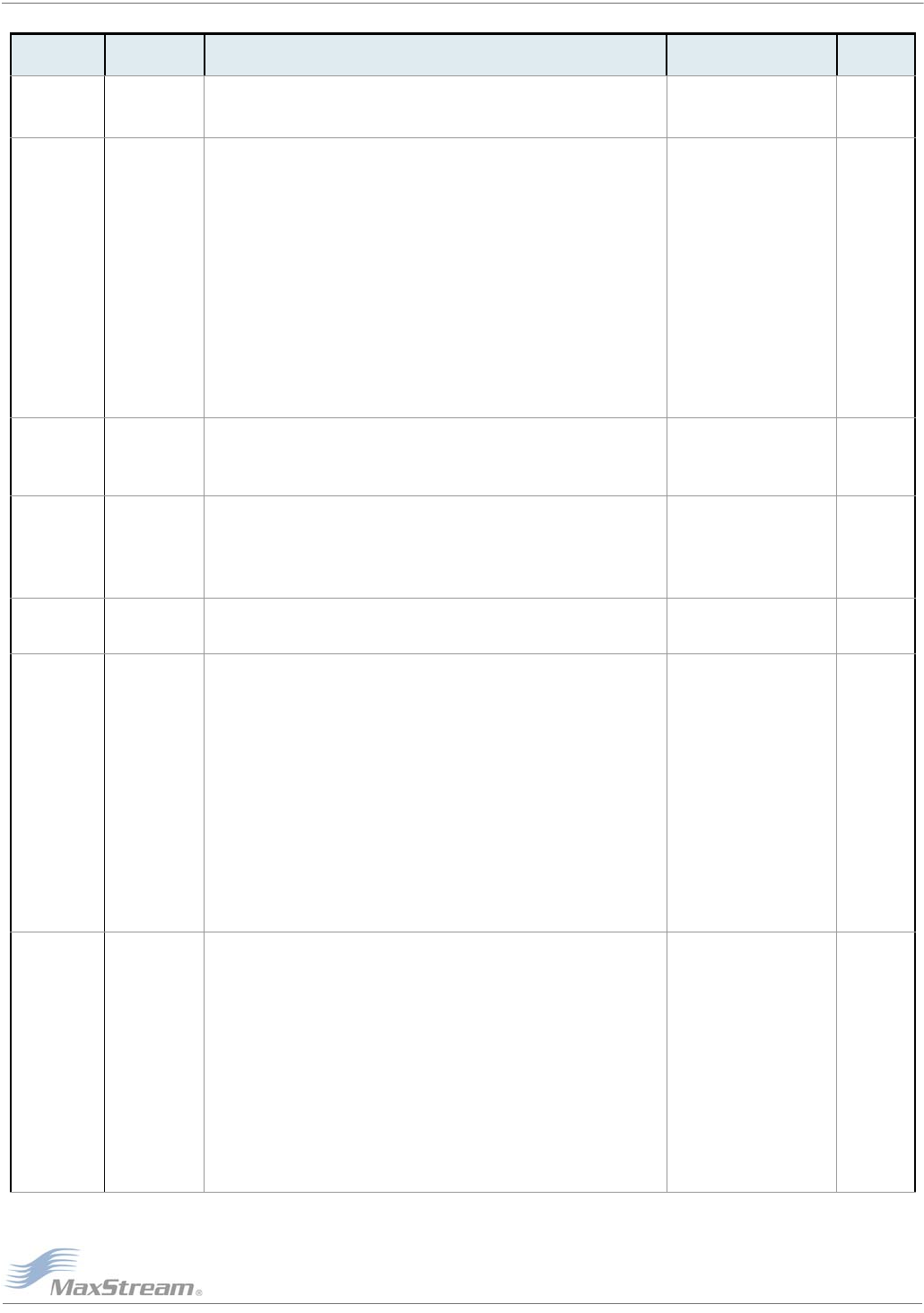
XBee™/XBee‐PROOEMRFModules–ProductManualv1.x7CBETA[2005.12.02]
©2005MaxStream,Inc.,Confidential&Proprietary‐AllRightsReserved 23
CE Networking
{Association} Coordinator Enable. Set/Read the coordinator setting.
0 - 1
0 = End Device
1 = Coordinator
0
SD Networking
{Association}
Scan Duration. Set/Read the scan duration exponent.
End Device - Duration of Active Scan during Association. On beacon system, set SD =
BE of coordinator. SD must be set at least to the highest BE parameter of any
Beaconing Coordinator with which an End Device or Coordinator wish to discover.
Coordinator - If ‘ReassignPANID’ option is set on Coordinator [refer to A2 parameter],
SD determines the length of time the Coordinator will scan channels to locate existing
PANs. If ‘ReassignChannel’ option is set, SD determines how long the Coordinator will
perform an Energy Scan to determine which channel it will operate on.
‘Scan Time’ is measured as (# of channels to scan] * (2 ^ SD) * 15.36ms). The number
of channels to scan is set by the SC command. The XBee can scan up to 16 channels
(SC = 0xFFFF). The XBee PRO can scan up to 13 channels (SC = 0x3FFE).
Example: The values below show results for a 13 channel scan:
If SD = 0, time = 0.246 sec SD = 8, time = 62.91 sec
SD = 2, time = 0.983 sec SD = 10, time = 4.19 min
SD = 4, time = 3.93 sec SD = 12, time = 16.77 min
SD = 6, time = 15.73 sec SD = 14, time = 67.07 min
0-0x0F [exponent] 4
BE Networking
{Association}
Beacon Order. <Beacon Firmware Only> Set/Read the exponent used in calculating
beacon order. Beacon order specifies how often the coordinator transmits a beacon.
The actual time (msec) is calculated from BE as: Time = ((2 ^ BE) * 15.36 ms)
End devices automatically update their BE to match the coordinator upon association.
0-0x0E [exponent] 2
SF Networking
{Association}
Superframe Order. <Beacon Firmware Only> Set/Read the exponent used in
calculating superframe order. The superframe order specifies the length of the active
portion of the superframe (including the beacon frame). The SF parameter should be
set less than or equal to the BE parameter or upon exiting command mode, SF will be
set to equal BE. The actual Active Period time (ms) is calculated from SF as:
Time = (2 ^ SF) * 15.36 ms.
0-0x0E [exponent] 2
SA Networking
{Association}
Resync Attempts. <Beacon Firmware Only> Set/Read the number of times an End
Device will attempt to reacquire a lost beacon before disassociating from a Beaconing
Coordinator. 0-0x0F [# of attempts] 0
A1 Networking
{Association}
End Device Association. Set/Read End Device association options.
bit 0 - ReassignPanID
0 - Will only associate with Coordinator operating on PAN ID that matches modem ID
1 - May associate with Coordinator operating on any PAN ID
bit 1 - ReassignChannel
0 - Will only associate with Coordinator operating on Channel that matches CH setting
1 - May associate with Coordinator operating on any Channel
bit 2 - AutoAssociate
0 - Device will not attempt Association
1 - Device attempts Association until success
Note: This bit is used only for Non-Beacon systems. End Devices in Beacon-enabled
system must always associate to a Coordinator
bit 3 - PollCoordOnPinWake
0 - Pin Wake will not poll the Coordinator for indirect (pending) data
1 - Pin Wake will send Poll Request to Coordinator to extract any pending data
bits 4 - 7 are reserved
0 - 0x0F [bit field] 0
A2 Networking
{Association}
Coordinator Association. Set/Read Coordinator association options.
bit 0 - ReassignPanID
0 - Coordinator will not perform Active Scan to locate available PAN ID. It will operate
on ID (PAN ID).
1 - Coordinator will perform Active Scan to determine an available ID (PAN ID). If a
PAN ID conflict is found, the ID parameter will change.
bit 1 - ReassignChannel -
0 - Coordinator will not perform Energy Scan to determine free channel. It will operate
on the channel determined by the CH parameter.
1 - Coordinator will perform Energy Scan to find a free channel, then operate on that
channel.
bit 2 - AllowAssociation -
0 - Coordinator will not allow any devices to associate to it.
1 - Coordinator will allow devices to associate to it.
bits 3 - 7 are reserved
0 - 7 [bit field] 6
Table3‐02. XBee/XBee‐PROCommands‐Networking(Sub‐categoriesdesignatedwithin{brackets})
AT
Command Command
Category Name and Description Parameter Range Default

XBee™/XBee‐PROOEMRFModules–ProductManualv1.x7CBETA[2005.12.02]
©2005MaxStream,Inc.,Confidential&Proprietary‐AllRightsReserved 24
AI Networking
{Association}
Association Indication. Read errors with the last association request:
0x00 - Successful Completion - Coordinator successfully started or End Device
association complete
0x01 - Active Scan Timeout
0x02 - Active Scan found no PANs
0x03 - Active Scan found PAN, but the CoordinatorAllowAssociation bit is not set
0x04 - Active Scan found PAN, but Coordinator and End Device are not
configured to support beacons
0x05 - Active Scan found PAN, but the Coordinator ID parameter does not match
the ID parameter of the End Device
0x06 - Active Scan found PAN, but the Coordinator CH parameter does not match the
CH parameter of the End Device
0x07 - Energy Scan Timeout
0x08 - Coordinator start request failed
0x09 - Coordinator could not start due to invalid parameter
0x0A - Coordinator Realignment is in progress
0x0B - Association Request not sent
0x0C - Association Request timed out - no reply was received
0x0D - Association Request had an Invalid Parameter
0x0E - Association Request Channel Access Failure. Request was not transmitted -
CCA failure
0x0F - Remote Coordinator did not send an ACK after Association Request was sent
0x10 - Remote Coordinator did not reply to the Association Request, but an ACK was
received after sending the request
0x11 - [reserved]
0x12 - Sync-Loss - Lost synchronization with a Beaconing Coordinator
0x13 - Disassociated - No longer associated to Coordinator
0 - 0x13 [read-only] -
DA Networking
{Association} Force Disassociation. End Device will immediately disassociate from a Coordinator (if
associated) and reattempt to associate. --
FP Networking
{Association} Force Poll. Request indirect messages being held by a coordinator. - -
AS Networking
{Association}
Active Scan. Sends Beacon Request to Broadcast Address (0xFFFF) and Broadcast
PAN (0xFFFF) on every channel. The parameter determines the time the radio will
listen for Beacons on each channel. A PanDescriptor is created and returned for every
Beacon received from the scan. Each PanDescriptor contains the following information:
CoordAddress (SH, SL)<CR>
CoordPanID (ID)<CR>
CoordAddrMode <CR>
0x02 = 16-bit Short Address
0x03 = 64-bit Long Address
Channel (CH parameter) <CR>
SecurityUse<CR>
ACLEntry<CR>
SecurityFailure<CR>
SuperFrameSpec<CR> (2 bytes):
bit 15 - Association Permitted (MSB)
bit 14 - PAN Coordinator
bit 13 - Reserved
bit 12 - Battery Life Extension
bits 8-11 - Final CAP Slot
bits 4-7 - Superframe Order
bits 0-3 - Beacon Order
GtsPermit<CR>
RSSI<CR> (RSSI is returned as -dBm)
TimeStamp<CR> (3 bytes)
<CR>
A carriage return <CR> is sent at the end of the AS command. The Active Scan is
capable of returning up to 5 PanDescriptors in a scan. The actual scan time on each
channel is measured as Time = [(2 ^ PARAM) * 15.36] ms. Note the total scan time is
this time multiplied by the number of channels to be scanned (!6 for the XBee and 13 for
the XBee-PRO). Also refer to SD command description.
--
ED Networking
{Association}
Energy Scan. Sends Energy Detect Scan. The parameter determines length of scan on
each channel. The maximal energy on each channel is returned, each value is followed
by a carriage return. An additional carriage return is sent at the end of the command.
The values returned represent the detected energy level in units of -dBm. The actual
scan time on each channel is measured as Time = [(2 ^ PARAM) * 15.36] ms. Note the
total scan time is this time multiplied by the number of channels to be scanned. Refer to
SD parameter.
0 - 7 -
Table3‐02. XBee/XBee‐PROCommands‐Networking(Sub‐categoriesdesignatedwithin{brackets})
AT
Command Command
Category Name and Description Parameter Range Default
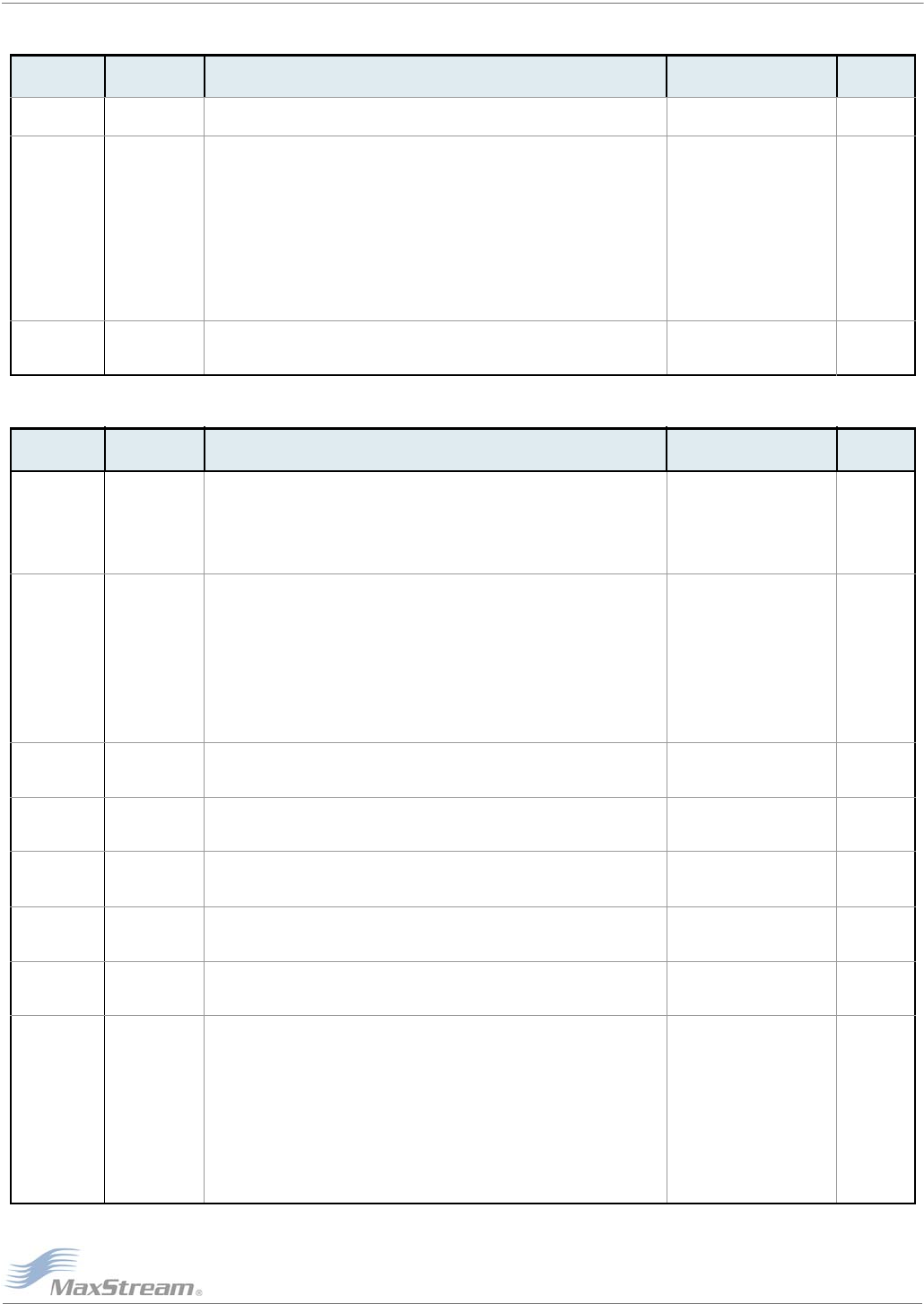
XBee™/XBee‐PROOEMRFModules–ProductManualv1.x7CBETA[2005.12.02]
©2005MaxStream,Inc.,Confidential&Proprietary‐AllRightsReserved 25
RF Interfacing
Serial Interfacing
Table3‐03. XBee/XBee‐PROCommands‐RFInterfacing
AT
Command Command
Category Name and Description Parameter Range Default
PL RF Interfacing Power Level. Select/Read the power level at which the RF module transmits conducted
power. 0 - 4 4
SC RF Interfacing
Scan Channel. Set/Read list of channels to scan for all Active and Energy Scans as bit
field. This affects scans initiated in command mode (AS, ED) and during End Device
Association and Coordinator startup:
bit 0 - 0x0B bit 8 - 0x13
bit 1 - 0x0C bit 9 - 0x14
bit 2 - 0x0D bit 10 - 0x15
bit 3 - 0x0E bit 11 - 0x16
bit 4 - 0x0F bit 12 - 0x17
bit 5 - 0x10 bit 13 - 0x18
bit 6 - 0x11 bit 14 - 0x19
bit 7 - 0x12 bit 15 - 0x1A
0-0xFFFF (bit field)
0x3FFE
(all XBee-
PRO
Channels)
CA RF Interfacing CCA Threshold. Set/read the CCA (Clear Channel Assessment) threshold. Prior to
transmitting a packet, a CCA is performed to detect energy on the transmit channel. If
the detected energy is above the CCA Threshold, the radio will not transmit the packet. 0-0x50 [-dBm] 0x4B
(-75d dBm)
Table3‐04. XBee/XBee‐PROCommands‐SerialInterfacing
AT
Command Command
Category Name and Description Parameter Range Default
AP Serial
Interfacing API Enable. Enable API Mode.
0 - 2
0 = Disabled
1 = API enabled
2 = API enabled
(w/escaped control
characters)
0
BD Serial
Interfacing Interface Data Rate. Set/Read the serial interface data rate for communications
between the RF module serial port and host.
0 - 7
0 = 1200 bps
1 = 2400
2 = 4800
3 = 9600
4 = 19200
5 = 38400
6 = 57600
7 = 115200
(custom rates also supported)
3
RO Serial
Interfacing
Packetization Timeout. Set/Read number of character times of inter-character delay
required before transmission. Set to zero to transmit characters as they arrive instead of
buffering them into one RF packet. 0 - 0xFF [x character times] 3
D7 Serial
Interfacing DIO7 Configuration. Select/Read options for the DIO7 line of the module. 0 - 1
0 = Disabled
1 = CTS Flow Control 1
D6 Serial
Interfacing DIO6 Configuration. Select/Read options for the DIO6 line of the module. Options
include: RTS flow control.
0 - 1
0 = Disabled
1 = RTS flow control 0
D5 Serial
Interfacing DIO5 Configuration. Configure options for the DIO5 line of the module. Options
include: Associated LED indicator (blinks when associated).
0 - 1
0 = Disabled
1 = Associated indicator 1
P0 Serial
Interfacing PWM0 Configuration. Select/Read function for PWM0. 0 - 1
0 = Disabled
1 = RSSI 1
PE Serial
Interfacing
Pull-up Resistor Enable. Set/Read bitfield to configure internal pull-up resistor status
for I/O lines.
bit 0 - AD4/DIO4/RF_TX
bit 1 - COORD
bit 2 - AD2/DIO2
bit 3 - AD1/DIO1
bit 4 - AD0/DIO0
bit 5 - RTS
bit 6 - SLEEP_RQ
bit 7 - DIN/CONFIG
“1” specifies pull-up enabled, “0” specifies no pull-up
0 - 0xFF 0xFF
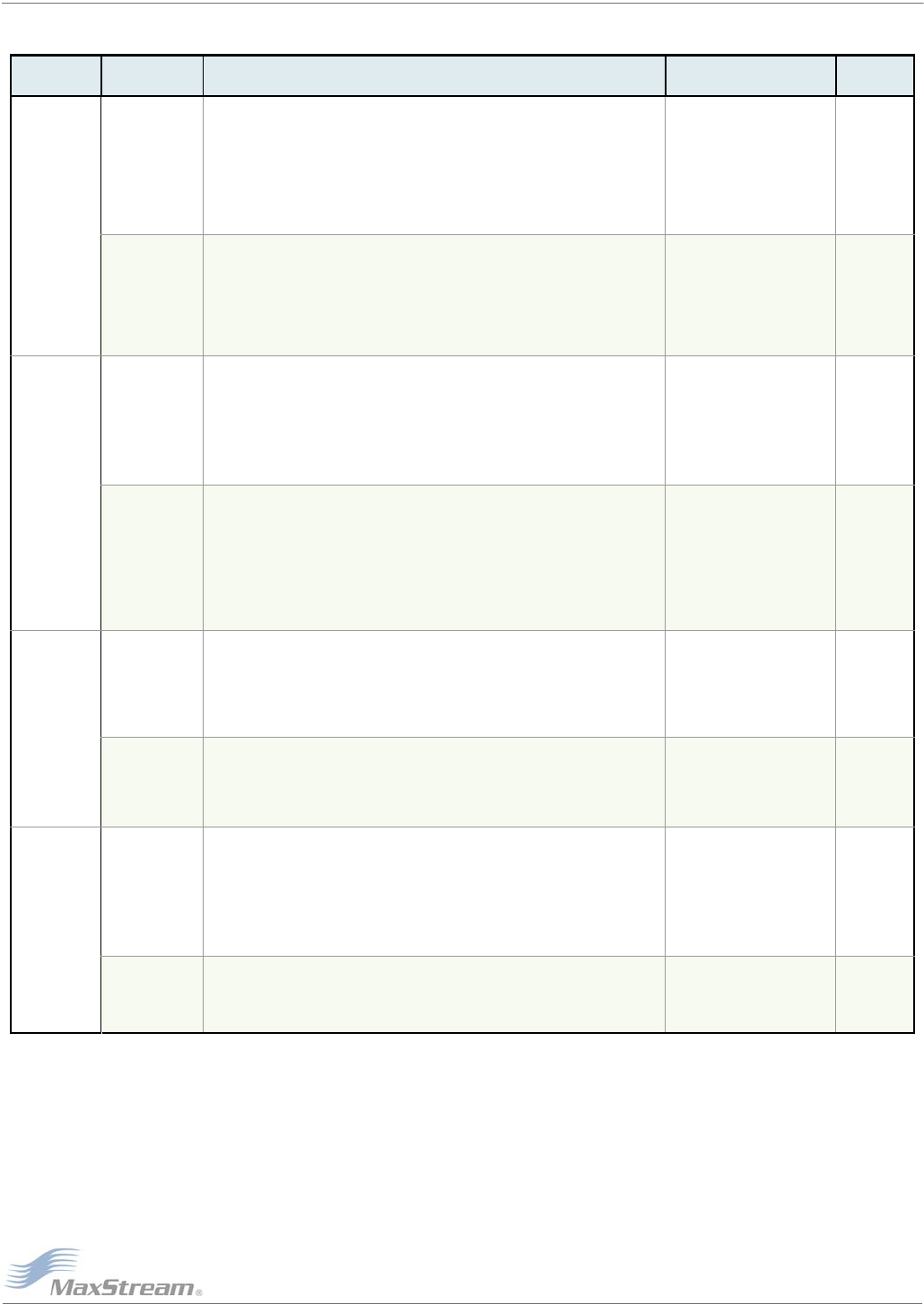
XBee™/XBee‐PROOEMRFModules–ProductManualv1.x7CBETA[2005.12.02]
©2005MaxStream,Inc.,Confidential&Proprietary‐AllRightsReserved 26
Sleep (Low Power)
XBee/XBee-PRO Commands - Sleep (Low Power)
AT
Command Command
Category Name and Description Parameter Range Default
SM
Sleep
{NonBeacon} Sleep Mode. <NonBeacon firmware> Set/Read Sleep Mode configurations.
0 - 5
0 = No Sleep
1 = Pin Hibernate
2 = Pin Sleep
3 = Reserved
4 = Cyclic sleep remote
5 = Cyclic sleep remote
w/ pin wake-up
0
Sleep
{Beacon-enabled} Sleep Mode. <Beacon-enabled firmware> Set/Read Sleep Mode configurations.
0 - 5
0 = No Sleep
1 = n/a
2 = n/a
3 = Reserved
4 = Cyclic sleep remote
5 = n/a
0
SP
Sleep
{NonBeacon}
Cyclic Sleep Period. <NonBeacon firmware> Set/Read sleep period for cyclic sleeping
remotes. Coordinator and End Device SP values should always be equal. To send
Direct Messages, set SP = 0.
End Device - SP determines the sleep period for cyclic sleeping remotes. Maximum
sleep period is 268 seconds (0x68B0).
Coordinator - If non-zero, SP determines the time to hold an indirect message before
discarding it. A Coordinator will discard indirect messages after a period of (2.5 * SP).
0 - 0x68B0 [x 10 ms] 0
Sleep
{Beacon-enabled}
Cyclic Sleep Period. <Beacon-enabled firmware> Set/Read sleep period for cyclic
sleeping remotes. Coordinator and End Device SP values should always be equal. To
send Direct Messages, set SP = 0.
End Device - SP determines the number of beacons a cyclic sleeping remote will sleep
through. Because the maximum sleep period is 268 (decimal) seconds, SP must be
selected such that the equation (2^BE * (0.01536 seconds) * SP) < 268 seconds.
Coordinator - SP determines the number of beacons to retain an indirect message
before discarding it. A Coordinator will discard indirect messages after 2 * SP beacons.
0 - 0x68B0 [beacons] 0x0A (10d)
DP
Sleep
(Low Power)
Disassociated Cyclic Sleep Period. <NonBeacon firmware>
End Device - Set/Read time period of sleep for cyclic sleeping remotes that are
configured for Association but are not associated to a Coordinator. (i.e. If a device is
configured to associate, configured as a Cyclic Sleep remote, but does not find a
Coordinator, it will sleep for DP time before reattempting association.) Maximum sleep
period is 268 seconds (0x68B0). DP should be > 0 for NonBeacon systems.
1 - 0x68B0 [x 10 ms] 0x3E8
(1000d)
Sleep
{Beacon-enabled}
Disassociated Cyclic Sleep Period. <Beacon-enabled firmware>
End Device - Set/Read the number of beacons the cyclic sleeping remote will sleep
through on a failed association attempt before reattempting association. (i.e. If a device
is configured for Association, configured as a Cyclic Sleep remote, and unable to find a
Coordinator; it will sleep for DP beacon times prior to reattempting association.)
1 - 0x68B0 [beacons] 0x14 (20d)
ST
Sleep
{NonBeacon}
Time before Sleep. <NonBeacon firmware> Set/Read time period of inactivity (no serial
or RF data is sent or received) before activating Sleep Mode. ST parameter is only valid
with Cyclic Sleep settings (SM = 4 - 5).
Coordinator and End Device ST values must be equal.
Also note, the GT parameter value must always be less than the ST value. (If GT > ST,
the configuration will render the module unable to enter into command mode.) If the ST
parameter is modified, also modify the GT parameter accordingly.
1 - 0xFFFF [x 1 ms] 0x1388
(5000d)
Sleep
{Beacon-enabled}
Time before Sleep. <Beacon-enabled firmware> Set/Read the number of beacons
received with no activity (no serial or RF data is sent or received) before activating
Sleep Mode. ST parameter is only valid with the Cyclic Sleep setting (SM = 4).
The ST parameter is not used by a Beacon-enabled Coordinator.
1 - 0xFFFF [beacons] 0
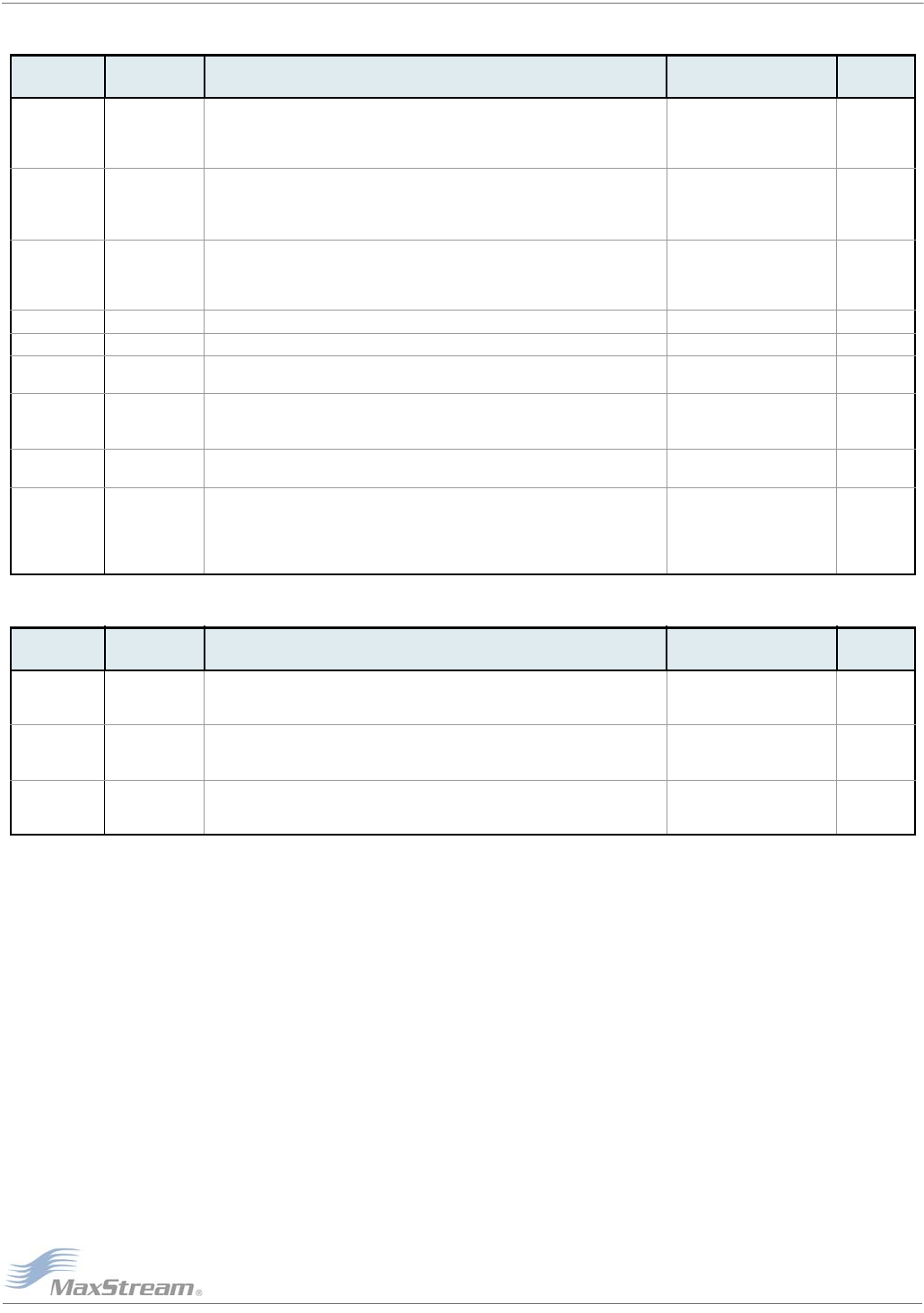
XBee™/XBee‐PROOEMRFModules–ProductManualv1.x7CBETA[2005.12.02]
©2005MaxStream,Inc.,Confidential&Proprietary‐AllRightsReserved 27
Diagnostics
AT Command Options
Table3‐05. XBee/XBee‐PROCommands‐Diagnostics
AT
Command Command
Category Name and Description Parameter Range Default
EC Diagnostics
CCA Failures. Reset/Read count of CCA (Clear Channel Assessment) failures. This
parameter value increments when the module does not transmit a packet because it
detected energy above the CCA threshold level set with CA command. This count
saturates at its maximum value. Set count to “0” to reset count.
0 - 0xFFFF -
EA Diagnostics
ACK Failures. Reset/Read count of acknowledgment failures. This parameter value
increments when the module expires its transmission retries without receiving an ACK
on a packet transmission. This count saturates at its maximum value. Set the parameter
to “0” to reset count.
0 - 0xFFFF -
EH Diagnostics
Echo. Sends command parameter as RF packet to remote modem which 'echoes' back
the data to the transmitting modem. This command uses the current setting of DL and
DH when transmitting the parameter. The command ends by sending a <CR> (Carriage
Return).
1 to 20 bytes -
VR Diagnostics Firmware Version. Read firmware version of the RF module. 0 - 0xFFFF [read-only] Factory-set
HV Diagnostics Hardware Version. Read hardware version of the RF modem. 0 - 0xFFFF [read-only] Factory-set
RP Diagnostics RSSI PWM Timer. Enable a PWM (pulse width modulation) output (on pin 3 of the RF
modules) which shows RX signal strength. 0 - 0xFF [x 100 ms] 0x28 (40d)
DB Diagnostics Received Signal Strength. Read signal level [in dB] of last good packet received
(RSSI). Absolute value is reported. (For example: 0x58 = -88 dBm) Reported value is
accurate between -40 dBm and RX sensitivity. 0 - 0x64 [read-only] -
VL Diagnostics Verbose Version. Read detailed version information including application build date,
MAC, PHY and bootloader versions and build dates. --
ED Diagnostics
Energy Scan. Send an “Energy Detect Scan”. This parameter determines the length of
scan on each channel. The maximal energy on each channel is returned and each
value is followed by a carriage return. The values returned represent the detected
energy level in units of -dBm. The actual scan time on each channel is measured as
Time = [(2 ^ PARAM) * 15.36]ms.
0 - 7 -
Table3‐06. XBee/XBee‐PROCommands‐ATCommandOptions
AT
Command Command
Category Name and Description Parameter Range Default
CT AT Command
Mode Options
Command Mode Timeout. Set/Read the period of inactivity (no valid commands
received) after which the RF module automatically exits AT Command Mode and
returns to Idle Mode. 2 - 0xFFFF [x 100 ms] 0x64 (100d)
GT AT Command
Mode Options
Guard Times. Set required period of silence before and after the Command Sequence
Characters of the AT Command Mode Sequence (GT+ CC + GT). The period of silence
is used to prevent inadvertent entrance into AT Command Mode. 0x02 - 0xFFFF [x 1 ms] 0x3E8
(1000d)
CC AT Command
Mode Options
Command Sequence Character. Set/Read the ASCII character value to be used
between Guard Times of the AT Command Mode Sequence (GT+CC+GT). The AT
Command Mode Sequence enters the RF Module into AT Command Mode. 0 - 0xFF 0x2B
(‘+’ ASCII)
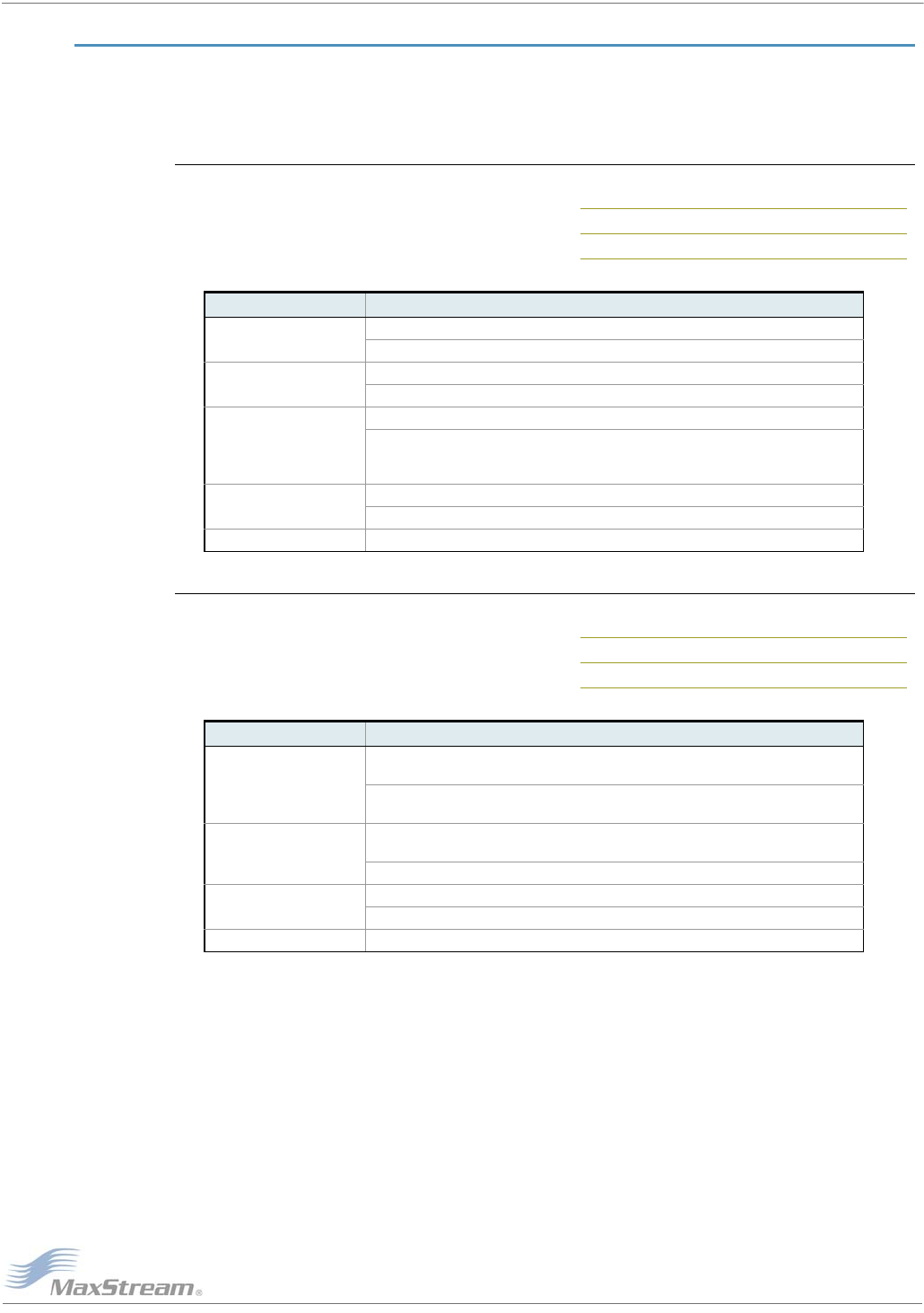
XBee™/XBee‐PROOEMRFModules–ProductManualv1.x7CBETA[2005.12.02]
©2005MaxStream,Inc.,Confidential&Proprietary‐AllRightsReserved 28
3.3. Command Descriptions
Command descriptions in this section are listed alphabetically. Command categories are desig-
nated within "< >" symbols that follow each command title. XBee-PRO RF modules expect param-
eter values in hexadecimal (designated by the "0x" prefix).
A1 (End Device Association) Command
<Networking {Association}> The A1 command is
used to set and read End Device association
options.
Use the table below to determine End Device
behavior in relation to the A1 parameter.
A2 (Coordinator Association) Command
<Networking {Association}> The A2 command is
used to set and read Coordinator association
options.
Use the table below to determine Coordinator
behavior in relation to the A2 parameter.
Thebinaryequivalentofthedefaultvalue(0x06)is00000110.‘Bit0’isthelastdigitofthesequence.
Bit number End Device Association Option
0 - ReassignPanID 0 - Will only associate with Coordinator operating on PAN ID that matches modem ID
1 - May associate with Coordinator operating on any PAN ID
1 - ReassignChannel 0 - Will only associate with Coordinator operating on Channel that matches CH setting
1 - May associate with Coordinator operating on any Channel
2 - AutoAssociate
0 - Device will not attempt Association
1 - Device attempts Association until success
Note: This bit is used only for Non-Beacon systems. End Devices in a Beaconing system must
always associate to a Coordinator
3 - PollCoordOnPinWake 0 - Pin Wake will not poll the Coordinator for pending (indirect) Data
1 - Pin Wake will send Poll Request to Coordinator to extract any pending data
4 - 7 [reserved]
Bit number End Device Association Option
0 - ReassignPanID
0 - Coordinator will not perform Active Scan to locate available PAN ID. It will operate on ID
(PAN ID).
1 - Coordinator will perform Active Scan to determine an available ID (PAN ID). If a PAN ID
conflict is found, the ID parameter will change.
1 - ReassignChannel
0 - Coordinator will not perform Energy Scan to determine free channel. It will operate on the
channel determined by the CH parameter.
1 - Coordinator will perform Energy Scan to find a free channel, then operate on that channel.
2 - AllowAssociate 0 - Coordinator will not allow any devices to associate to it.
1 - Coordinator will allow devices to associate to it.
3 - 7 [reserved]
AT Command: ATA1
Parameter Range: 0 - 0x0F
Default Parameter Value: 0
AT Command: ATA2
Parameter Range: 0 - 0x07
Default Parameter Value: 0x06
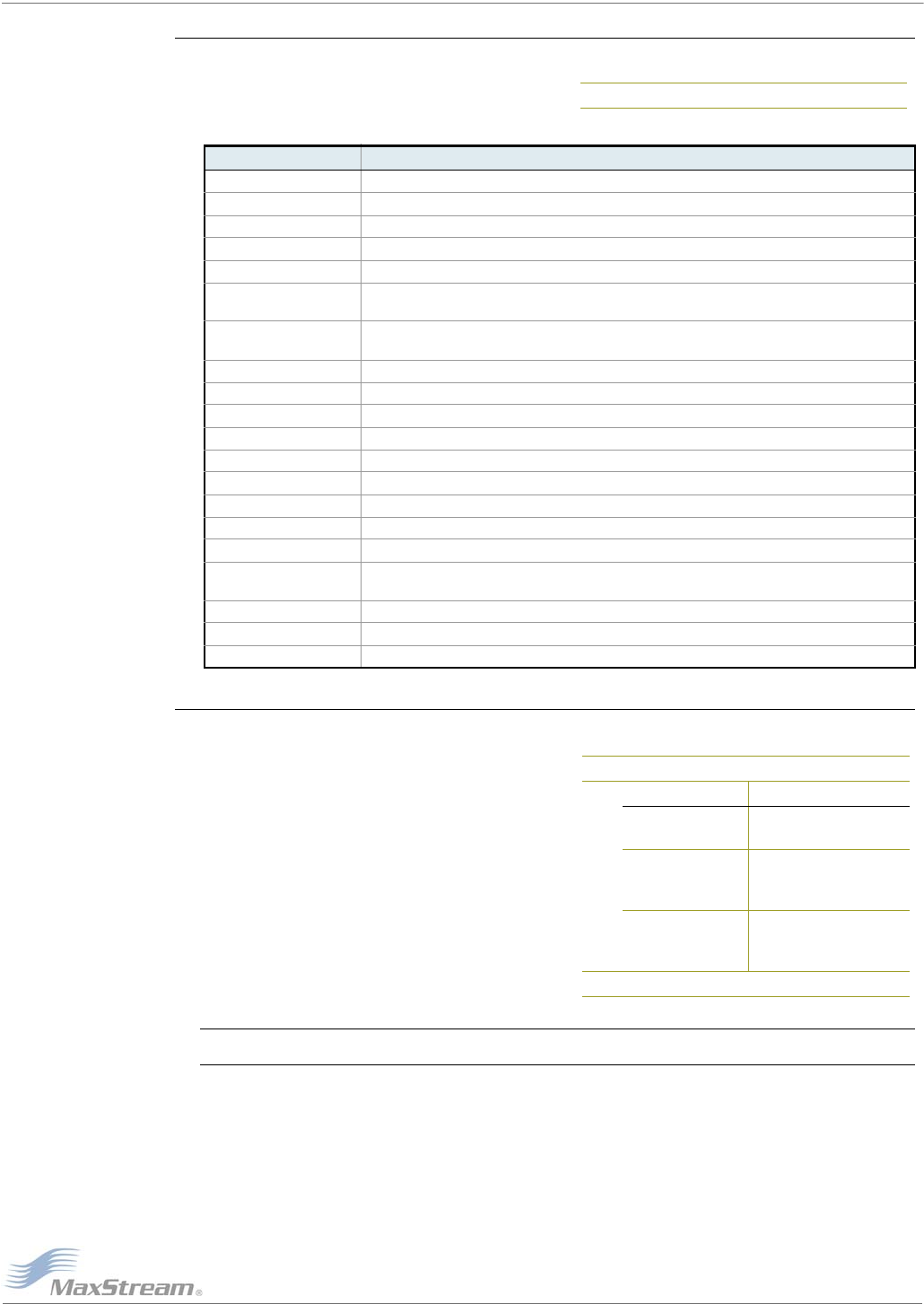
XBee™/XBee‐PROOEMRFModules–ProductManualv1.x7CBETA[2005.12.02]
©2005MaxStream,Inc.,Confidential&Proprietary‐AllRightsReserved 29
AI (Association Indication) Command
<Networking {Association}> The AI command is
used to indicate occurrences of errors during the
last association request.
Use the table below to determine meaning of the returned values.
AP (API Enable) Command
<Serial Interfacing> The AP command is used to
enable the RF module to operate using frame-
based API operation.
Refer to the “API Operation” section [p43] when API operation is enabled (AP = 2 or 3).
Returned Value (Hex) Association Indication
0x00 Successful Completion - Coordinator successfully started or End Device association complete
0x01 Active Scan Timeout
0x02 Active Scan found no PANs
0x03 Active Scan found PAN, but the Coordinator Allow Association bit is not set
0x04 Active Scan found PAN, but Coordinator and End Device are not configured to support beacons
0x05 Active Scan found PAN, but the Coordinator ID (PAN ID) parameter does not match the ID parameter of
the End Device
0x06 Active Scan found PAN, but the Coordinator CH (Channel) parameter does not match the CH parameter
of the End Device
0x07 Energy Scan Timeout
0x08 Coordinator start request failed
0x09 Coordinator could not start due to Invalid Parameter
0x0A Coordinator Realignment is in progress
0x0B Association Request not sent
0x0C Association Request timed out - no reply was received
0x0D Association Request had an Invalid Parameter
0x0E Association Request Channel Access Failure - Request was not transmitted - CCA failure
0x0F Remote Coordinator did not send an ACK after Association Request was sent
0x10 Remote Coordinator did not reply to the Association Request, but an ACK was received after sending the
request
0x11 [reserved]
0x12 Sync-Loss - Lost synchronization with a Beaconing Coordinator
0x13 Disassociated - No longer associated to Coordinator
AT Command: ATAI
Parameter Range: 0 - 0x13 [read-only]
AT Command: ATAP
Parameter Range: 0 - 2
Parameter Configuration
0Disabled
(UART operation)
1
API enabled
(w/out escaped
characters)
2
API enabled
(with escaped
characters)
Default Parameter Value:0
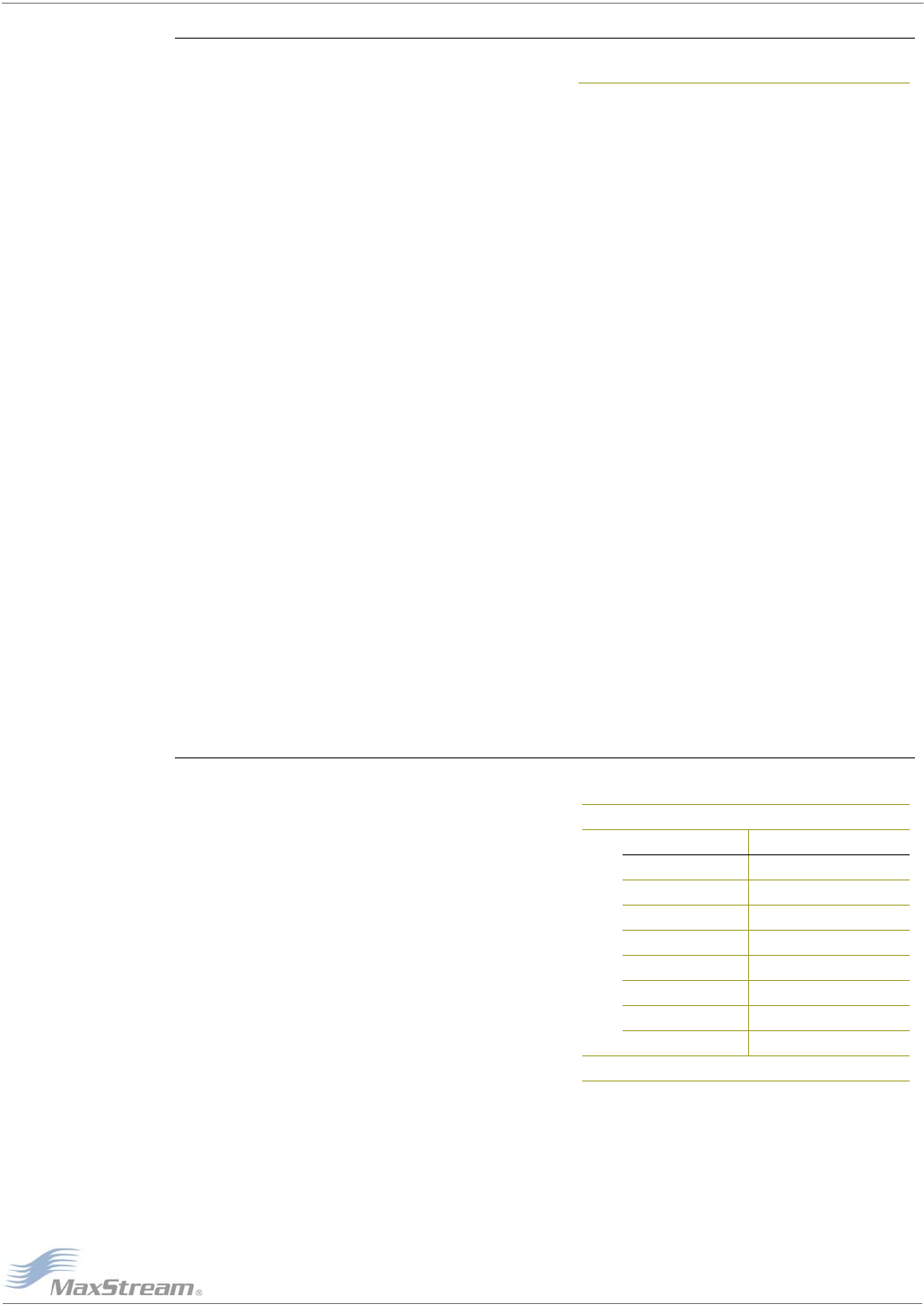
XBee™/XBee‐PROOEMRFModules–ProductManualv1.x7CBETA[2005.12.02]
©2005MaxStream,Inc.,Confidential&Proprietary‐AllRightsReserved 30
AS (Active Scan) Command
<AT Command Mode Options> The AS command
is used to send a Beacon Request to a Broadcast
Address (0xFFFF) on every channel. The AS
parameter determines the amount of time the module will listen for Beacons on each channel. A
PanDescriptor is created and returned for every Beacon received from the scan. Each PanDescrip-
tor contains the following information:
CoordAddress (SH + SL parameters)<CR>
CoordPanID (ID parameter)<CR>
CoordAddrMode <CR>
0x02 = 16-bit Short Address
0x03 = 64-bit Long Address
Channel (CH parameter) <CR>
SecurityUse<CR>
ACLEntry<CR>
SecurityFailure<CR>
SuperFrameSpec<CR> (2 bytes):
bit 15 - Association Permitted (MSB)
bit 14 - PAN Coordinator
bit 13 - Reserved
bit 12 - Battery Life Extension
bits 8-11 - Final CAP Slot
bits 4-7 - Superframe Order
bits 0-3 - Beacon Order
GtsPermit<CR>
RSSI<CR> (- RSSI is returned as -dBm)
TimeStamp<CR> (3 bytes)
<CR>
The carriage return <CR> is sent at the end of the AS command. The Active Scan is capable of
returning up to 5 PanDescriptors in a scan. The actual scan time on each channel is measured as
Time = [(2 ^ PARAM) * 15.36] ms. Note the total scan time is this time multiplied by the number
of channels to be scanned (16 for the XBee and 13 for the XBee-PRO). Refer to the SD command
description for more information.
BD (Interface Data Rate) Command
<Serial Interfacing> The BD command is used to
set and read the serial interface data rate (baud
rate) used between the RF modem and host. This
parameter determines the rate at which serial
data is sent to the RF modem from the host. Mod-
ified interface data rates do not take effect until
the CN (Exit AT Command Mode) command is
issued and the system returns the 'OK' response.
When parameters 0-7 are sent to the RF modem,
the respective interface data rates are used (as
shown in the table on the right).
The RF data rate is not affected by the BD param-
eter. If the interface data rate is set higher than
the RF data rate, a flow control configuration may
need to be implemented.
Non-standard Interface Data Rates:
When parameter values outside the range of standard baud rates are sent, the closest interface
data rate represented by the number is stored in the BD register. For example, a rate of 19200
bps can be set by sending the following command line "ATBD4B00". NOTE: When using Max-
Stream’s X-CTU Software, non-standard interface data rates can only be set and read using the X-
CTU ‘Terminal’ tab. Non-standard rates are not accessible through the ‘Modem Configuration’ tab.
AT Command: ATAS
AT Command: ATBD
Parameter Range: 0 - 7 (standard rates)
Parameter Configuration (bps)
0 1200
1 2400
2 4800
3 9600
4 19200
5 38400
6 57600
7 115200
Default Parameter Value:3
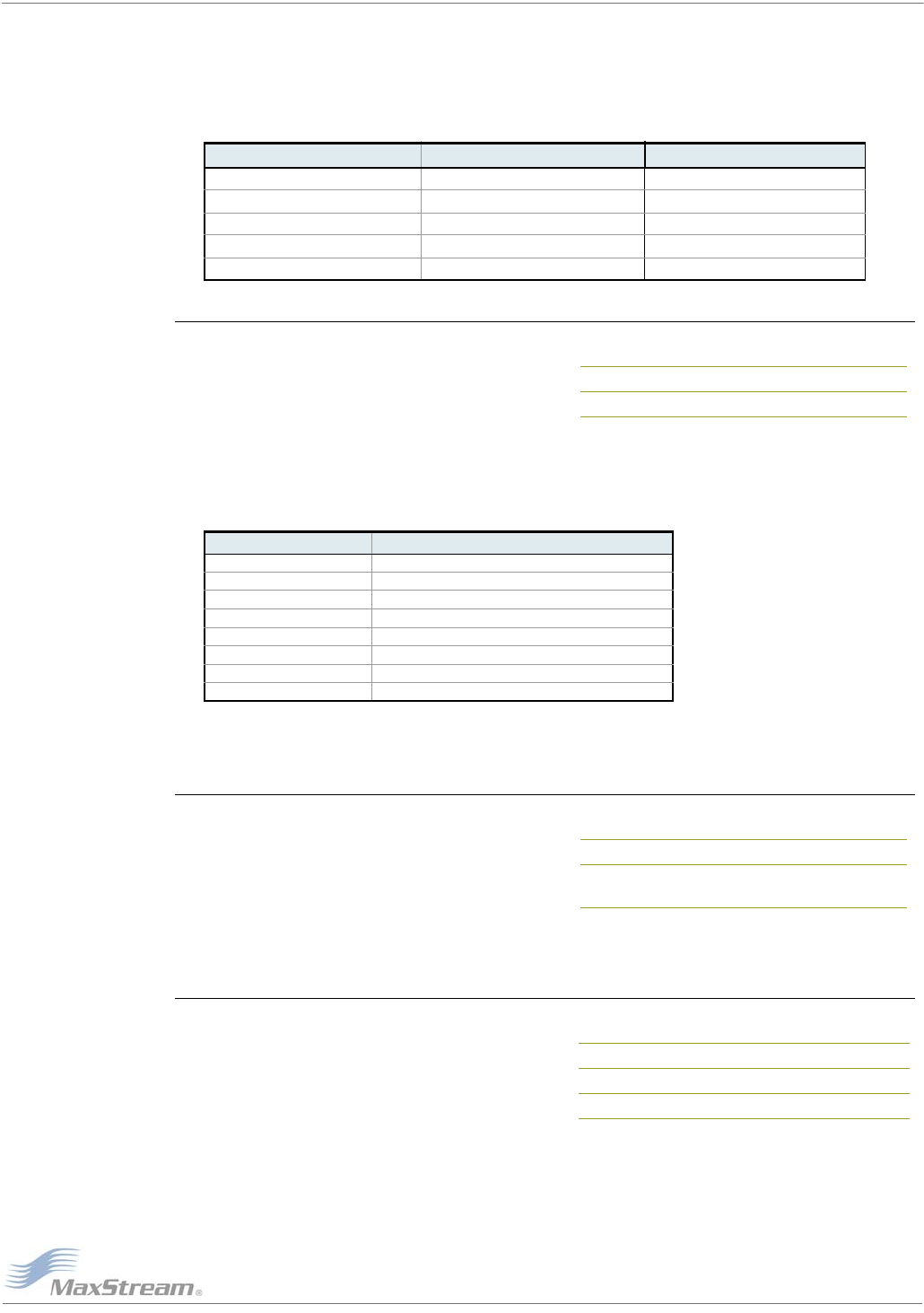
XBee™/XBee‐PROOEMRFModules–ProductManualv1.x7CBETA[2005.12.02]
©2005MaxStream,Inc.,Confidential&Proprietary‐AllRightsReserved 31
When the BD command is sent with a non-standard interface data rate, the UART will adjust to
accommodate the requested interface rate. In most cases, the clock resolution will cause the
stored BD parameter to vary from the parameter that was sent (refer to the table below). Reading
the BD command (send "ATBD" command without an associated parameter value) will return the
value that was actually stored to the BD register.
BE (Beacon Order) Command
<Networking {Association} - Beacon-enabled
Firmware Only> The BE command is used to set
and read the exponent used in the formula that
determines beacon order. The beacon order
specifies how often the coordinator transmits a
beacon.
The actual time is calculated from BE as:
Time (msec) = (2 ^ BE) * 15.36 ms.
End devices automatically update their BE parameter values to match the coordinator upon asso-
ciation.
CA (CCA Threshold) Command
<RF Interfacing> The CA command is used to set
and read the CCA (Clear Channel Assessment)
threshold.
Prior to transmitting a packet, a CCA is performed
to detect energy on the transmit channel. If the
detected energy is above the CCA Threshold, the
radio will not transmit the packet.
CC (Command Sequence Character) Command
<AT Command Mode Options> The CC command
is used to set and read the ASCII character used
between guard times of the AT Command Mode
Sequence (GT + CC + GT). This sequence enters
the RF module into AT Command Mode so that
data entering the modem from the host is recog-
nized as commands instead of payload.
Refer to the Command Mode section [p20] for more information regarding the AT Command Mode
Sequence.
Table3‐07. ParametersSentVersusParametersStored
BD Parameter Sent (HEX) Interface Data Rate (bps) BD Parameter Stored (HEX)
0 1200 0
4 19,200 4
7 115,200 7
12C 300 12B
1C200 115,200 1B207
Table3‐08. BeaconIntervalTimes
BE Parameter Value Time
0 15.36 milliseconds
2 61.44 milliseconds
4 245.80 milliseconds
6 983.00 milliseconds
8 3.93 seconds
10 15.73 seconds
12 62.91 seconds
14 4.19 minutes
AT Command: ATBE
Parameter Range: 0 - 0x0E [exponent]
Default Parameter Value: 2
AT Command: ATCA
Parameter Range: 0 - 0x50 [-dBm]
Default Parameter Value: 0x4B
(-75 dBm (decimal))
AT Command: ATCC
Parameter Range: 0 - 0xFF
Default Parameter Value: 0x2B (ASCII “+”)
Related Commands: GT (Guard Times)
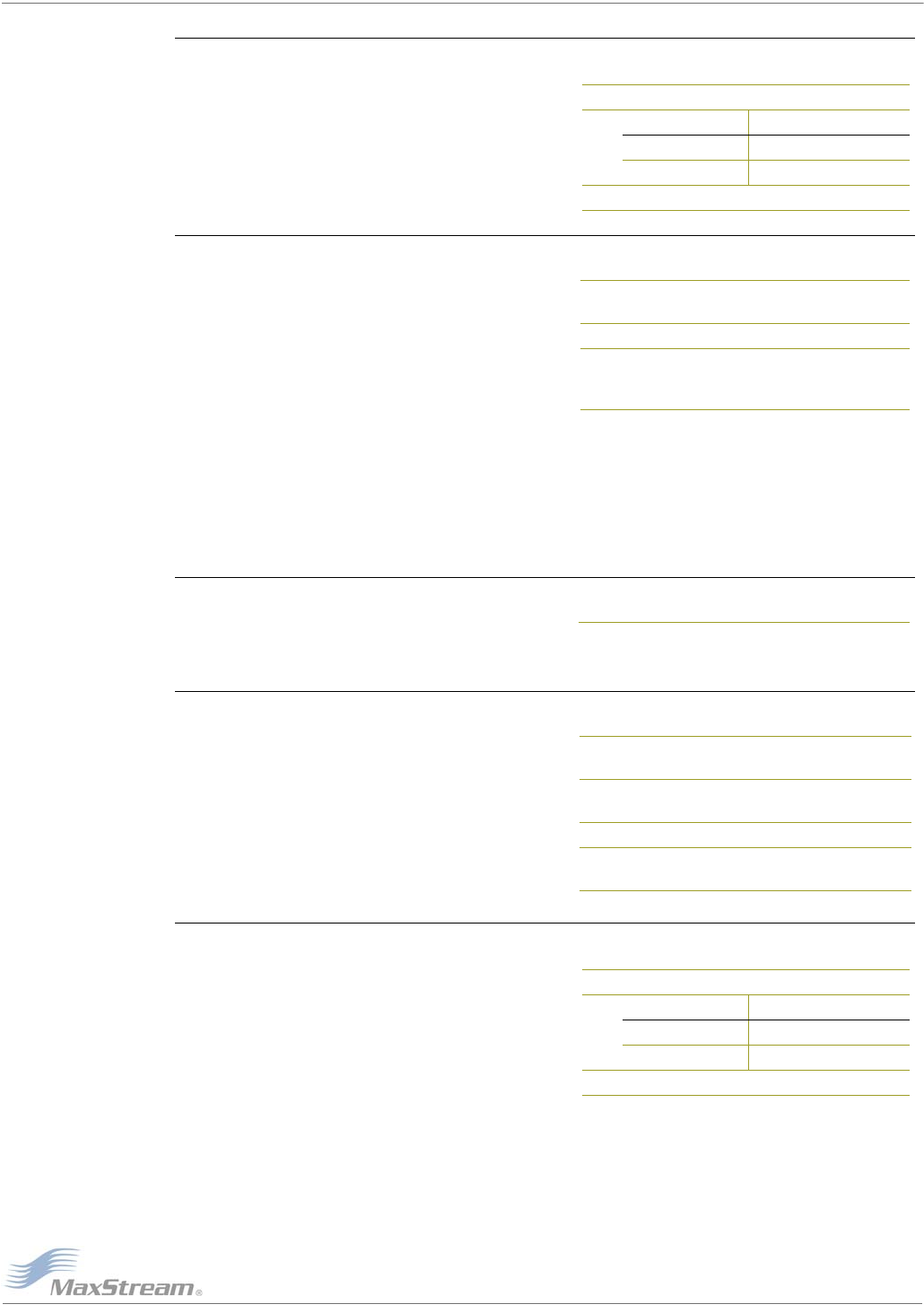
XBee™/XBee‐PROOEMRFModules–ProductManualv1.x7CBETA[2005.12.02]
©2005MaxStream,Inc.,Confidential&Proprietary‐AllRightsReserved 32
CE (Coordinator Enable) Command
<Serial Interfacing> The CE command is used to
set and read the behavior (End Device vs. Coordi-
nator) of the module.
CH (Channel) Command
<Networking {Addressing}> The CH command is
used to set and read the channel on which RF
connections are made between RF modules. The
channel is one of three filtration layers available
to the RF module. The other layers are the PAN
ID (ID command) and destination addresses (DL
& DH commands).
In order for RF modules to communicate with
each other, the RF modules must share the same channel number. Different channels can be used
to prevent RF modules in one network from listening to transmissions of another.
The RF module uses channel numbers of the 802.15.4 standard.
Center Frequency = 2.405 + (CH - 11d) * 5 MHz (d = decimal)
Refer to the “Addressing” section [p16] for more information.
CN (Exit AT Command Mode) Command
<AT Command Mode Options> The CN command
is used to explicitly exit the RF module from AT
Command Mode.
CT (Command Mode Timeout) Command
<AT Command Mode Options> The CT command
is used to set and read the amount of inactive
time that elapses before the RF module automati-
cally exits from AT Command Mode and returns
to Idle Mode.
Use the CN (Exit AT Command Mode) command
to exit AT Command Mode manually.
D5 (DIO5 Configuration) Command
<Serial Interfacing> The D5 command is used to
configure options for the DIO5 line of the RF mod-
ule. When the D5 parameter is set to “1”, the D5
line is used to indicate “Association (membership
with another RF module)” by causing the LED
indicator to blink.
AT Command: ATCE
Parameter Range: 0 - 1
Parameter Configuration
0End Device
1Coordinator
Default Parameter Value:0
AT Command: ATCH
Parameter Range: 0x0B - 0x1A (XBee)
0x0C - 0x18 (XBee-PRO)
Default Parameter Value: 0x0C (12 decimal)
Related Commands: ID (PAN ID), DL
(Destination Address Low, DH (Destination
Address High)
AT Command: ATCN
AT Command: ATCT
Parameter Range: 2 - 0xFFFF
[x 100 milliseconds]
Default Parameter Value: 0x64 (100 decimal,
which equals 10 decimal seconds)
Number of bytes returned: 2
Related Command: CN (Exit AT Command
Mode)
AT Command: ATD5
Parameter Range: 0 - 1
Parameter Configuration
0Disabled
1 RSSI
Default Parameter Value:1
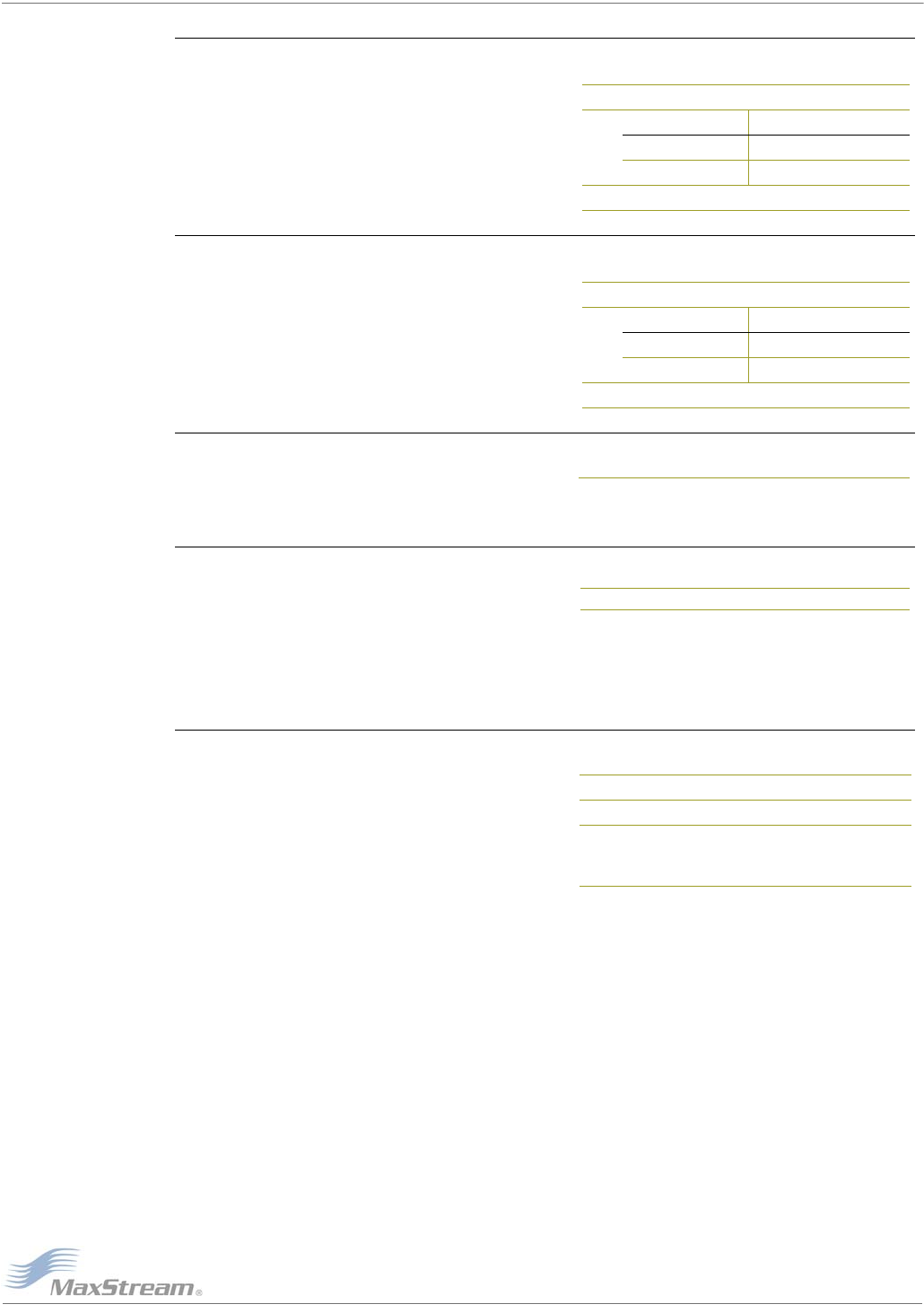
XBee™/XBee‐PROOEMRFModules–ProductManualv1.x7CBETA[2005.12.02]
©2005MaxStream,Inc.,Confidential&Proprietary‐AllRightsReserved 33
D6 (DIO6 Configuration) Command
<Serial Interfacing> The D6 command is used to
set and read the behavior of the DIO6 line. This
line can be configured to enable RTS flow control.
D7 (DIO7 Configuration) Command
<Serial Interfacing> The D7 command is used to
set and read the behavior of the DIO7 line. CTS
flow control is enabled by default.
DA (Force Disassociation) Command
<(Special)> The DA command is used to immedi-
ately disassociate an End Device from a Coordi-
nator and reattempt to associate.
DB (Received Signal Strength) Command
<Diagnostics> DB parameter is used to read the
received signal strength (in dBm) of the last RF
packet received. Reported values are accurate
between -40 dBm and the RF module's receiver sensitivity.
Absolute values are reported. For example: 0x58 = -88 dBm (decimal). If no packets have been
received (since last reset, power cycle or sleep event), “0” will be reported.
DH (Destination Address High) Command
<Networking {Addressing}> The DH command is
used to set and read the upper 32 bits of the RF
module's 64-bit destination address. When com-
bined with the DL (Destination Address Low)
parameter, it defines the destination address
used for transmission.
An RF module will only communicate with other
RF modules having the same channel (CH param-
eter), PAN ID (ID parameter) and destination address
(DH + DL parameters).
To transmit using a 16-bit address, set the DH parameter to zero and the DL parameter less than
0xFFFF. 0x000000000000FFFF (DL concatenated to DH) is the broadcast address for the PAN.
Refer to the “Addressing” section [p16] for more information.
AT Command: ATD6
Parameter Range: 0 - 1
Parameter Configuration
0Disabled
1 RTS Flow Control
Default Parameter Value:0
AT Command: ATD7
Parameter Range: 0 - 1
Parameter Configuration
0Disabled
1CTS Flow Control
Default Parameter Value:1
AT Command: ATDA
AT Command: ATDB
Parameter Range: 0 - 0x64 [read-only]
AT Command: ATDH
Parameter Range: 0 - 0xFFFFFFFF
Default Parameter Value: 0
Related Commands: DL (Destination Address
Low), CH (Channel), ID (PAN VID), MY (Source
Address)
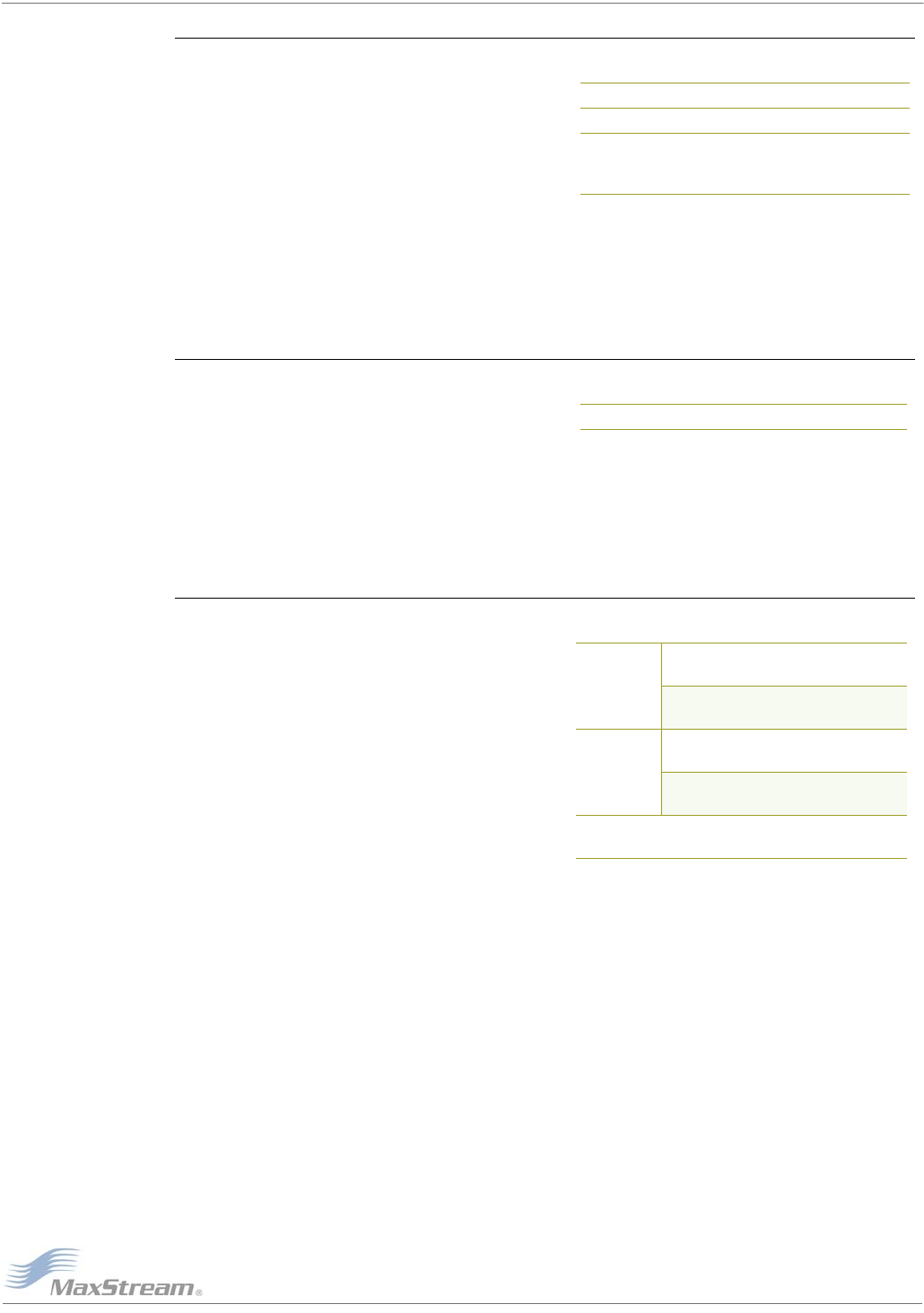
XBee™/XBee‐PROOEMRFModules–ProductManualv1.x7CBETA[2005.12.02]
©2005MaxStream,Inc.,Confidential&Proprietary‐AllRightsReserved 34
DL (Destination Address Low) Command
<Networking {Addressing}> The DL command is
used to set and read the lower 32 bits of the RF
module's 64-bit destination address. When com-
bined with the DH (Destination Address High)
parameter, it defines the destination address
used for transmission.
An RF module will only communicate with other
RF modules having the same channel (CH param-
eter), PAN ID (ID parameter) and destination address (DH + DL parameters).
To transmit using a 16-bit address, set the DH parameter to zero and the DL parameter less than
0xFFFF. 0x000000000000FFFF (DL concatenated to DH) is the broadcast address for the PAN.
Refer to the “Addressing” section [p16] for more information.
DM (Destination Modem) Command
<Networking {Identification}> The DM command
is used to resolve a MI (Modem Identifier) string
to a physical address. The following events occur
upon successful command execution:
1. DL and DH are set to the address of the modem with the matching Modem Identifier.
2. ‘OK’ is returned.
If there is no response from a modem within 200 msec or a parameter is not specified (left blank),
the command is terminated and an ‘ERROR’ message is returned.
DP (Disassociation Cyclic Sleep Period) Command
<Sleep Mode (Low Power)>
NonBeacon Firmware
End Device - The DP command is used to set and
read the time period of sleep for cyclic sleeping
remotes that are configured for Association but
are not associated to a Coordinator. (i.e. If a
device is configured to associate, configured as a
Cyclic Sleep remote, but does not find a Coordi-
nator, it will sleep for DP time before reattempt-
ing association.) Maximum sleep period is 268
seconds (0x68B0).
DP should be > 0 for NonBeacon systems.
Beacon-enabled Firmware
End Device - The DP command is used to set and read the number of beacons the cyclic sleeping
remote will sleep through on a failed association attempt before reattempting association. (i.e. If a
device is configured for Association, configured as a Cyclic Sleep remote, and unable to find a
Coordinator; it will sleep for DP beacon times prior to reattempting association.)
SD is used to determine the beacon time since the device, in this mode, is not associated to a
Coordinator. This command may help reduce power consumption if a Coordinator is not found, or
if the Coordinator beacons are not detected for an extended period of time. Maximum sleep period
is 268 seconds. Therefore, DP must be selected such that the equation (2^SD * (0.01536 sec-
onds) * DP) < 268 seconds.
AT Command: ATDL
Parameter Range: 0 - 0xFFFFFFFF
Default Parameter Value: 0
Related Commands: DH (Destination Address
High), CH (Channel), ID (PAN VID), MY (Source
Address)
AT Command: ATDM
Parameter Range: 20 Byte ASCII String
AT Command: ATDP
Parameter
Range:
NonBeacon Firmware:
1 - 0x68B0 [x 10 milliseconds]
Beacon-enabled Firmware:
1 - 0x68B0 [beacons]
Default
Parameter
Value:
NonBeacon Firmware: 0x3E8
(1000 decimal)
Beacon-enabled Firmware: 0x14
(20 decimal)
Related Commands: SM (Sleep Mode), SP
(Cyclic Sleep Period), ST (Time before Sleep)
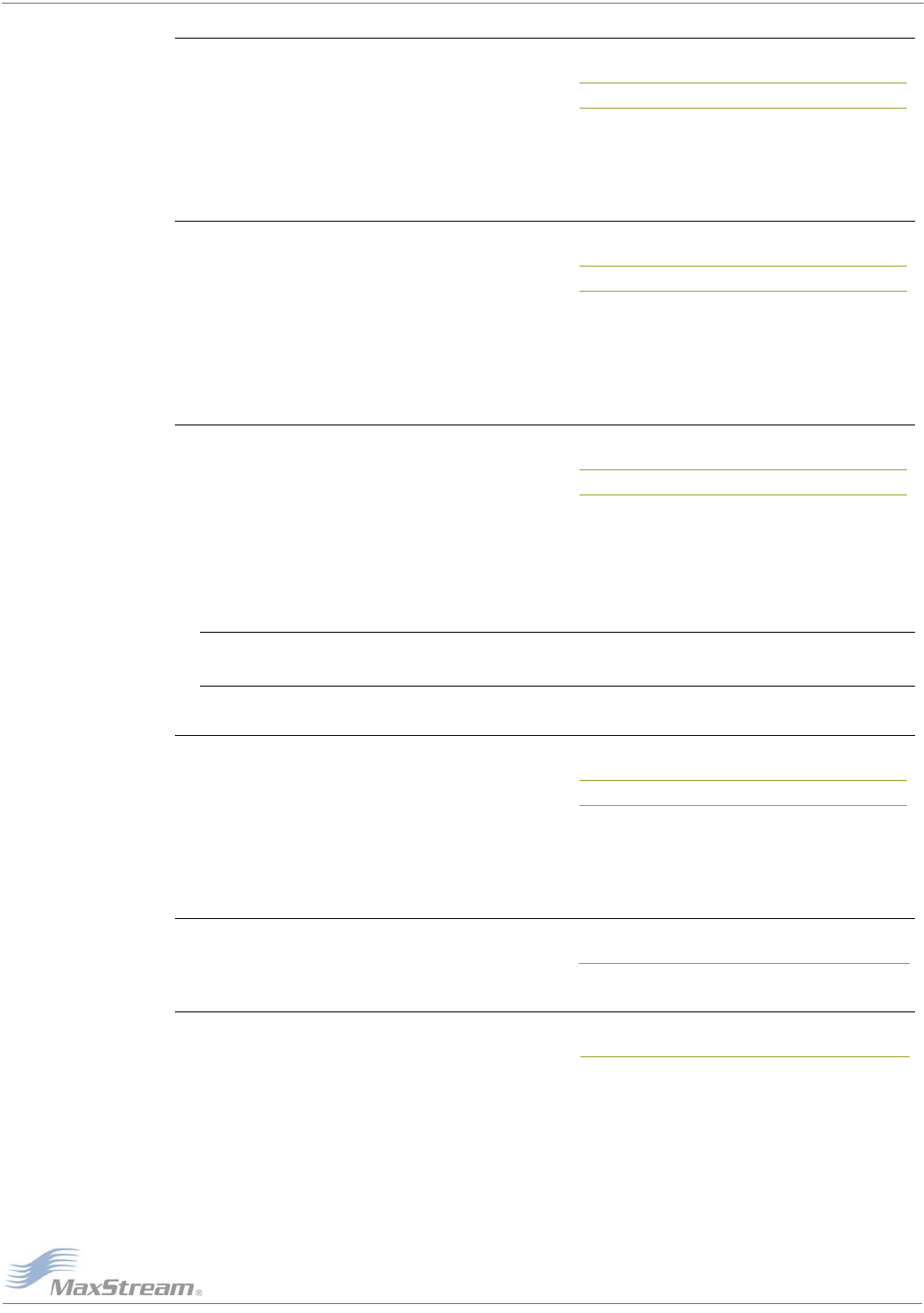
XBee™/XBee‐PROOEMRFModules–ProductManualv1.x7CBETA[2005.12.02]
©2005MaxStream,Inc.,Confidential&Proprietary‐AllRightsReserved 35
EA (ACK Failures) Command
<Diagnostics> The EA command is used to reset
and read the count of ACK (acknowledgement)
failures. This parameter value increments when
the module expires its transmission retries with-
out receiving an ACK on a packet transmission. This count saturates at its maximum value.
Set the parameter to “0” to reset count.
EC (CCA Failures) Command
<Diagnostics> The EC command is used to read
and reset the count of CCA (Clear Channel
Assessment) failures. This parameter value incre-
ments when the module does not transmit a
packet because it detected energy above the CCA threshold level (set with CA command). This
count saturates at its maximum value.
Set the EC parameter to “0” to reset count.
ED (Energy Scan) Command
<Networking {Association}> The ED command is
used to send an “Energy Detect Scan”. This
parameter determines the length of scan on each
channel. The maximal energy on each channel is
returned and each value is followed by a carriage return. An additional carriage return is sent at
the end of the command.
The values returned represent the detected energy level in units of -dBm. The actual scan time on
each channel is measured as Time = [(2 ^ PARAM) * 15.36] ms.
Note the total scan time is this time multiplied by the number of channels to be scanned. Also refer to
the SD (Scan Duration) table.
EH (Echo) Command
<Diagnostics> The EH command is used to send
command parameter as RF packet to remote
modem which 'echoes' back the data to the trans-
mitting modem. This command uses the current
setting of DL and DH when transmitting the parameter.
The command ends by sending a <CR> (Carriage Return).
FP (Force Poll) Command
<(Special)> The FP command is used to request
indirect messages being held by a coordinator.
FR (Software Reset) Command
<Special> The FR command is used to force a
software reset on the module. The reset simu-
lates powering off and then on again the module.
AT Command: ATEA
Parameter Range: 0 - 0xFFFF
AT Command: ATEC
Parameter Range: 0 - 0xFFFF
AT Command: ATED
Parameter Range: 0 - 7
AT Command: ATEH
Parameter Range: 1 - 20 bytes
AT Command: ATFP
AT Command: ATFR
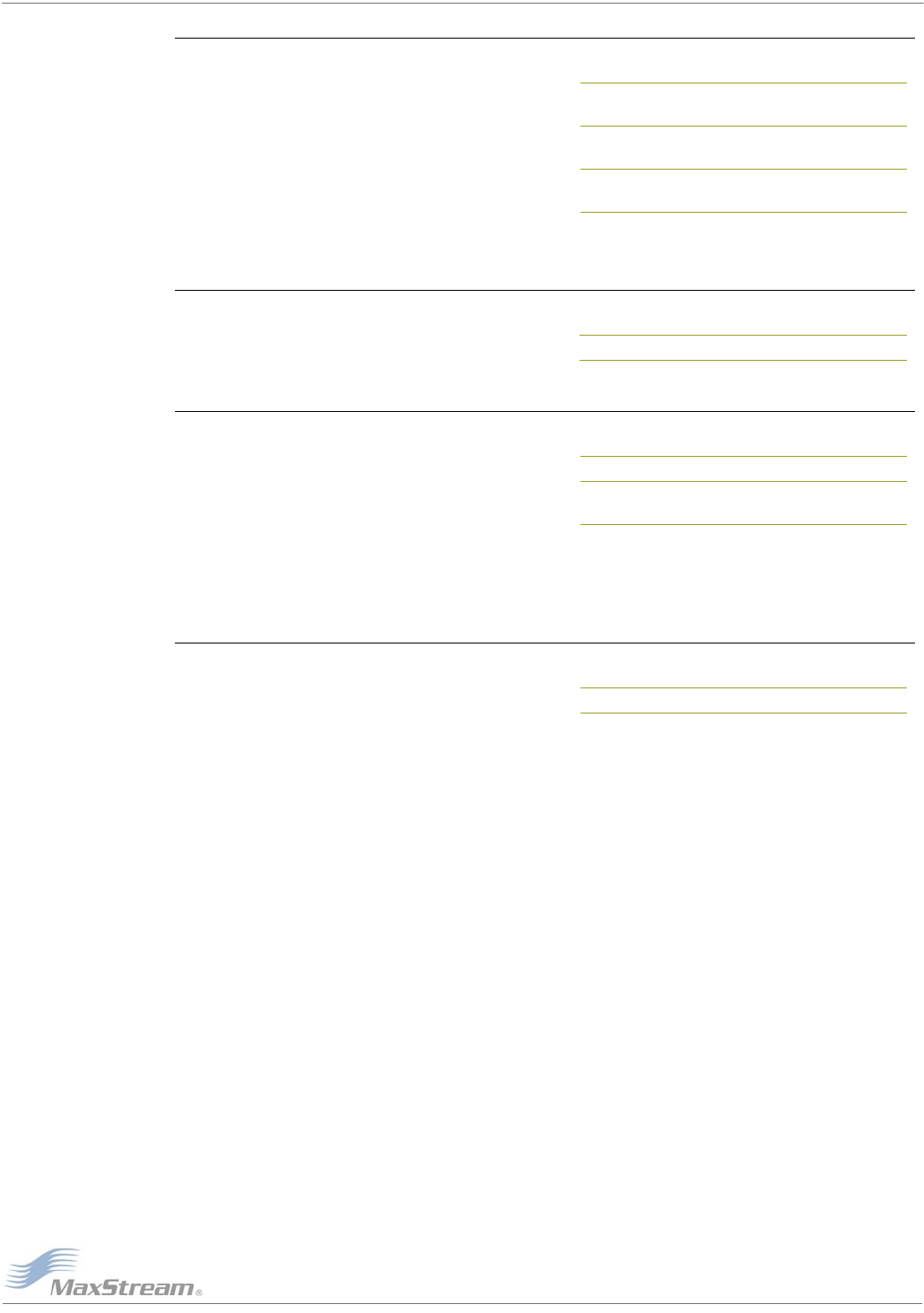
XBee™/XBee‐PROOEMRFModules–ProductManualv1.x7CBETA[2005.12.02]
©2005MaxStream,Inc.,Confidential&Proprietary‐AllRightsReserved 36
GT (Guard Times) Command
<AT Command Mode Options> GT Command is
used to set the DI (data in from host) time-of-
silence that surrounds the AT command sequence
character (CC Command) of the AT Command
Mode sequence (GT + CC + GT).
The DI time-of-silence is used to prevent inad-
vertent entrance into AT Command Mode.
Refer to the Command Mode section [p20] for
more information regarding the AT Command Mode Sequence.
HV (Hardware Version) Command
<Diagnostics> The HV command is used to read
the hardware version of the module.
ID (Pan ID) Command
<Networking {Addressing}> The ID command is
used to set and read the PAN (Personal Area Net-
work) ID of the RF module. Only RF modules with
matching PAN IDs can communicate with each
other. RF modems with non-matching PAN IDs
will not receive unintended data transmission.
Setting the ID parameter to 0xFFFF indicates a global message for all PANs.
Refer to the “Addressing” section [p16] for more information.
MD (Modem Discover) Command
<Networking {Identification}> The MD command
is used to discover and report all modems found.
MD also accepts a Modem Identifier as a parame-
ter. In this case, only a modem matching the sup-
plied identifier will respond.
The MD command causes a modem to transmit a globally addressed MD command packet. This
modem will allow responses within a 750 millisecond window. The 750 msec window is large
enough to receive all responses.
In AT Command mode, command completion is designated by a carriage return (0x0D). Since two
carriage returns end a command response, the application will receive three carriage returns at
the end of the command. If no responses are received, then only one carriage return should be
received by the application. When operating in API mode, a frame with no data and status set to
‘OK’ at the end of the command should be received. When the MD command packet is received,
the remote modem sets up a random time delay of up to 500 milliseconds before replying with a
MD response as follows:
Modem Discover Response (AT command mode format):
MY (Source Address) value<CR>
SH (Serial Number High) value<CR>
SL (Serial Number Low) value<CR>
MI (Modem Identifier) value<CR>
<CR> <- This is part of the response and not the end of command indicator.
Modem Discover Response (API format - data is binary (except for MI)):
2 bytes for MY (Source Address) value
4 bytes for SH (Serial Number High) value
4 bytes for SL (Serial Number Low) value
NULL-terminated string for MI (Modem Identifier) value (max 20 bytes w/out NULL terminator)
AT Command: ATGT
Parameter Range: 2 - 0xFFFF
[x 1 millisecond]
Default Parameter Value: 0x3E8
(1000 decimal)
Related Command: CC (Command Sequence
Character)
AT Command: ATHV
Parameter Range: 0 - 0xFFFF [Read-only]
AT Command: ATID
Parameter Range: 0 - 0xFFFF
Default Parameter Value:0x3332
(13106 decimal)
AT Command: ATMD
Parameter Range: optional - MI
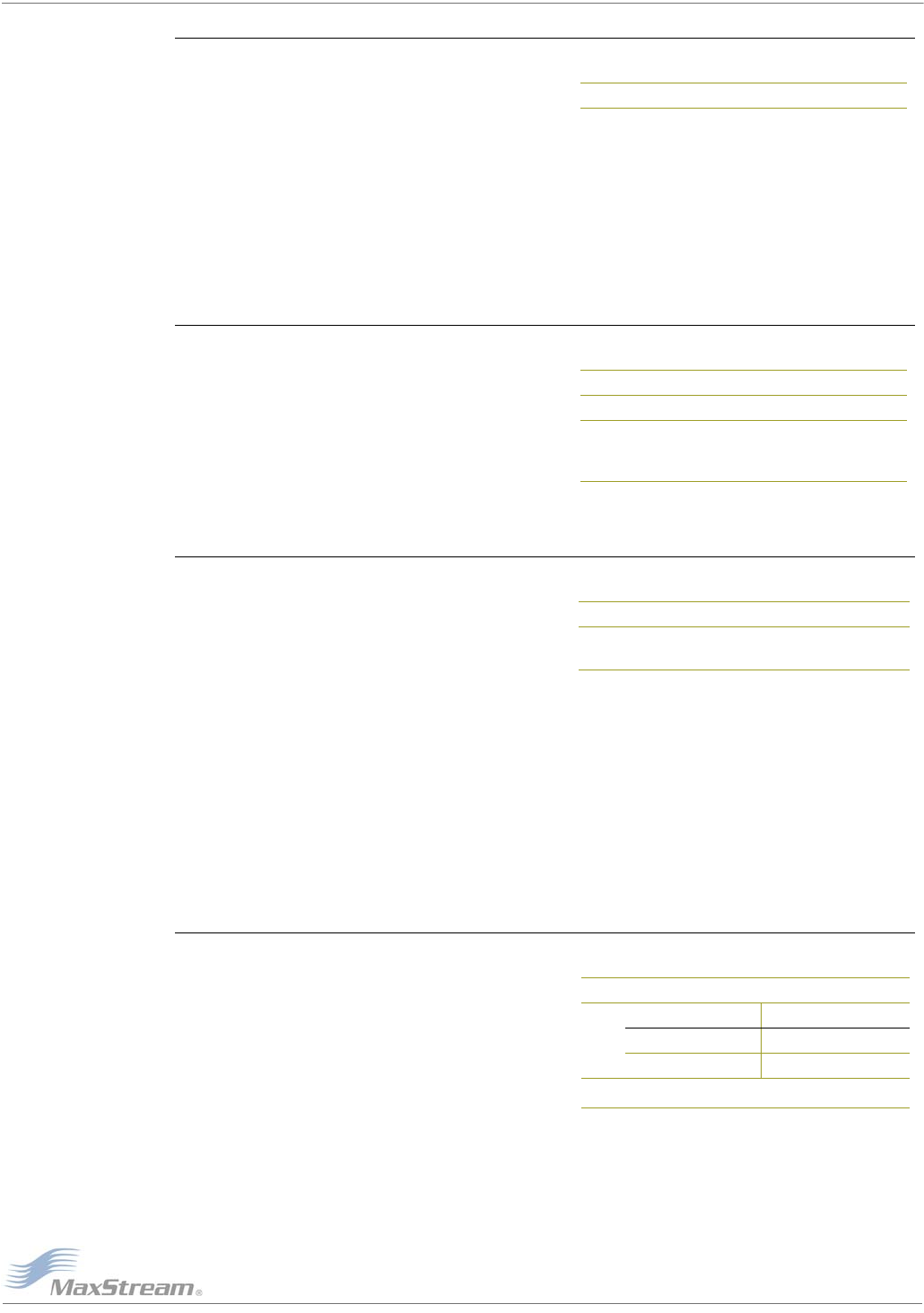
XBee™/XBee‐PROOEMRFModules–ProductManualv1.x7CBETA[2005.12.02]
©2005MaxStream,Inc.,Confidential&Proprietary‐AllRightsReserved 37
MI (Modem Identifier) Command
<Networking {Identification}> The MI command
is used to set and read a string that identifies a
particular module.
Rules:
• The register only accepts printable ASCII data.
• A string can not start with a space.
• A carriage return ends command
• Command will automatically end when maximum bytes for the string have been entered.
This string is returned as part of the MD (Modem Discover) command. This identifier is also used
with the DM (Destination Modem) command.
MY (16-bit Source Address) Command
<Networking {Addressing}> The MY command is
used to set and read the 16-bit source address of
the RF module.
By setting MY to 0xFFFF, the reception of RF
packets having a 16-bit address is disabled. The
64-bit address is the module serial number and is
always enabled.
Refer to the “Addressing” section [p16] for more information.
PE (Pull-up Resistor Enable) Command
<Serial Interfacing> The PE command is used to
set/read the bitfield to configure internal pull-up
resistor status for I/O lines. “1” specifies the pull-
up resistor is enabled. “0” specifies no pull-up.
bit 0 - AD4/DIO4/RF_TX
bit 1 - COORD
bit 2 - AD2/DIO2
bit 3 - AD1/DIO1
bit 4 - AD0/DIO0
bit 5 - RTS
bit 6 - SLEEP_RQ
bit 7 - DIN/CONFIG
For example: Sending the command “ATPE 6F” will turn bits 0, 1, 2, 3, 5 and 6 ON; and bits 4 & 7
will be turned OFF. (The binary equivalent of “0x6F” is “01101111”. Note that ‘bit 0’ is the last
digit in the bitfield.
P0 (PWM0 Configuration) Command
<Diagnostics> The P0 command is used to select
and read the function for PWM0 (Pulse Width
Modulation output 0 - pin 6).
Note: The second character in the command is a
zero (“0”), not the letter “O”.
AT Command: ATMI
Parameter Range: 20 Byte ASCII string
AT Command: ATMY
Parameter Range: 0 - 0xFFFF
Default Parameter Value: 0
Related Commands: DH (Destination Address
High), DL (Destination Address Low), CH
(Channel), ID (PAN ID)
AT Command: ATPE
Parameter Range: 0 - 0xFF
Default Parameter Value: 0xFF (all pull -up
resistors are enabled)
AT Command: ATP0
Parameter Range: 0 - 1
Parameter Configuration
0 Disabled
1RSSI PWM0 enabled
Default Parameter Value: 1
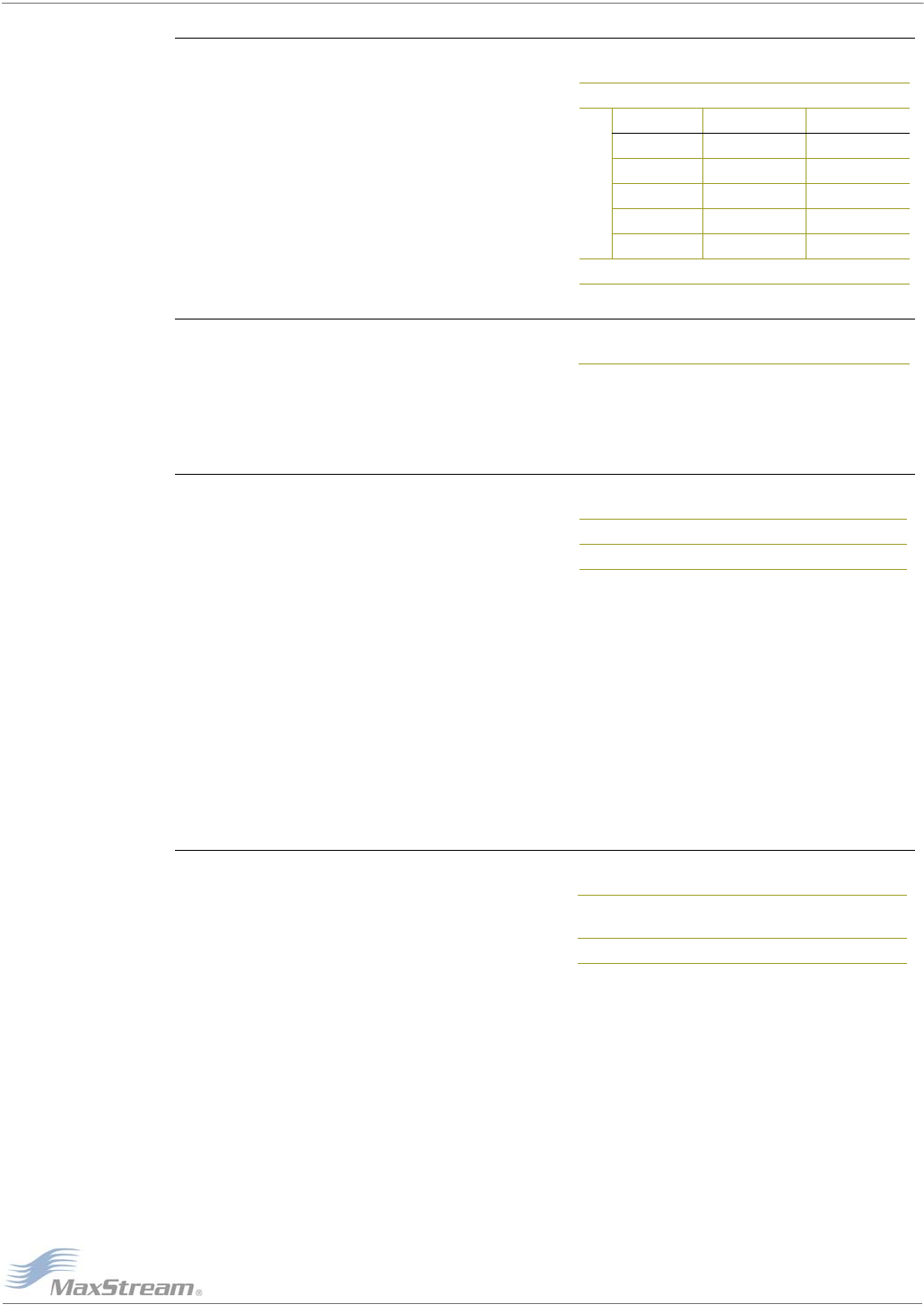
XBee™/XBee‐PROOEMRFModules–ProductManualv1.x7CBETA[2005.12.02]
©2005MaxStream,Inc.,Confidential&Proprietary‐AllRightsReserved 38
PL (Power Level) Command
<RF Interfacing> The PL command is used to
select and read the power level at which the RF
module transmits conducted power.
RE (Restore Defaults) Command
<(Special)> The RE command is used to restore
all configurable parameters to their factory
default settings. The RE command does not write
restored values to non-volatile (persistent) memory. Issue the WR (Write) command subsequent
to issuing the RE command to save restored parameter values to non-volatile memory.
RN (Random Delay Slots) Command
<Networking & Security> The RN command is
used to set and read the minimum value of the
back-off exponent in the CSMA-CA algorithm. The
CSMA-CA algorithm was engineered for collision
avoidance (random delays are inserted to prevent
data loss caused by data collisions).
If RN = 0, collision avoidance is disabled during the first iteration of the algorithm (802.15.4 -
macMinBE).
CSMA-CA stands for "Carrier Sense Multiple Access - Collision Avoidance". Unlike CSMA-CD (reacts
to network transmissions after collisions have been detected), CSMA-CA acts to prevent data colli-
sions before they occur. As soon as a modem receives a packet that is to be transmitted, it checks
if the channel is clear (no other modem is transmitting). If the channel is clear, the packet is sent
over-the-air. If the channel is not clear, the RF module waits for a randomly selected period of
time, then checks again to see if the channel is clear. After a time, the process ends and the data
is lost.
RO (Packetization Timeout) Command
<Serial Interfacing> RO command is used to set
and read the number of character times of inter-
character delay required before transmission.
RF transmission commences when data is
detected in the DI (data in from host) buffer and
RO character times of silence are detected on the
UART receive lines (after receiving at least 1 byte).
RF transmission will also commence after 100 bytes (maximum packet size) are received in the DI
buffer.
Set the RO parameter to '0' to transmit characters as they arrive instead of buffering them into
one RF packet.
AT Command: ATPL
Parameter Range: 0 - 4
Parameter XBee XBee-Pro
0 -10 dBm 10 dBm
1 -6 dBm 12 dBm
2 -4 dBm 14 dBm
3 -2 dBm 16 dBm
4 0 dBm 18 dBm
Default Parameter Value: 4
AT Command: ATRE
AT Command: ATRN
Parameter Range: 0 - 3 [exponent]
Default Parameter Value: 0
AT Command: ATRO
Parameter Range: 0 - 0xFF
[x character times]
Default Parameter Value: 3
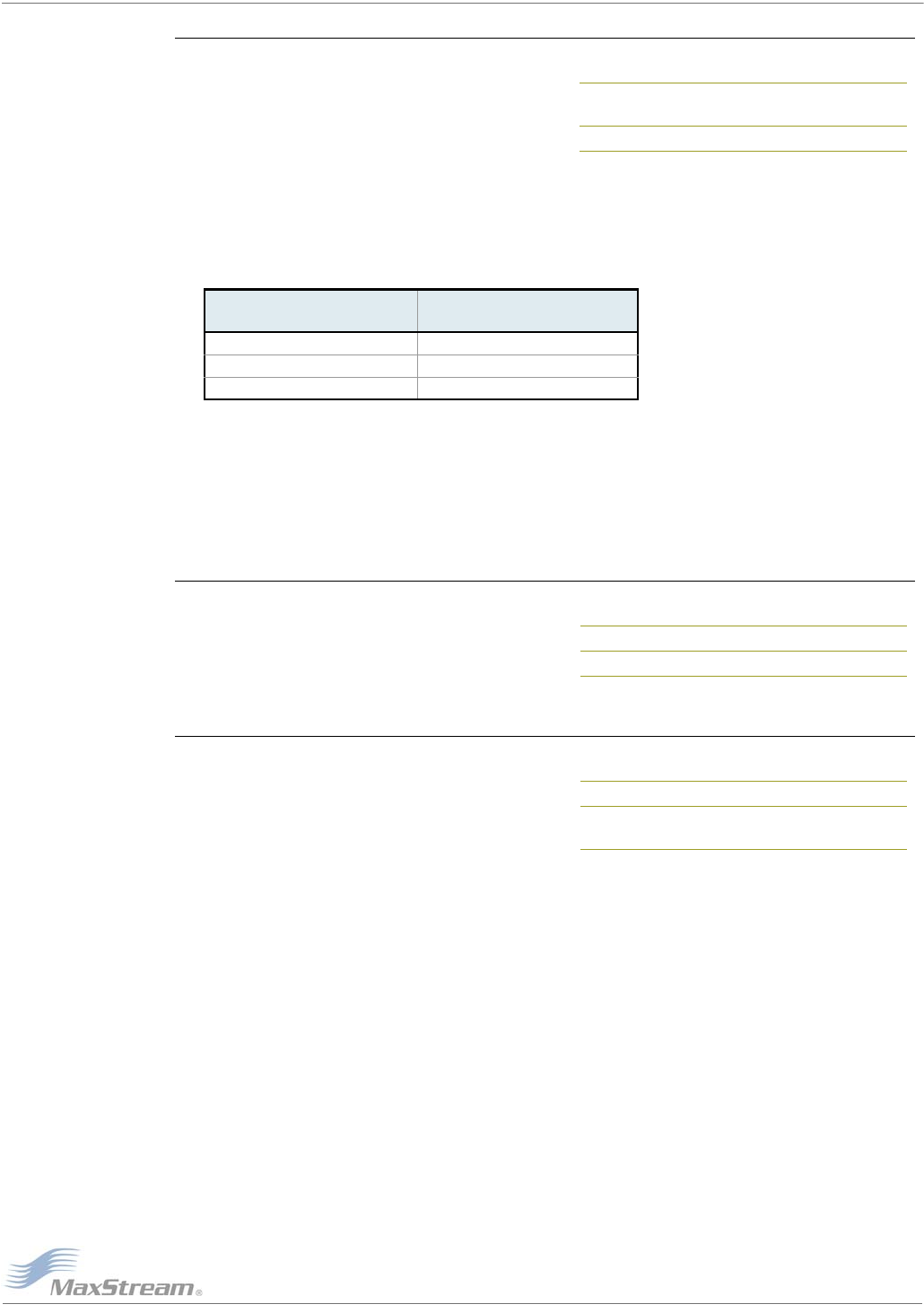
XBee™/XBee‐PROOEMRFModules–ProductManualv1.x7CBETA[2005.12.02]
©2005MaxStream,Inc.,Confidential&Proprietary‐AllRightsReserved 39
RP (RSSI PWM Timer) Command
<Diagnostics> The RP command is used to
enable PWM (Pulse Width Modulation) output on
the RF module. The output is calibrated to show
the level a received RF signal is above the sensi-
tivity level of the RF module. The PWM pulses
vary from zero to 95 percent. Zero to twenty-nine
percent means the received RF signal is at or below the published sensitivity level of the RF mod-
ule. The following table shows levels above sensitivity and PWM values.
The total period of the PWM output is 8.32 ms. Because there are 40 steps in the PWM output, the
minimum step size is 0.208 ms.
*PWM%=(295+(17.5*dBmabovesensitivity))/10.24
A non-zero value defines the time that the PWM output will be active with the RSSI value of the
last received RF packet. After the set time when no RF packets are received, the PWM output will
be set low (0 percent PWM) until another RF packet is received. The PWM output will also be set
low at power-up until the first RF packet is received. A parameter value of 0xFF permanently
enables the PWM output and it will always reflect the value of the last received RF packet.
SA (Resynch Attempts) Command
<Networking {Addressing} Beacon Firmware
Only> The SA command is used to set and read
the number of times an End Device will attempt
to reacquire a lost beacon before disassociating
from a Beaconing Coordinator.
SC (Scan Channel) Command
<RF Interfacing> The SC command is used to set
and read the list of channels to scan for all Active
and Energy Scans as a bit field.
This affects scans initiated in command mode [AS
(Active Scan) and ED (Energy Scan) commands]
and during End Device Association and Coordina-
tor startup:
bit 0 - 0x0B bit 8 - 0x13
bit 1 - 0x0C bit 9 - 0x14
bit 2 - 0x0D bit 10 - 0x15
bit 3 - 0x0E bit 11 - 0x16
bit 4 - 0x0F bit 12 - 0x17
bit 5 - 0x10 bit 13 - 0x18
bit 6 - 0x11 bit 14 - 0x19
bit 7 - 0x12 bit 15 - 0x1A
Table3‐09. PWMPercentages
dB above Sensitivity PWM percentage*
(high period / total period)
10 46.0%
20 63.0%
30 80.1%
AT Command: ATRP
Parameter Range: 0 - 0xFF
[x 100 milliseconds]
Default Parameter Value: 0x28 (40 decimal)
AT Command: ATSA
Parameter Range: 0 - 0x0F [# of attempts]
Default Parameter Value: 0
AT Command: ATSC
Parameter Range: 0 - 0xFFFF [Bit Field]
Default Parameter Value: 0x3FFE (all XBee-
PRO channels)
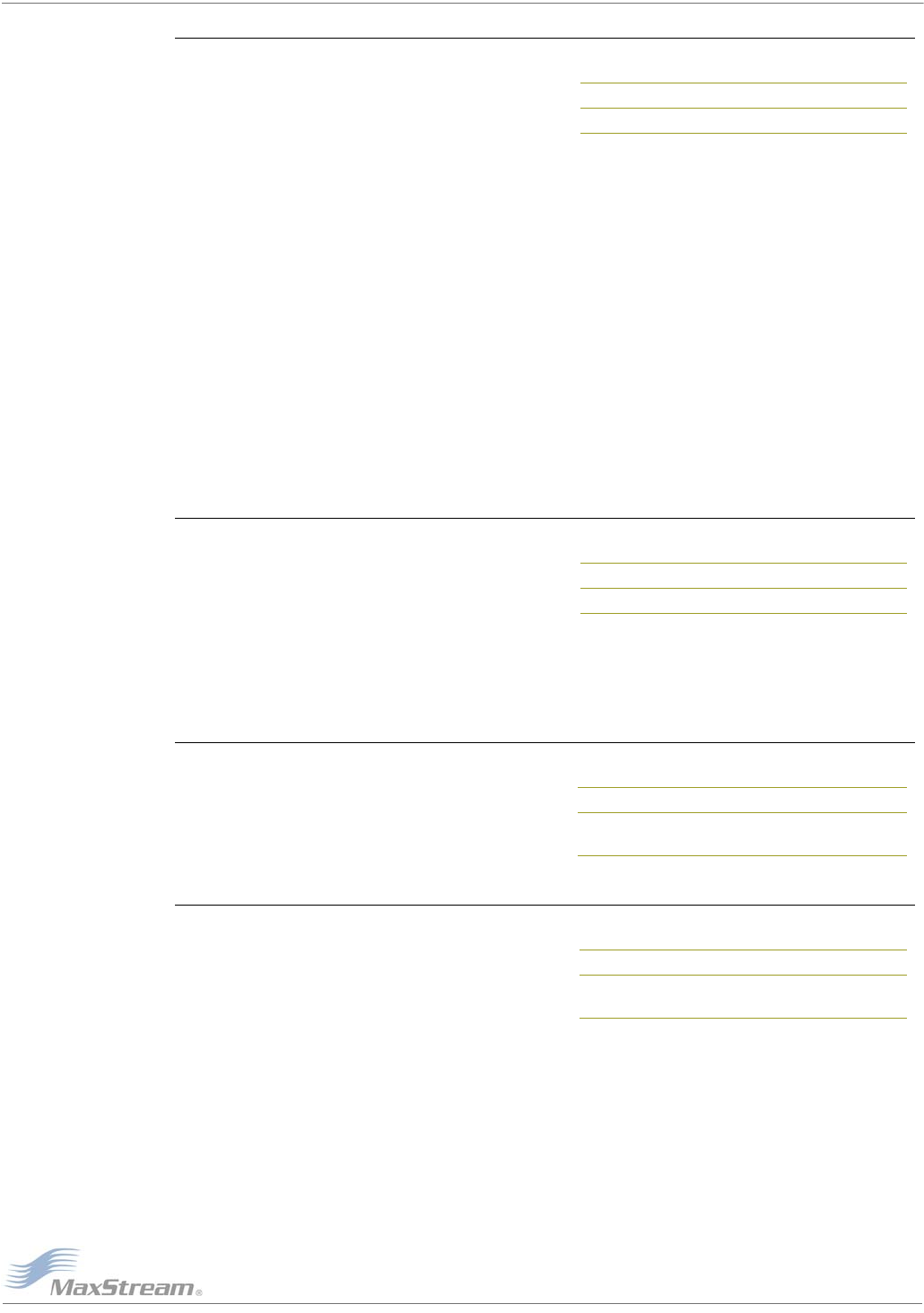
XBee™/XBee‐PROOEMRFModules–ProductManualv1.x7CBETA[2005.12.02]
©2005MaxStream,Inc.,Confidential&Proprietary‐AllRightsReserved 40
SD (Scan Duration) Command
<Networking {Association}> The SD command is
used to set and read the exponent value that
determines the duration (in time) of a scan.
End Device - Duration of Active Scan during
Association. On beacon system, set SD = BE of
coordinator. SD must be set at least to the highest BE parameter of any Beaconing Coordinator
with which an End Device or Coordinator wish to discover.
Coordinator - If the ‘ReassignPANID’ option is set on the Coordinator [refer to A2 parameter],
the SD parameter determines the length of time the Coordinator will scan channels to locate exist-
ing PANs. If the ‘ReassignChannel’ option is set, SD determines how long the Coordinator will per-
form an Energy Scan to determine which channel it will operate on.
Scan Time is measured as (# of Channels to Scan] * (2 ^ SD) * 15.36ms). The number of chan-
nels to scan is set by the SC command. The XBee module can scan up to 16 channels (SC =
0xFFFF). The XBee PRO module can scan up to 13 channels (SC = 0x3FFE).
Examples: The values below show results for a 13 channel scan:
If SD = 0, time = 0.246 sec SD = 8, time = 62.91 sec
SD = 2, time = 0.983 sec SD = 10, time = 4.19 min
SD = 4, time = 3.93 sec SD = 12, time = 16.77 min
SD = 6, time = 15.73 sec SD = 14, time = 67.07 min
SF (Superframe Order) Command
<Networking {Association} Beacon Firmware
Only> The SF command is used to set and read
the exponent used in calculating superframe
order. The superframe order specifies the length
of the active portion of the superframe (including
the beacon frame). The SF parameter should be set less than or equal to the BE parameter or
upon exiting command mode; SF will be set to equal BE.
The actual Active Period time (msec) is calculated from SF as: Time = (2 ^ SF) * 15.36 ms.
SH (Serial Number High) Command
<Diagnostics> The SH command is used to read
the high 32 bits of the RF module's unique IEEE
64-bit address.
The RF module serial number is set at the factory
and is read-only.
SL (Serial Number Low) Command
<Diagnostics> The SL command is used to read
the low 32 bits of the RF module's unique IEEE
64-bit address.
The RF module serial number is set at the factory
and is read-only.
AT Command: ATSD
Parameter Range: 0 - 0x0F
Default Parameter Value: 4
AT Command: ATSF
Parameter Range: 0 - 0x0E [exponent]
Default Parameter Value: 2
AT Command: ATSH
Parameter Range: 0 - 0xFFFFFFFF [read-only]
Related Commands: SL (Serial Number Low),
MY (Source Address)
AT Command: ATSL
Parameter Range: 0 - 0xFFFFFFFF [read-only]
Related Commands: SH (Serial Number High),
MY (Source Address)
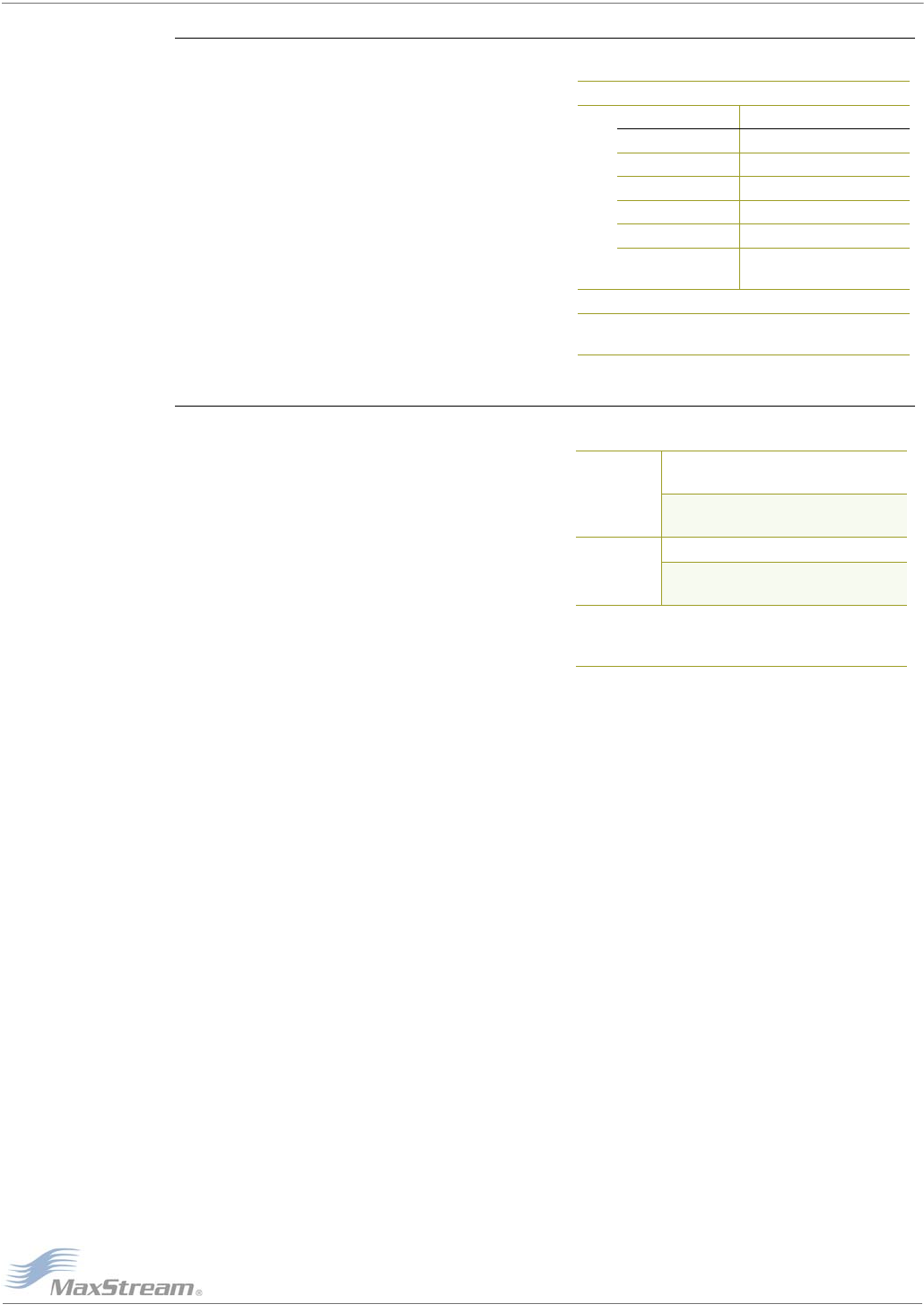
XBee™/XBee‐PROOEMRFModules–ProductManualv1.x7CBETA[2005.12.02]
©2005MaxStream,Inc.,Confidential&Proprietary‐AllRightsReserved 41
SM (Sleep Mode) Command
<Sleep Mode (Low Power)> The SM command is
used to set and read Sleep Mode settings. By
default, Sleep Modes are disabled (SM = 0) and
the RF module remains in Idle/Receive Mode.
When in this state, the RF module is constantly
ready to respond to either serial or RF activity.
SM command options vary according to the net-
working system type. By default, the module is
configured to operate in a NonBeacon system.
*Parameteroptions(1,2,3&5)arenotsupportedwhen
operatingusingBeacon‐enabledfirmware.
SP (Cyclic Sleep Period) Command
<Sleep Mode (Low Power)> The SP command is
used to set and read the duration of time in which
a remote RF module sleeps. After the cyclic sleep
period is over, the RF module wakes and checks
for data. If data is not present, the RF module
goes back to sleep. The maximum sleep period is
268 seconds (SP = 0x68B0).
The SP parameter is only valid if the RF module is
configured to operate in Cyclic Sleep (SM = 4-6).
Coordinator and End Device SP values should
always be equal.
To send Direct Messages, set SP = 0.
NonBeacon Firmware
End Device - SP determines the sleep period for cyclic sleeping remotes. Maximum sleep period is
268 seconds (0x68B0).
Coordinator - If non-zero, SP determines the time to hold an indirect message before discarding it.
A Coordinator will discard indirect messages after a period of (2.5 * SP).
Beacon-enabled Firmware
End Device - SP determines the number of beacons a cyclic sleeping remote will sleep through.
Because the maximum sleep period is 268 (decimal) seconds, SP must be selected such that the
equation (2^BE * (0.01536 seconds) * SP) < 268 seconds.
Coordinator - SP determines the number of beacons to retain an indirect message before discard-
ing it. A Coordinator will discard indirect messages after 2 * SP beacons.
AT Command: ATSM
Parameter Range: 0 - 5
Parameter Configuration
0 Disabled
1* Pin Hibernate
2* Pin Doze
3* (reserved)
4 Cyclic Sleep Remote
5* Cyclic Sleep Remote
(with Pin Wake-up)
Default Parameter Value: 0
Related Commands: SP (Cyclic Sleep Period),
ST (Time before Sleep)
AT Command: ATSP
Parameter
Range:
NonBeacon Firmware:
1 - 0x68B0 [x 10 milliseconds]
Beacon-enabled Firmware:
1 - 0x68B0 [beacons]
Default
Parameter
Value:
NonBeacon Firmware: 0
Beacon-enabled Firmware: 0x0A
(10 decimal)
Related Commands: SM (Sleep Mode), ST
(Time before Sleep), DP (Disassociation Cyclic
Sleep Period, BE (Beacon Order)
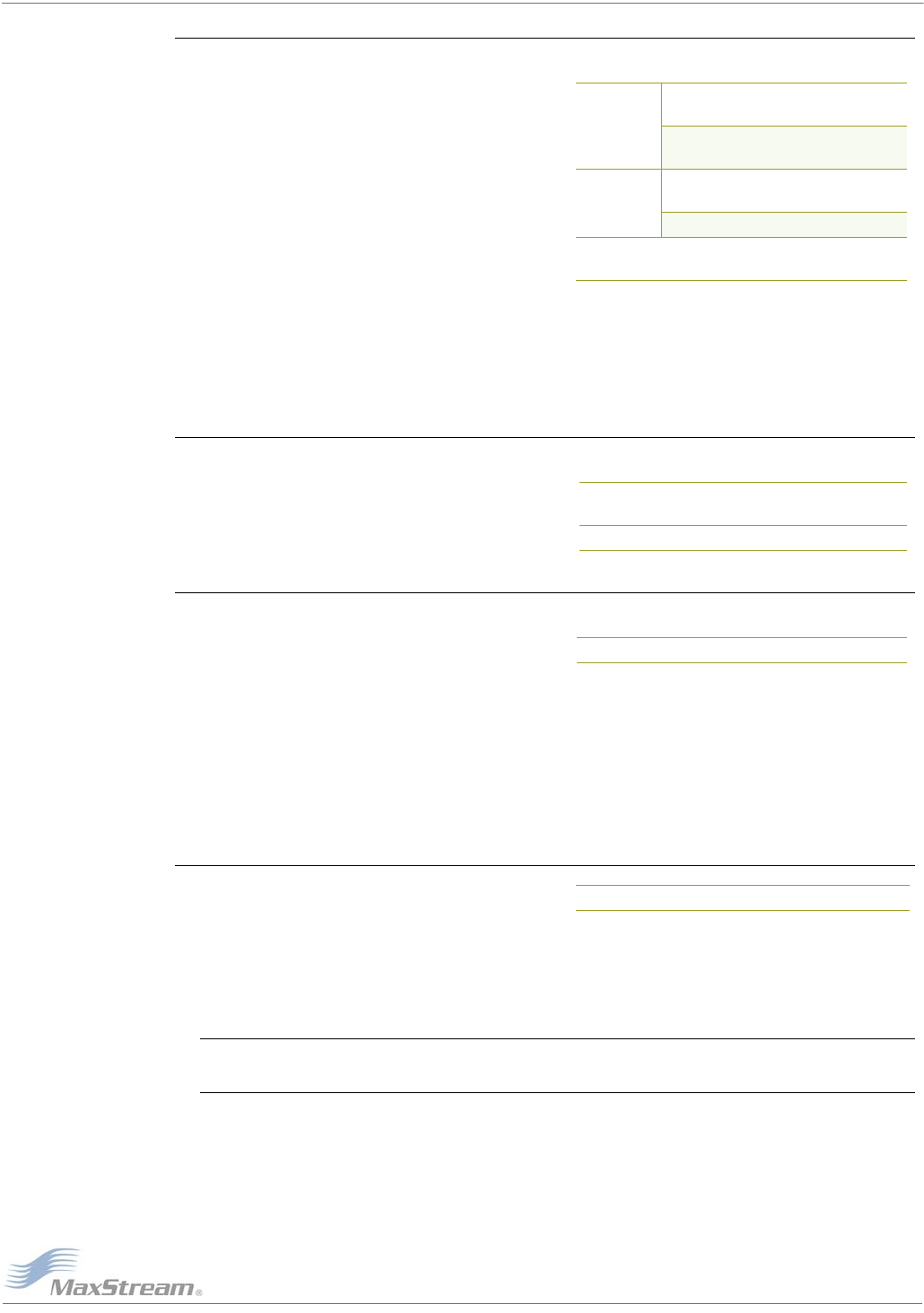
XBee™/XBee‐PROOEMRFModules–ProductManualv1.x7CBETA[2005.12.02]
©2005MaxStream,Inc.,Confidential&Proprietary‐AllRightsReserved 42
ST (Time before Sleep) Command
<Sleep Mode (Low Power)> The ST command is
used to set and read the period of inactivity (no
serial or RF data is sent or received) before acti-
vating Sleep Mode.
NonBeacon Firmware
Set/Read time period of inactivity (no serial or RF
data is sent or received) before activating Sleep
Mode. ST parameter is only valid with Cyclic
Sleep settings (SM = 4 - 5).
Coordinator and End Device ST values must be
equal.
Beacon-enabled Firmware
Set/Read the number of beacons received with no activity (no serial or RF data is sent or received)
before activating Sleep Mode. ST parameter is only valid with the Cyclic Sleep setting (SM = 4).
The ST parameter is not used by a Beacon-enabled Coordinator.
VL (Verbose Version)
<Diagnostics> The VL command is used to read
detailed version information about the module.
The information includes: application build date;
MAC, PHY and bootloader versions; and build
dates.
VR (Firmware Version) Command
<Diagnostics> The VR command is used to read
which firmware version is stored in the RF mod-
ule.
XBee version numbers will have four significant digits. The reported number will show three or
four numbers and is stated in hexadecimal notation. A version can be reported as "ABC" or
"ABCD". Digits ABC are the main release number and D is the revision number from the main
release. "D" is not required and if it is not present, a zero is assumed for D. "B" is a variant desig-
nator. The following variants exist:
• "0" - Non-Beacon Enabled 802.15.4 Code
• "1" - Beacon Enabled 802.15.4 Code
WR (Write) Command
<(Special)> The WR command is used to write
configurable parameters to the RF module's non-
volatile memory (Parameter values remain in RF
module's memory until overwritten by subsequent use of the WR Command).
If changes are made without writing them to non-volatile memory, the RF module reverts back to
previously saved parameters the next time the RF module is powered-on.
NOTE: Once the WR command is sent to the RF module, no additional characters should be sent until
after the “OK/r” response is received.
AT Command: ATST
Parameter
Range:
NonBeacon Firmware:
1 - 0xFFFF [x 1 millisecond]
Beacon-enabled Firmware:
1 - 0xFFFF [beacons]
Default
Parameter
Value:
NonBeacon Firmware: 0x1388
(5000 decimal)
Beacon-enabled Firmware: 0
Related Commands: SM (Sleep Mode), ST
(Time before Sleep)
AT Command: ATVL
Parameter Range: 0 - 0xFF
[x 100 milliseconds]
Default Parameter Value: 0x28 (40 decimal)
AT Command: ATVR
Parameter Range: 0 - 0xFFFF [read only]
AT Command: ATWR
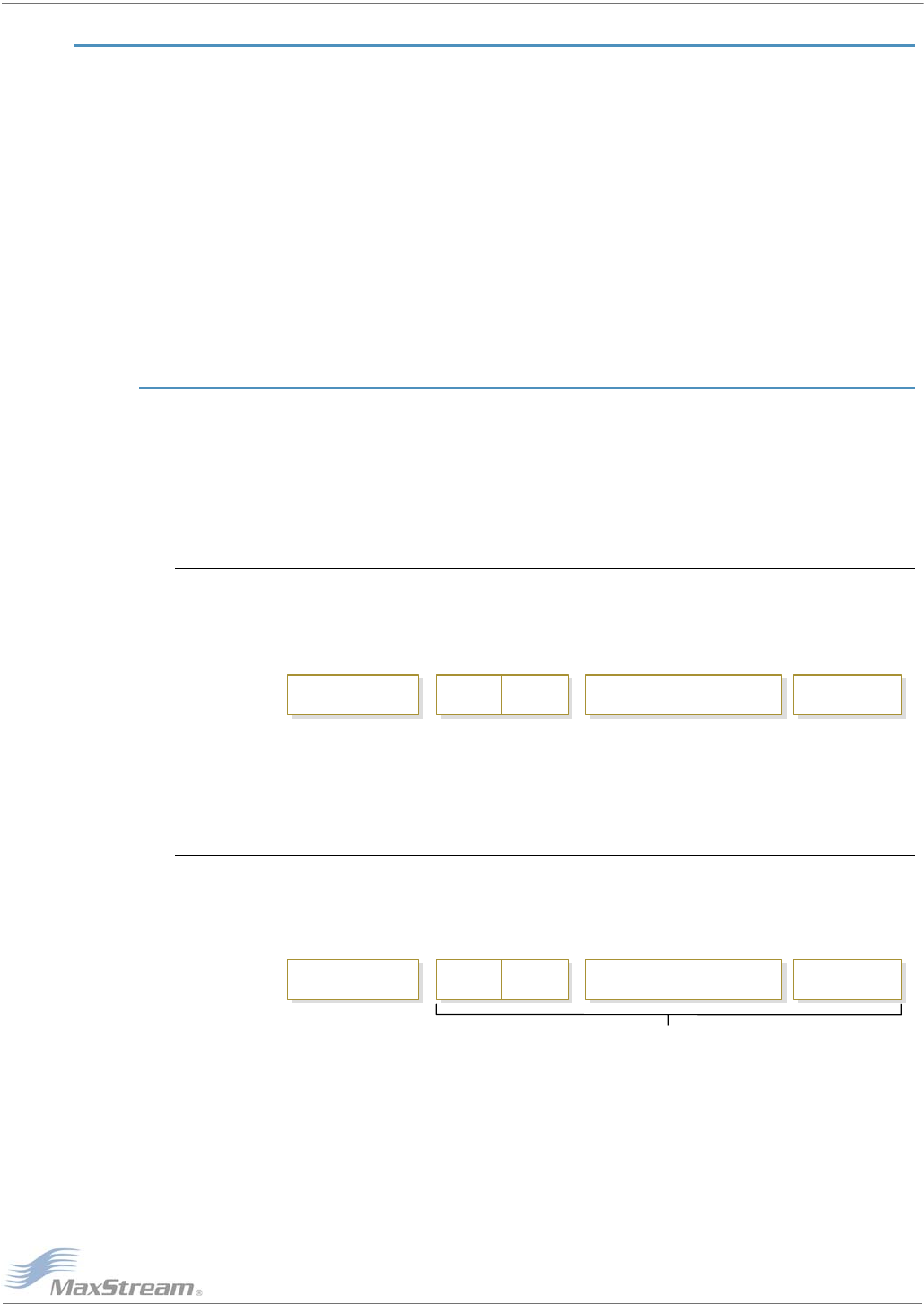
XBee™/XBee‐PROOEMRFModules–ProductManualv1.x7CBETA[2005.12.02]
©2005MaxStream,Inc.,Confidential&Proprietary‐AllRightsReserved 43
3.4. API Operation
By default, XBee/XBee-PRO RF Modules act as a serial line replacement (Transparent Operation) -
all UART data received through the DI pin is queued up for RF transmission. When the module
receives an RF packet, the data is sent out the DO pin with no additional information.
Inherent to Transparent Operation are the following behaviors:
• If module parameter registers are to be set or queried, a special operation is required for
transitioning the module into Command Mode [refer to p20].
• In point-to-multipoint systems, the application must send extra information so that the
receiving module(s) can distinguish between data coming from different remotes.
As an alternative to the default Transparent Operation, API (Application Programming Interface)
Operations are available. API operation requires that communication with the module be done
through a structured interface (data is communicated in frames in a defined order). The API spec-
ifies how commands, command responses and module status messages are sent and received
from the module using a UART Data Frame.
3.4.1. API Frame Specifications
Two API modes are supported and both can be enabled using the AP (API Enable) command. Use
the following AP parameter values to configure the module to operate in a particular mode:
• AP = 0 (default): Transparent Operation (UART Serial line replacement)
API modes are disabled.
•AP = 1: API Operation
•AP = 2: API Operation (with escaped characters)
API Operation (AP parameter = 1)
When this API mode is enabled (AP = 1), the UART data frame structure is defined as follows:
Figure3‐01. UARTDataFrameStructure:
MSB=MostSignificantByte,LSB=LeastSignificantByte
Any data received prior to the start delimiter is silently discarded. If the frame is not received cor-
rectly or if the checksum fails, the module will reply with a module status frame indicating the
nature of the failure.
API Operation - with Escape Characters (AP parameter = 2)
When this API mode is enabled (AP = 2), the UART data frame structure is defined as follows:
Figure3‐02. UARTDataFrameStructure‐withescapecontrolcharacters:
MSB=MostSignificantByte,LSB=LeastSignificantByte
Escape characters. When sending or receiving a UART data frame, specific data values must be
escaped (flagged) so they do not interfere with the UART or UART data frame operation. To escape
an interfering data byte, insert 0x7D and follow it with the byte to be escaped XOR’d with 0x20.
Start Delimiter
(Byte 1) Length
(Bytes 2-3) Frame Data
(Bytes 4-n) Checksum
(Byte n + 1)
0x7E MSB LSB API-specific Structure 1 Byte
Start Delimiter
(Byte 1) Length
(Bytes 2-3) Frame Data
(Bytes 4-n) Checksum
(Byte n + 1)
0x7E MSB LSB API-specific Structure 1 Byte
Characters Escaped If Needed
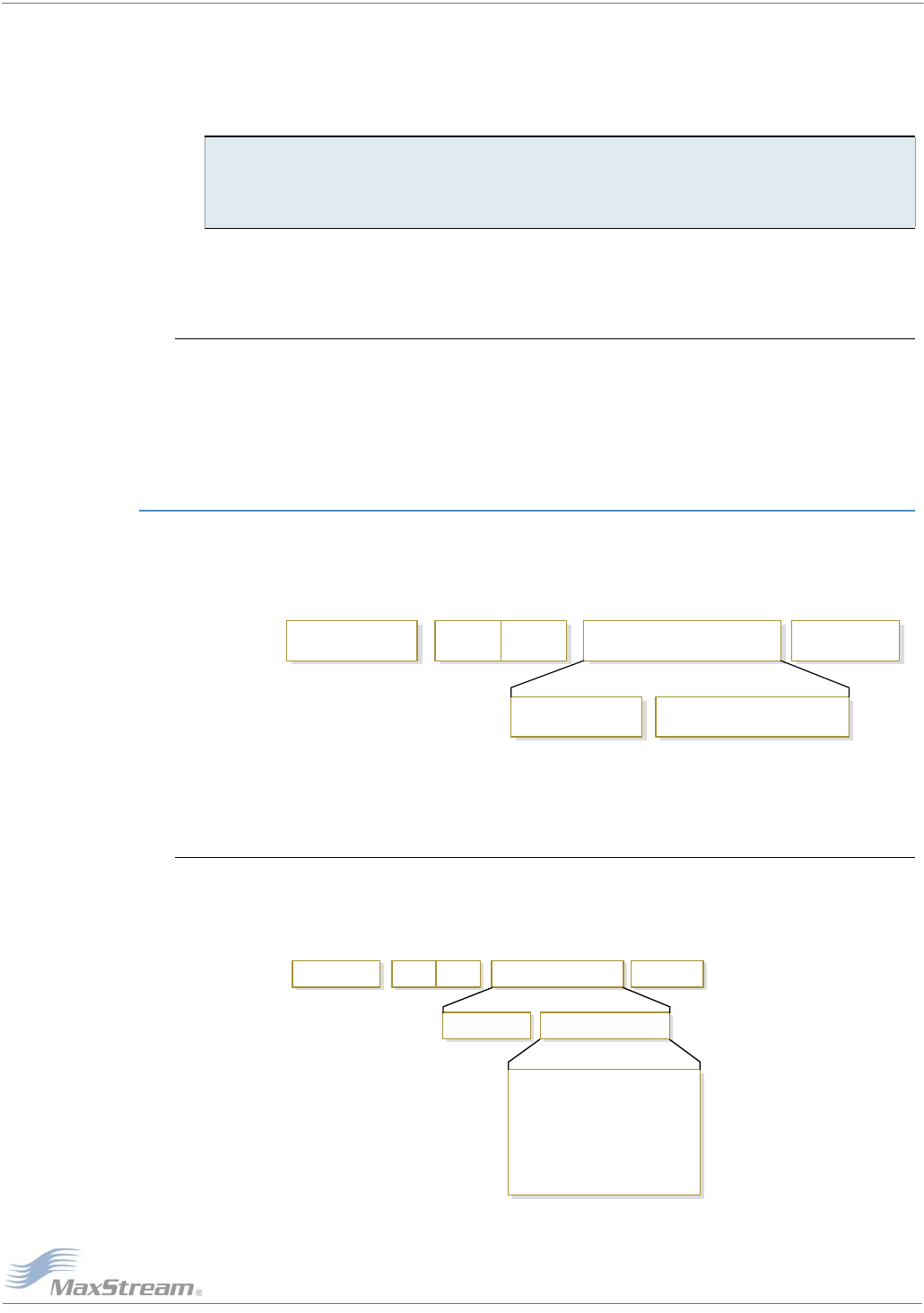
XBee™/XBee‐PROOEMRFModules–ProductManualv1.x7CBETA[2005.12.02]
©2005MaxStream,Inc.,Confidential&Proprietary‐AllRightsReserved 44
Data bytes that need to be escaped:
• 0x7E – Frame Delimiter
•0x7D – Escape
• 0x11 – XON
• 0x13 – XOFF
Note: In the above example, the length of the raw data (excluding the checksum) is 0x0002 and
the checksum of the non-escaped data (excluding frame delimiter and length) is calculated as:
0xFF - (0x23 + 0x11) = (0xFF - 0x34) = 0xCB.
Checksum
To test data integrity, a checksum is calculated and verified on non-escaped data.
To calculate: Not including frame delimiters and length, add all bytes keeping only the lowest 8
bits of the result and subtract from 0xFF.
To verify: Add all bytes (include checksum, but not the delimiter and length). If the checksum is
correct, the sum will equal 0xFF.
3.4.2. API Types
Frame data of the UART data frame forms an API-specific structure as follows:
Figure3‐03. UARTDataFrame&API‐specificStructure:
The cmdID frame (API-identifier) indicates which API messages will be contained in the cmdData
frame (Identifier-specific data). Refer to the sections that follow for more information regarding
the supported API types. Note that multi-byte values are sent big endian.
Modem Status
API Identifier: 0x8A
RF Module status messages are sent from the module in response to specific conditions.
Figure3‐04. ModemStatusFrames
Example - Raw UART Data Frame (before escaping interfering bytes):
0x7E 0x00 0x02 0x23 0x11 0xCB
0x11 needs to be escaped which results in the following frame:
0x7E 0x00 0x02 0x23 0x7D 0x31 0xCB
Length
(Bytes 2-3) Checksum
(Byte n + 1)
MSB LSB 1 Byte
Start Delimiter
(Byte 1)
0x7E
Frame Data
(Bytes 4-n)
API-specific Structure
Identifier-specific Data
cmdData
API Identifier
cmdID
cmdData0x8A
Length ChecksumStart Delimiter Frame Data
Identifier-specific DataAPI Identifier
MSB LSB0x7E 1 ByteAPI-specific Structure
Status (Byte 5)
0 = Hardware reset
1 = Watchdog timer reset
2 = Associated
3 = Disassociated
4 = Synchronization Lost
(Beacon-enabled only)
5 = Coordinator realignment
6 = Coordinator reset
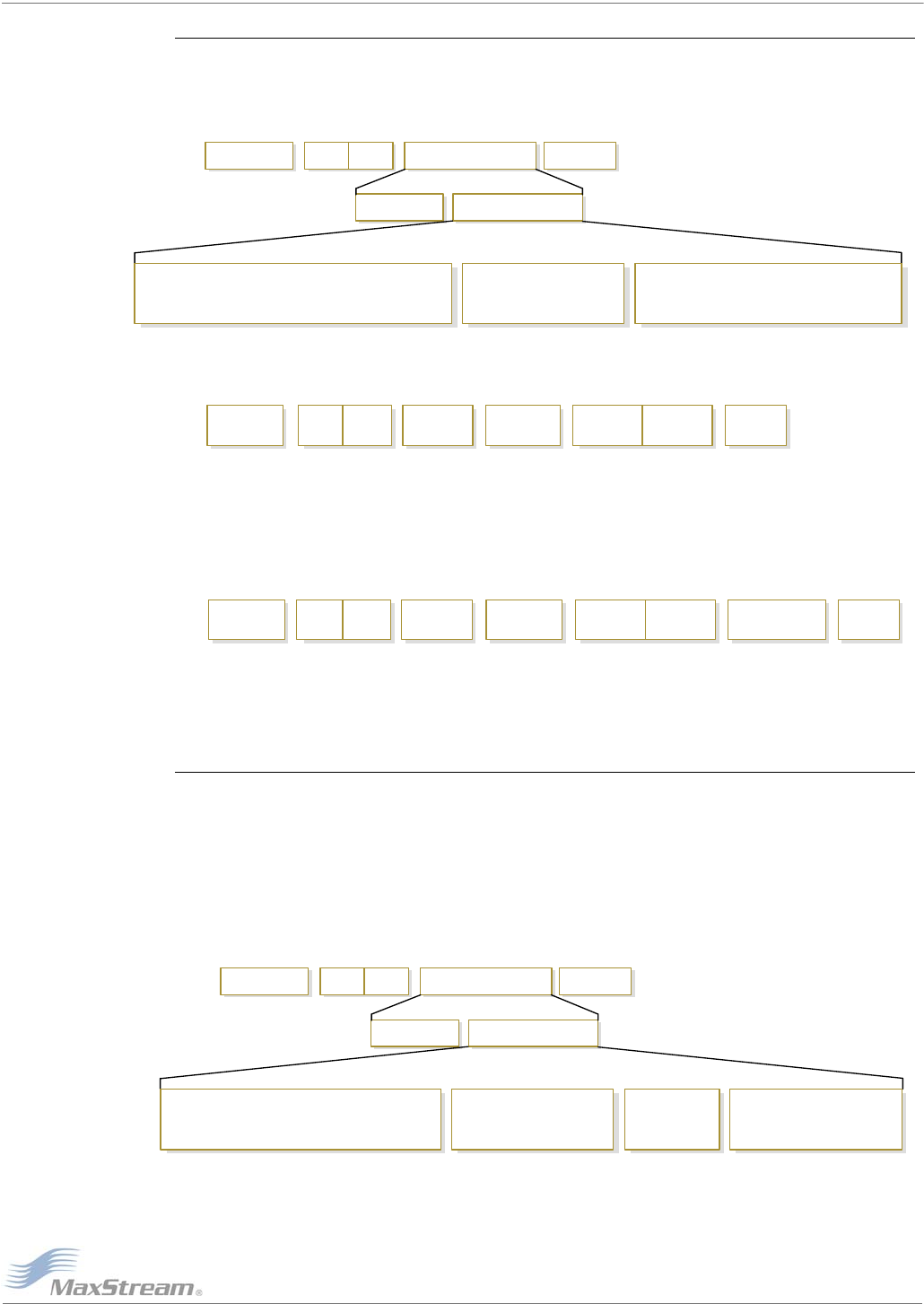
XBee™/XBee‐PROOEMRFModules–ProductManualv1.x7CBETA[2005.12.02]
©2005MaxStream,Inc.,Confidential&Proprietary‐AllRightsReserved 45
AT Command
API Identifier Value: 0x08
Allows for module parameter registers to be queried or set.
Figure3‐05. ATCommandFrames
Figure3‐06. Example:APIframeswhenreadingtheDLparametervalueofthemodule.
Figure3‐07. Example:APIframeswhenmodifyingtheDLparametervalueofthemodule.
AT Command Response
API Identifier Value: 0x88
Response to previous command.
In response to an AT Command message, the module will send an AT Command Response mes-
sage. Some commands will send back multiple frames (for example, the MD (Modem Discover)
and AS (Active Scan) commands). These commands will end by sending a frame with a status of
ATCMD_OK and no cmdData.
Figure3‐08. ATCommandResponseFrames.
cmdData0x08
Length ChecksumStart Delimiter Frame Data
Identifier-specific DataAPI Identifier
MSB LSB0x7E 1 ByteAPI-specific Structure
Frame ID (Byte 5)
Identifies the UART data frame for the host to
correlate with a subsequent ACK (acknowledgement).
If set to ‘0’, no response is requested.
AT Command (Bytes 6-7)
Command Name - Two
ASCII characters that
identify the AT Command.
Parameter Value (Byte(s) 8-n)
If present, indicates the requested parameter
value to set the given register.
If no characters present, register is queried.
*Length[Bytes]=APIIdentifier+FrameID+ATCommand
**“R”valuewasarbitrarilyselected.
Checksum
0x15
Byte 8
AT Command
Bytes 6-7
Frame ID**
R (0x52)
Byte 5
D (0x44) L (0x4C)
API Identifier
0x08
Byte 4
Start Delimiter
Byte 1
0x7E
Length*
Bytes 2-3
0x00 0x04
*Length[Bytes]=APIIdentifier+FrameID+ATCommand+ParameterValue
**“M”valuewasarbitrarilyselected.
Checksum
0x0C
Byte 12
AT Command
Bytes 6-7
D (0x44) L (0x4C)
Parameter Value
0x00000FFF
Bytes 8-11
Frame ID**
M (0x4D)
Byte 5
Length*
Bytes 2-3
0x00 0x08
API Identifier
0x08
Byte 4
Start Delimiter
Byte 1
0x7E
cmdData0x88
Length ChecksumStart Delimiter Frame Data
Identifier-specific DataAPI Identifier
MSB LSB0x7E 1 ByteAPI-specific Structure
Frame ID (Byte 5 )
Identifies the UART data frame being reported.
Note: If Frame ID = 0 in AT Command Mode,
no AT Command Response will be given.
AT Command (Bytes 6-7)
Command Name - Two
ASCII characters that
identify the AT Command.
Status (Byte 8)
0 = OK
1 = ERROR
Value (Byte(s) 9-n)
The HEX (non-ASCII) value
of the requested register
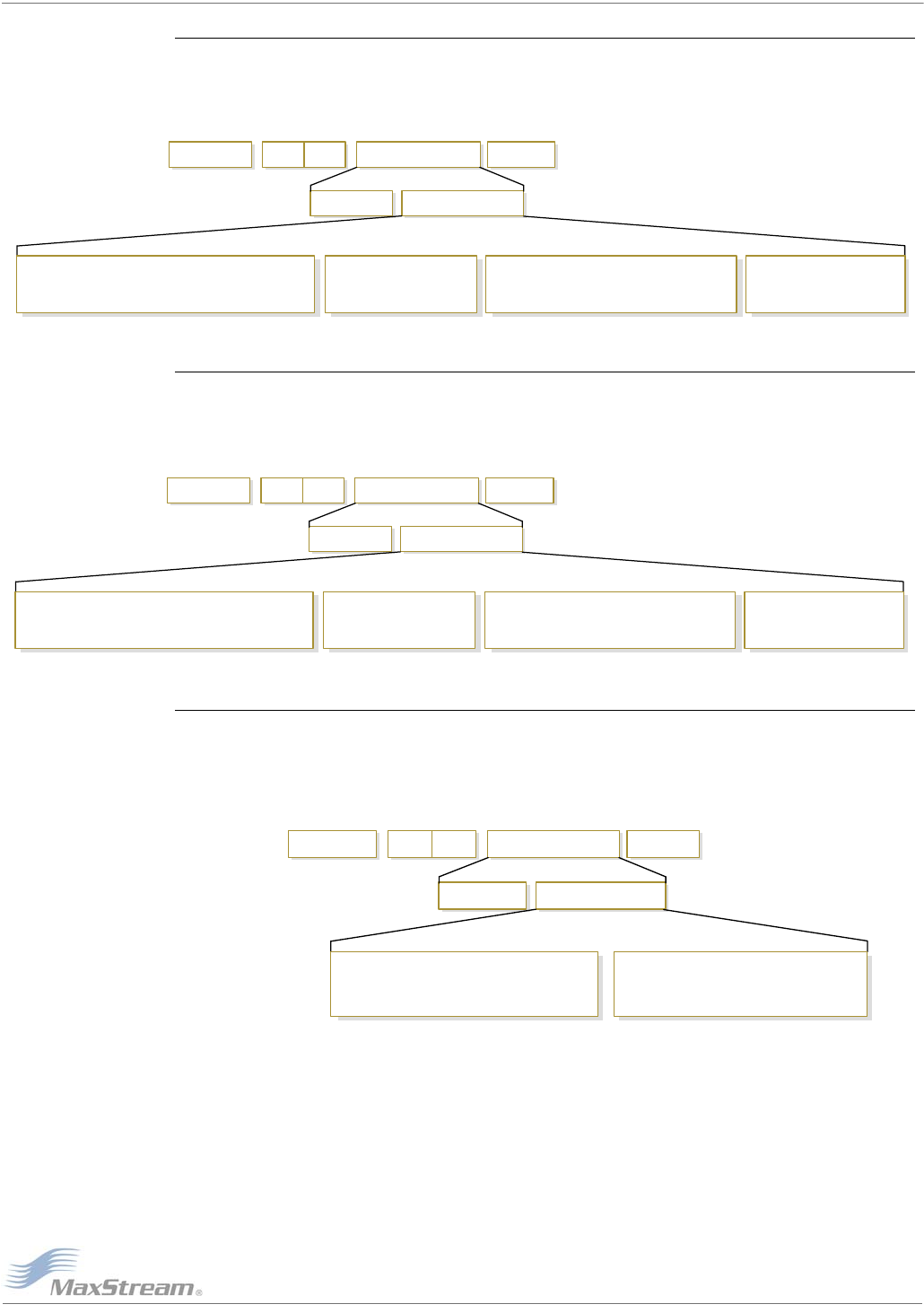
XBee™/XBee‐PROOEMRFModules–ProductManualv1.x7CBETA[2005.12.02]
©2005MaxStream,Inc.,Confidential&Proprietary‐AllRightsReserved 46
TX (Transmit) Request: 64-bit address
API Identifier Value: 0x00
A TX Request message will cause the module to send RF Data as an RF Packet.
Figure3‐09. TXPacket(64‐bitaddress)Frames
TX (Transmit) Request: 16-bit address
API Identifier Value: 0x01
A TX Request message will cause the module to send RF Data as an RF Packet.
Figure3‐10. TXPacket(16‐bitaddress)Frames
TX (Transmit) Status
API Identifier Value: 0x89
When a TX Request is completed, the module sends a TX Status message. This message will indi-
cate if the packet was transmitted successfully or if there was a failure.
Figure3‐11. TXStatusFrames
NOTES:
• “STATUS = 1” occurs when all retries are expired and no ACK is received.
• If transmitter broadcasts (destination address = 0x000000000000FFFF), only
“STATUS = 0 or 2” will be returned.
• “STATUS = 3” occurs when Coordinator times out of an indirect transmission.
Timeout is defined as (2.5 x SP (Cyclic Sleep Period) parameter value).
cmdData0x00
Length ChecksumStart Delimiter Frame Data
Identifier-specific DataAPI Identifier
MSB LSB0x7E 1 ByteAPI-specific Structure
Frame ID (Byte 5)
Identifies the UART data frame for the host to
correlate with a subsequent ACK (acknowledgement).
Setting Frame ID to ‘0' will disable response frame.
Destination Address (Bytes 6-13)
MSB first, LSB last.
Broadcast =
0x000000000000FFFF
Options (Byte 14)
bits 0-7 [reserved at this time] - Set to 0x00
RF Data (Byte(s) 15-n)
Up to 100 Bytes per packet
cmdData0x01
Length ChecksumStart Delimiter Frame Data
Identifier-specific DataAPI Identifier
MSB LSB0x7E 1 ByteAPI-specific Structure
Frame ID (Byte 5)
Identifies the UART data frame for the host to
correlate with a subsequent ACK (acknowledgement).
Setting Frame ID to ‘0' will disable response frame.
Destination Address (Bytes 6-7)
MSB first, LSB last.
Broadcast = 0xFFFF
Options (Byte 8)
bits 0-7 [reserved at this time] - Set to 0x00
RF Data (Byte(s) 9-n)
Up to 100 Bytes per packet
cmdData0x89
Length ChecksumStart Delimiter Frame Data
Identifier-specific DataAPI Identifier
MSB LSB0x7E 1 ByteAPI-specific Structure
Frame ID (Byte 5) Status (Byte 6)
0 = Success
1 = No ACK (Acknowledgement) received
2 = CCA failure
3 = Purged
Identifies UART data frame being reported.
Note: If Frame ID = 0 in the TX Request, no
AT Command Response will be given.
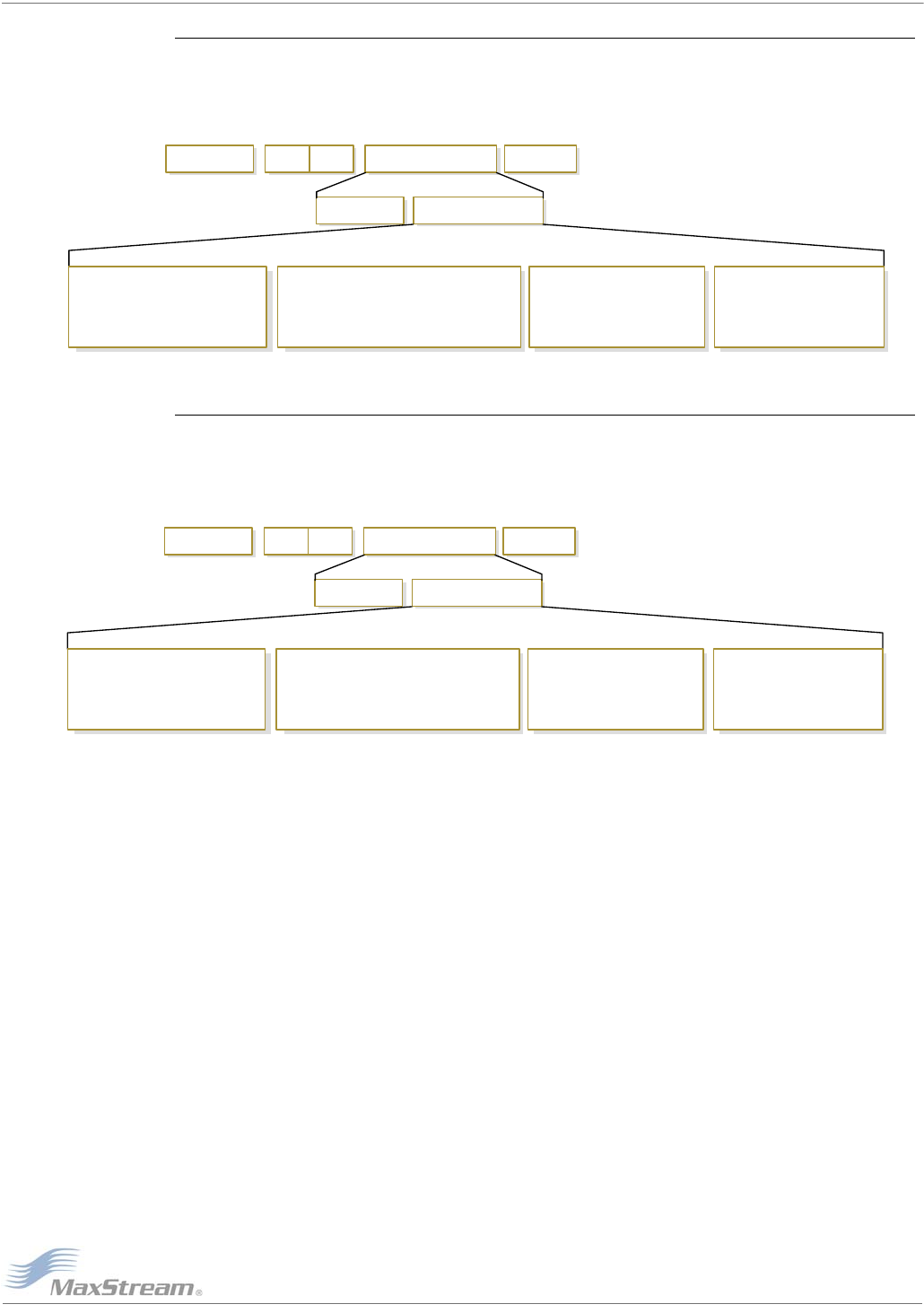
XBee™/XBee‐PROOEMRFModules–ProductManualv1.x7CBETA[2005.12.02]
©2005MaxStream,Inc.,Confidential&Proprietary‐AllRightsReserved 47
RX (Receive) Packet: 64-bit address
API Identifier Value: 0x80
When the module receives an RF packet, it is sent out the UART using this message type.
Figure3‐12. RXPacket(64‐bitaddress)Frames
RX (Receive) Packet: 16-bit address
API Identifier Value: 0x81
When the module receives an RF packet, it is sent out the UART using this message type.
Figure3‐13. RXPacket(16‐bitaddress)Frames
cmdData0x80
Length ChecksumStart Delimiter Frame Data
Identifier-specific DataAPI Identifier
MSB LSB0x7E 1 ByteAPI-specific Structure
bit 0 [reserved]
bit 1 = Address broadcast
bit 2 = PAN broadcast
bits 3-7 [reserved]
Up to 100 Bytes per packet
Received Signal Strength Indicator -
Hexadecimal equivalent of (-dBm) value.
(For example: If RX signal strength = -40
dBm, “0x28” (40 decimal) is returned)
Source Address (Bytes 5-12) Options (Byte 14) RF Data (Byte(s) 15-n)RSSI (Byte 13)
MSB (most significant byte) first,
LSB (least significant) last
cmdData0x81
Length ChecksumStart Delimiter Frame Data
Identifier-specific DataAPI Identifier
MSB LSB0x7E 1 ByteAPI-specific Structure
bit 0 [reserved]
bit 1 = Address broadcast
bit 2 = PAN broadcast
bits 3-7 [reserved]
Up to 100 Bytes per packet
Received Signal Strength Indicator -
Hexadecimal equivalent of (-dBm) value.
(For example: If RX signal strength = -40
dBm, “0x28” (40 decimal) is returned)
Source Address (Bytes 5-6) RSSI (Byte 7)
MSB (most significant byte) first,
LSB (least significant) last
Options (Byte 8) RF Data (Byte(s) 9-n)
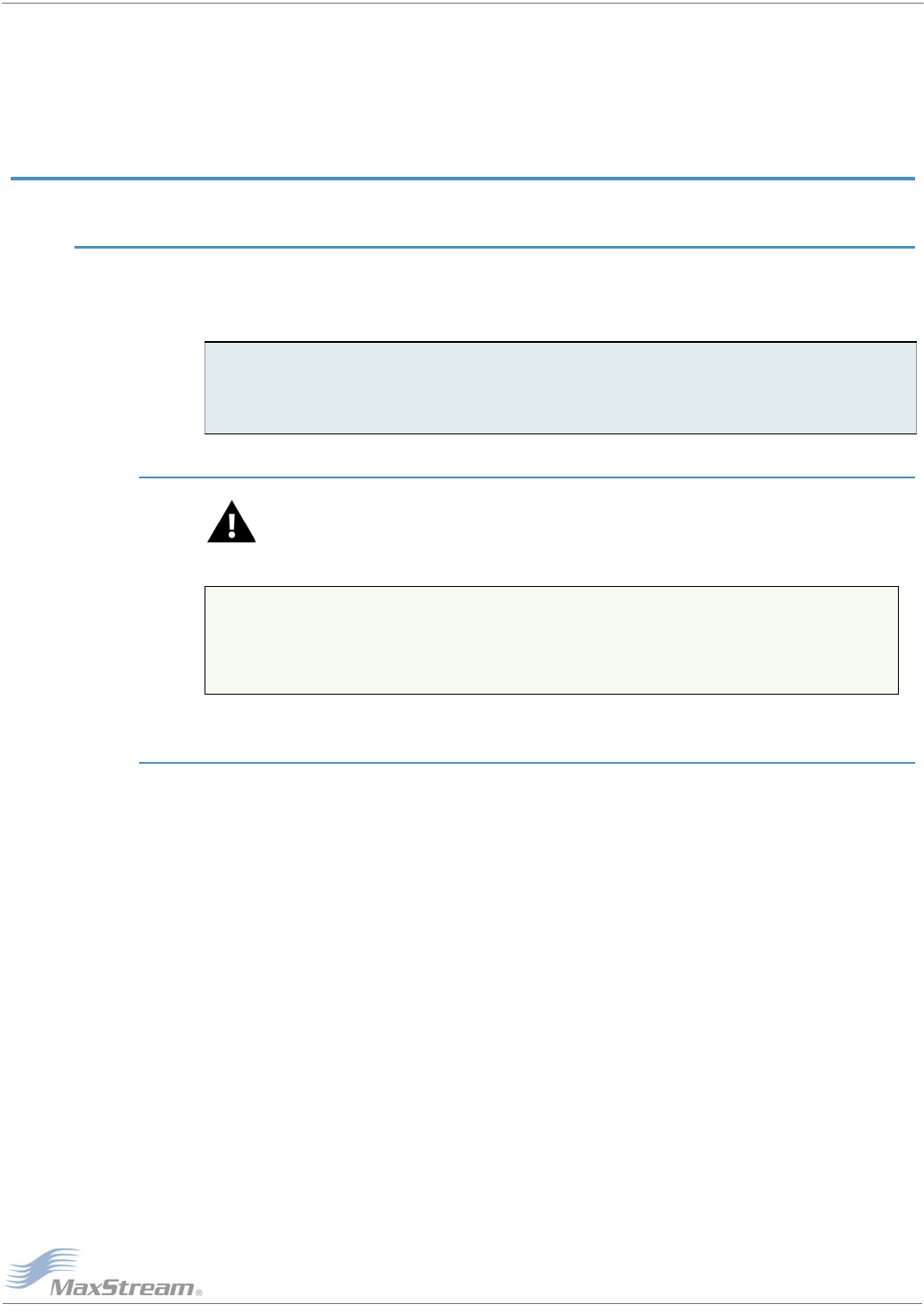
XBee™/XBee‐PROOEMRFModules–ProductManualv1.x7CBETA[2005.12.02]
©2005MaxStream,Inc.,Confidential&Proprietary‐AllRightsReserved 48
AppendixA:AgencyCertifications
FCC Certification
The XBee/XBee-PRO RF Module complies with Part 15 of the FCC rules and regulations. Compli-
ance with the labeling requirements, FCC notices and antenna usage guidelines is required.
To fulfill FCC Certification requirements, the OEM must comply with the following regulations:
OEM Labeling Requirements
WARNING: The Original Equipment Manufacturer (OEM) must ensure that FCC labeling
requirements are met. This includes a clearly visible label on the outside of the final
product enclosure that displays the contents shown in the figure below.
FigureA‐01. RequiredFCCLabelforOEMproductscontainingtheXBee/XBee‐PRORFModule
*TheFCCIDfortheXBeeis“OUR‐XBEE”.TheFCCIDfortheXBee‐PROis“OUR‐XBEEPRO”.
FCC Notices
IMPORTANT: The XBee/XBee-PRO OEM RF Module has been certified by the FCC for use with
other products without any further certification (as per FCC section 2.1091). Modifications not
expressly approved by MaxStream could void the user's authority to operate the equipment.
IMPORTANT: OEMs must test final product to comply with unintentional radiators (FCC section
15.107 & 15.109) before declaring compliance of their final product to Part 15 of the FCC Rules.
IMPORTANT: The RF module has been certified for remote and base radio applications. If the
module will be used for portable applications, the device must undergo SAR testing.
This equipment has been tested and found to comply with the limits for a Class B digital device,
pursuant to Part 15 of the FCC Rules. These limits are designed to provide reasonable protection
against harmful interference in a residential installation. This equipment generates, uses and can
radiate radio frequency energy and, if not installed and used in accordance with the instructions,
may cause harmful interference to radio communications. However, there is no guarantee that
interference will not occur in a particular installation.
If this equipment does cause harmful interference to radio or television reception, which can be
determined by turning the equipment off and on, the user is encouraged to try to correct the inter-
ference by one or more of the following measures: Re-orient or relocate the receiving antenna,
Increase the separation between the equipment and receiver, Connect equipment and receiver to
outlets on different circuits, or Consult the dealer or an experienced radio/TV technician for help.
1. The system integrator must ensure that the text on the external label provided with this
device is placed on the outside of the final product [Figure A-01].
2. The XBee/XBee-PRO RF Module may be used only with approved antennas that have been
tested with this modem.
Contains FCC ID: OUR-XBEE / OUR-XBEEPRO*
The enclosed device complies with Part 15 of the FCC Rules. Operation is subject to the following two
conditions: (1) this device may not cause harmful interference and (2) this device must accept any inter-
ference received, including interference that may cause undesired operation.
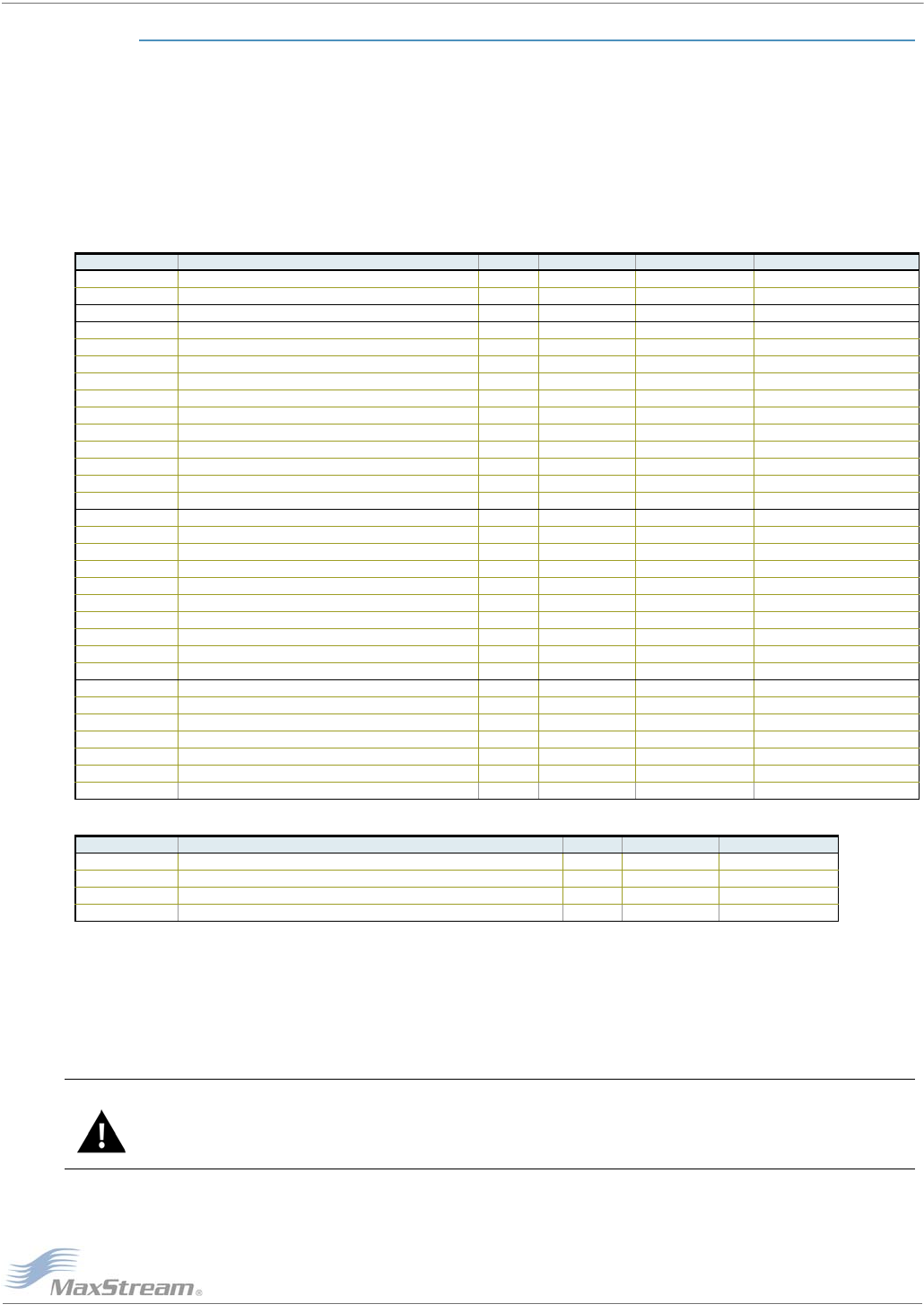
XBee™/XBee‐PROOEMRFModules–ProductManualv1.x7CBETA[2005.12.02]
©2005MaxStream,Inc.,Confidential&Proprietary‐AllRightsReserved 49
FCC-Approved Antennas (2.4 GHz)
The XBee/XBee-Pro OEM RF Module can be installed utilizing antennas and cables constructed with
standard connectors (Type-N, SMA, TNC, etc.) if the installation is performed professionally and
according to FCC guidelines. For installations not performed by a professional, non-standard con-
nectors (RPSMA, RPTNC, etc.) must be used.
The modules are pre-FCC approved for fixed base station and mobile applications on channels
0x0B - 0x18. As long as the antenna is mounted at least 20cm (8 in.) from nearby persons, the
application is considered a mobile application. Antennas not listed in the table must be tested to
comply with FCC Section 15.203 (unique antenna connectors) and Section 15.247 (emissions).
TableA‐02. AntennasapprovedforusewiththeXBee/XBee‐PROOEMRFModules(Channels0x0B‐0x17)
*Ifusingthemoduleinaportableapplication(Forexample‐Ifthemoduleisusedinahandhelddeviceandtheantennaisless
than20cmfromthehumanbodywhenthedeviceisoperation):TheintegratorisresponsibleforpassingadditionalSAR(Specific
AbsorptionRate)testingbasedonFCCrules2.1091andFCCGuidelinesforHumanExposuretoRadioFrequencyElectromagnetic
Fields,OETBulletinandSupplementC.ThetestingresultswillbesubmittedtotheFCCforapprovalpriortosellingtheintegrated
unit.TherequiredSARtestingmeasuresemissionsfromthemoduleandhowtheyaffecttheperson.
**Requiredcablelossonlyappliestothehigherpoweroutput“XBee‐PRO”modulesandnottothe“XBee”modules.
RF Exposure
WARNING: To satisfy FCC RF exposure requirements for mobile transmitting devices, a separation distance of
20 cm or more should be maintained between the antenna of this device and persons during device operation.
To ensure compliance, operations at closer than this distance is not recommended. The antenna used for this
transmitter must not be co-located in conjunction with any other antenna or transmitter.
The preceding statement must be included as a CAUTION statement in manuals for OEM products to alert users on
FCC RF Exposure compliance.
TableA‐01. AntennasapprovedforusewiththeXBee/XBee‐PROOEMRFModules(Channels0x0B‐0x18)
Part Number Type (Description) Gain Application* Min. Separation Required Cable Loss**
A24-HSM-450 Dipole (Half-wave articulated RPSMA - 4.5”) 2.1 dBi Fixed/Mobile 20 cm 4.2 dB
A24-HABSM Dipole (Articulated RPSMA) 2.1 dBi Fixed/Mobile 20 cm 4.2 dB
A24-C1 Surface Mount -1.5 dBi Fixed/Mobile 20 cm -
A24-Y4NF Yagi (4-element) 6.0 dBi Fixed 2 m 8.1 dB
A24-Y6NF Yagi (6-element) 8.8 dBi Fixed 2 m 10.9 dB
A24-Y7NF Yagi (7-element) 9.0 dBi Fixed 2 m 11.1 dB
A24-Y9NF Yagi (9-element) 10.0 dBi Fixed 2 m 12.1 dB
A24-Y10NF Yagi (10-element) 11.0 dBi Fixed 2 m 13.1 dB
A24-Y12NF Yagi (12-element) 12.0 dBi Fixed 2 m 14.1 dB
A24-Y13NF Yagi (13-element) 12.0 dBi Fixed 2 m 14.1 dB
A24-Y15NF Yagi (15-element) 12.5 dBi Fixed 2 m 14.6 dB
A24-Y16NF Yagi (16-element) 13.5 dBi Fixed 2 m 15.6 dB
A24-Y16RM Yagi (16-element, RPSMA connector) 13.5 dBi Fixed 2 m 15.6 dB
A24-Y18NF Yagi (18-element) 15.0 dBi Fixed 2 m 17.1 dB
A24-F2NF Omni-directional (Fiberglass base station) 2.1 dBi Fixed/Mobile 20 cm 4.2 dB
A24-F3NF Omni-directional (Fiberglass base station) 3.0 dBi Fixed/Mobile 20 cm 5.1 dB
A24-F5NF Omni-directional (Fiberglass base station) 5.0 dBi Fixed/Mobile 20 cm 7.1 dB
A24-F8NF Omni-directional (Fiberglass base station) 8.0 dBi Fixed 2 m 10.1 dB
A24-F9NF Omni-directional (Fiberglass base station) 9.5 dBi Fixed 2 m 11.6 dB
A24-F10NF Omni-directional (Fiberglass base station) 10.0 dBi Fixed 2 m 12.1 dB
A24-F12NF Omni-directional (Fiberglass base station) 12.0 dBi Fixed 2 m 14.1 dB
A24-F15NF Omni-directional (Fiberglass base station) 15.0 dBi Fixed 2 m 17.1 dB
A24-W7NF Omni-directional (Base station) 7.2 dBi Fixed 2 m 9.3 dB
A24-M7NF Omni-directional (Mag-mount base station) 7.2 dBi Fixed 2 m 9.3 dB
A24-P8SF Flat Panel 8.5 dBi Fixed 2 m 8.6 dB
A24-P8NF Flat Panel 8.5 dBi Fixed 2 m 8.6 dB
A24-P13NF Flat Panel 13.0 dBi Fixed 2 m 13.1 dB
A24-P14NF Flat Panel 14.0 dBi Fixed 2 m 14.1 dB
A24-P15NF Flat Panel 15.0 dBi Fixed 2 m 15.1 dB
A24-P16NF Flat Panel 16.0 dBi Fixed 2 m 16.1 dB
A24-P19NF Flat Panel 19.0 dBi Fixed 2 m 19.1 dB
Part Number Type (Description) Gain Application* Min. Separation
A24-HSM-450 Dipole (Half-wave articulated RPSMA - 4.5”) 2.1 dBi Fixed/Mobile 20 cm
A24-HABSM Dipole (Articulated RPSMA) 2.1 dBi Fixed 20 cm
A24-HABUF-P5I Dipole (Half-wave articulated bulkhead mount U.FL. w/ 5” pigtail) 2.1 dBi Fixed 20 cm
A24-QI Monopole (Integrated whip - XBee 0x0B-0x18, XBee-PRO 0x0B-0x17) 1.5 dBi Fixed 20 cm

XBee™/XBee‐PROOEMRFModules–ProductManualv1.x7CBETA[2005.12.02]
©2005MaxStream,Inc.,Confidential&Proprietary‐AllRightsReserved 50
European Certification
The XBee/XBee-PRO RF Module has been certified for use in several European countries. For a
complete list, refer to www.maxstream.net.
If the XBee/XBee-PRO RF Modules are incorporated into a product, the manufacturer must ensure
compliance of the final product to the European harmonized EMC and low-voltage/safety stan-
dards. A Declaration of Conformity must be issued for each of these standards and kept on file as
described in Annex II of the R&TTE Directive. Furthermore, the manufacturer must maintain a
copy of the XBee/XBee-PRO user manual documentation and ensure the final product does not
exceed the specified power ratings, antenna specifications, and/or installation requirements as
specified in the user manual. If any of these specifications are exceeded in the final product, a
submission must be made to a notified body for compliance testing to all required standards.
OEM Labeling Requirements
The 'CE' marking must be affixed to a visible location on the OEM product.
FigureA‐02. CELabelingRequirements
The CE mark shall consist of the initials "CE" taking the following form:
• If the CE marking is reduced or enlarged, the proportions given in the above graduated draw-
ing must be respected.
• The CE marking must have a height of at least 5mm except where this is not possible on
account of the nature of the apparatus.
• The CE marking must be affixed visibly, legibly, and indelibly.
Restrictions
France - France imposes restrictions on the 2.4 GHz band. Go to www.art-telecom.Fr or contact
MaxStream for more information.
Norway - Norway prohibits operation near Ny-Alesund in Svalbard. More information can be found
at the Norway Posts and Telecommunications site (www.npt.no).
Declarations of Conformity
MaxStream has issued Declarations of Conformity for the XBee/XBee-PRO RF Modules concerning
emissions, EMC and safety. Files are located in the 'documentation' folder of the MaxStream CD.
Important Note
MaxStream does not list the entire set of standards that must be met for each country. MaxStream
customers assume full responsibility for learning and meeting the required guidelines for each
country in their distribution market. For more information relating to European compliance of an
OEM product incorporating the XBee/XBee-PRO RF Module, contact MaxStream, or refer to the fol-
lowing web sites:
CEPT ERC 70-03E - Technical Requirements, European restrictions and general requirements:
Available at www.ero.dk/.
R&TTE Directive - Equipment requirements, placement on market: Available at www.ero.dk/.
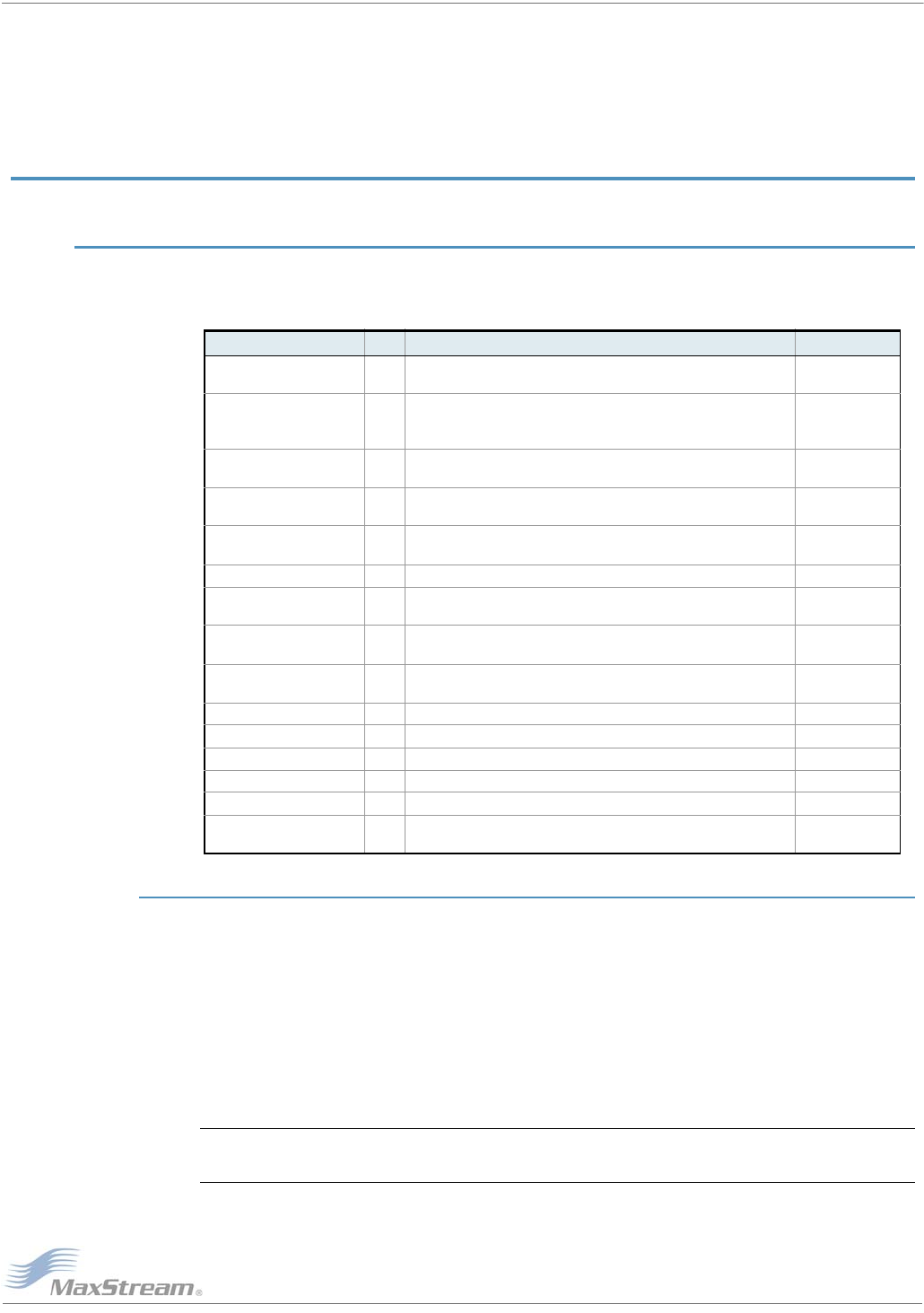
XBee™/XBee‐PROOEMRFModules–ProductManualv1.x7CBETA[2005.12.02]
©2005MaxStream,Inc.,Confidential&Proprietary‐AllRightsReserved 51
AppendixB:DevelopmentGuide
Development Kit Contents
The XBee Development Kit includes the hardware and software needed to rapidly create long
range wireless links between devices.
Interfacing Options
The development kit includes an RS-232 and a USB interface board. Both boards provide a direct
connection to many serial devices and therefore provide access to the RF module registries.
Parameters stored in the registry allow OEMs and integrators to customize the modules to suite
the needs of their data radio systems.
The following sections illustrate how to use the interface boards for development purposes. The
MaxStream Interface board provides means for connecting the module to any node that has an
available RS-232 or USB connector. Since the module requires signals to enter at TTL voltages,
one of the main functions of the interface board is to convert signals between TTL levels and RS-
232 and USB levels.
Note: In the following sections, an OEM RF Module mounted to an interface board will be referred to as
a "Module Assembly".
TableB‐01. ItemsIncludedintheDevelopmentKit
Item Qty. Description Part #
XBee-PRO Module 2 (1) OEM RF Module w/ U.FL antenna connector
(1) OEM RF Module w/ attached wire antenna XBP24-...UI-...
XBP24-...WI-...
XBee Module 3 (1) OEM RF Module w/ U.FL antenna connector
(1) OEM RF Module w/ attached wire antenna
(1) OEM RF Module w/ chip antenna
XB24-...UI-...
XB24-...WI-...
XB24-...CI-...
RS-232 Interface Board 1 Board for interfacing between modules and RS-232 devices
(Converts signal levels, displays diagnostic info, & more) XBIB-R
USB Interface Board 1 Board for interfacing between modules & USB devices
(Converts signal levels, displays diagnostic info, & more) XBIB-U
RS-232 Cable
(6’, straight-through) 1Cable for connecting RS-232 interface board with DTE devices
(devices that have a male serial DB-9 port - such as most PCs) JD2D3-CDS-6F
USB Cable (6’) 1 Cable for connecting USB interface board to USB devices JU1U2-CSB-6F
Serial Loopback
Adapter 1[Red] Adapter for configuring the module assembly (module + RS-232
interface board) to function as a repeater for range testing JD2D3-CDL-A
NULL Modem Adapter
(male-to-male) 1[Black] Adapter for connecting the module assembly (module + RS-232
interface board) to other DCE (female DB-9) devices JD2D2-CDN-A
NULL Modem Adapter
(female-to-female) 1[Gray] Adapter for connecting serial devices. It allows users to bypass
the radios to verify serial cabling is functioning properly. JD3D3-CDN-A
9VDC Power Adapter 1 Adapter for powering the RS-232 interface board JP5P2-9V11-6F
9V Battery Clip 1 Clip for remotely powering the RS-232 board w/ a 9V battery JP2P3-C2C-4I
RPSMA Antenna 1 RPSMA half-wave dipole antenna (2.4 GHz, 2.1 dB) A24-HASM-525
RF Cable Assembly 1 Adapter for connecting RPSMA antenna to U.FL connector JF1R6-CR3-4I
CD 1 Documentation and Software MD0010
Quick Start Guide 1 Step-by-step instruction on how to create wireless links
& test range capabilities of the modules MD0026
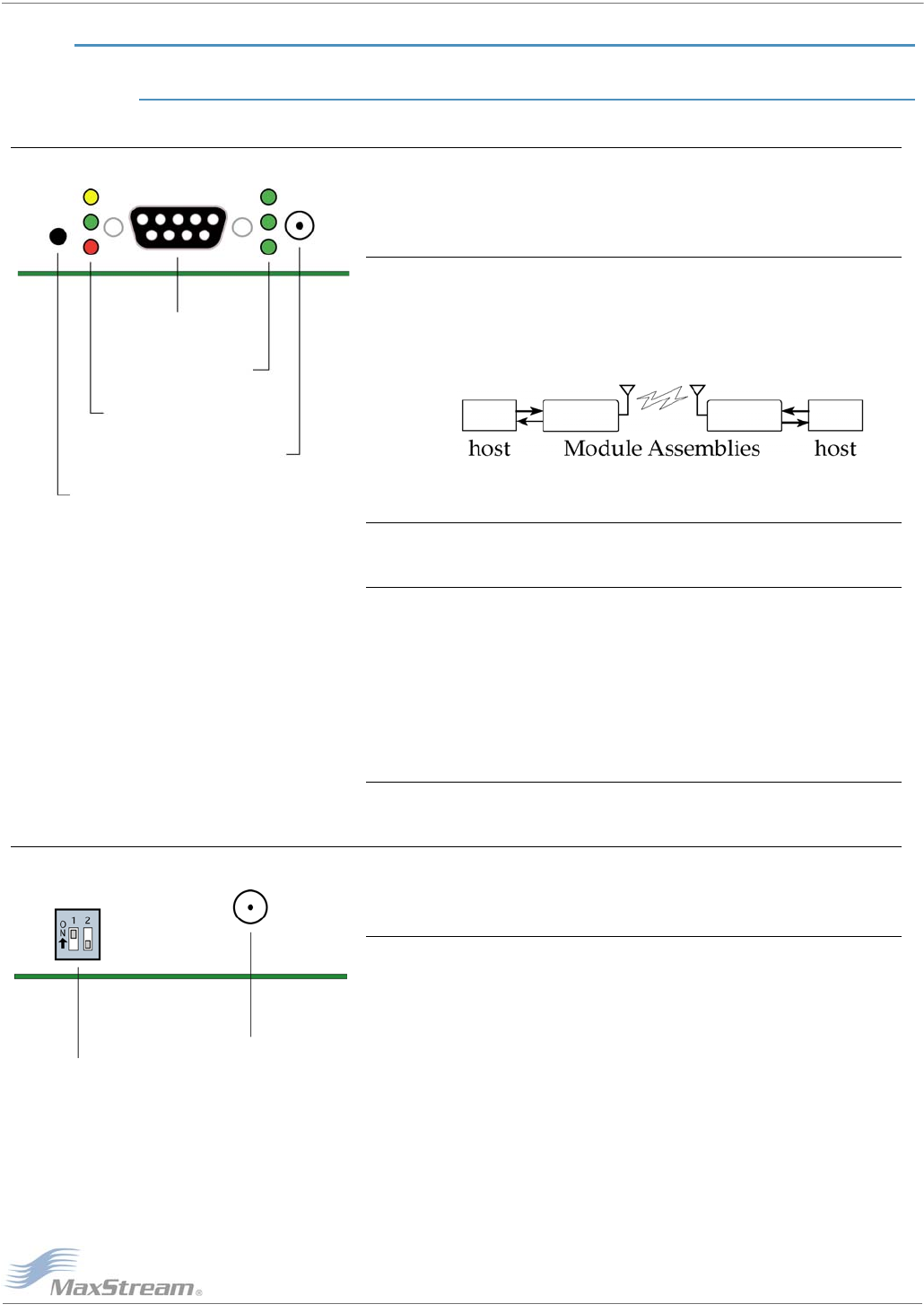
XBee™/XBee‐PROOEMRFModules–ProductManualv1.x7CBETA[2005.12.02]
©2005MaxStream,Inc.,Confidential&Proprietary‐AllRightsReserved 52
RS-232 Interface Board
Physical Interface
B-01a. Reset Switch
FigureB‐01. FrontView The Reset Switch is used to reset (re-boot) the RF module. This
switch only applies when using the configuration tabs of MaxStream’s
X-CTU Software.
B-01b. I/O & Power LEDs
LEDs indicate RF module activity as follows:
Yellow (top LED) = Serial Data Out (to host)
Green (middle) = Serial Data In (from host)
Red (bottom) = Power/TX Indicator (LED is on when module
assembly is powered)
B-01c. Serial Port
Standard female DB-9 (RS-232) connector.
B-01d. RSSI LEDs
RSSI LEDs indicate the amount of fade margin present in an active
wireless link. Fade margin is defined as the difference between the
incoming signal strength and the modem's receiver sensitivity.
3 LEDs ON = Very Strong Signal (> 30 dB fade margin)
2 LEDs ON = Strong Signal (> 20 dB fade margin)
1 LED ON = Moderate Signal (> 10 dB fade margin)
0 LED ON = Weak Signal (< 10 dB fade margin)
B-01e. Power Connector
5-14 VDC power connector
B-02a. DIP Switch
FigureB‐02. BackView DIP Switch functions are not supported in this release. Future down-
loadable firmware versions will support DIP Switch configurations.
B-02b. Antenna Port
Port is a 50Ω RF signal connector for connecting to an external
antenna. The connector type is RPSMA (Reverse Polarity SMA)
female. The connector has threads on the outside of a barrel and a
male center conductor.
B-01a. Reset Switch
B-01b. I/O & Power LEDs
B-01c. Serial Port
B-01e. Power Connector
B-01d. RSSI LEDs
B-02b. Antenna Port
B-02a. DIP Switch
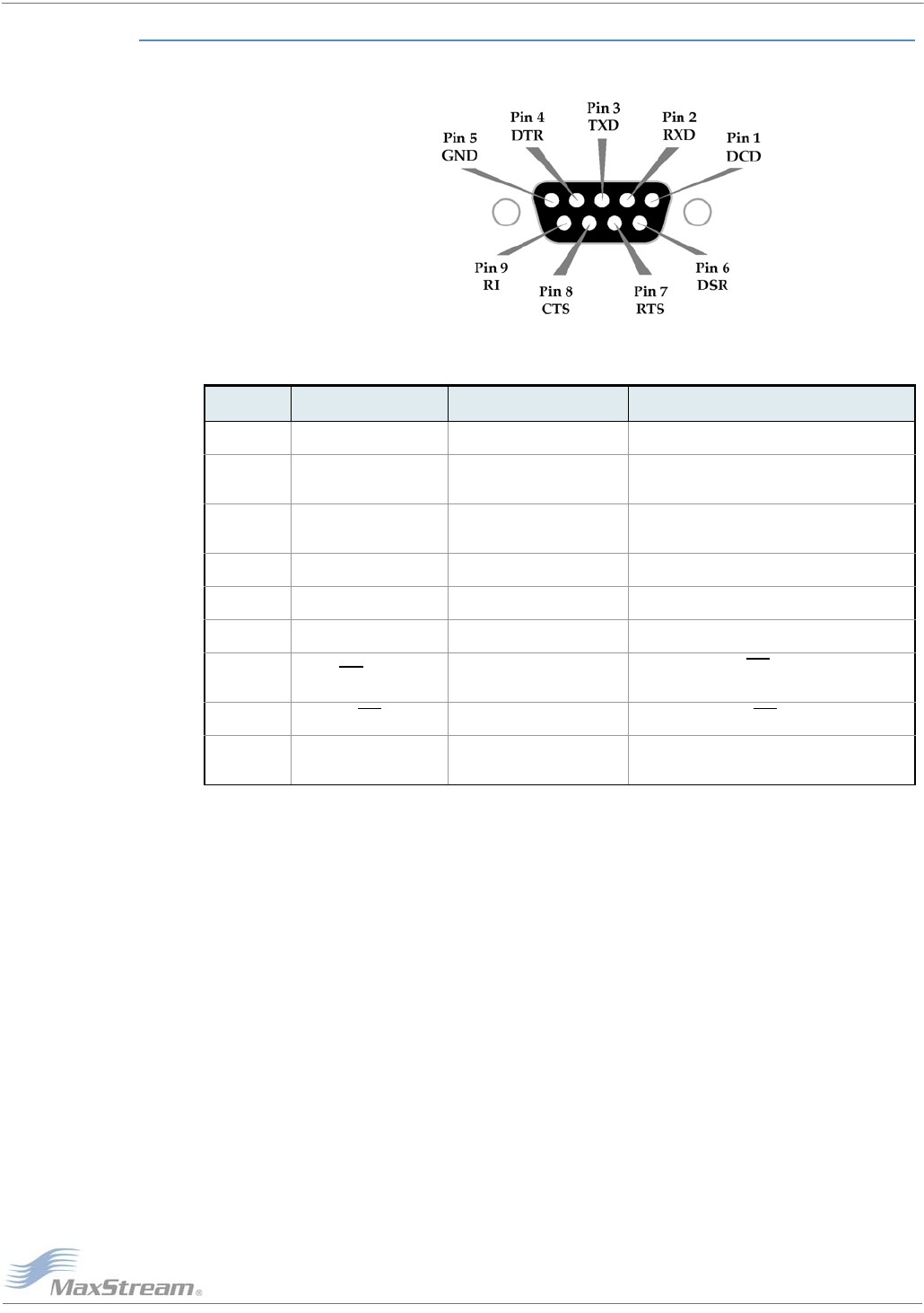
XBee™/XBee‐PROOEMRFModules–ProductManualv1.x7CBETA[2005.12.02]
©2005MaxStream,Inc.,Confidential&Proprietary‐AllRightsReserved 53
RS-232 Pin Signals
FigureB‐03. PinsusedonthefemaleRS‐232(DB‐9)SerialConnector
*Functionslistedintheimplementationcolumnmaynotbeavailableatthetimeofrelease.
TableB‐02. PinAssignmentsandImplementations
DB-9 Pin RS-232 Name Description Implementation*
1 DCD Data-Carrier-Detect Connected to DSR (pin6)
2 RXD Receive Data Serial data exiting the module assembly
(to host)
3 TXD Transmit Data Serial data entering into the module assembly
(from host)
4 DTR Data-Terminal-Ready Can enable Power-Down on the module assembly
5 GND Ground Signal Ground
6 DSR Data-Set-Ready Connected to DCD (pin1)
7RTS / CMD Request-to-Send /
Command Mode Provides RTS flow control or
enables Command Mode
8CTS Clear-to-Send Provides CTS flow control
9 RI Ring Indicator Optional power input that is connected internally to
the positive lead of the front power connector
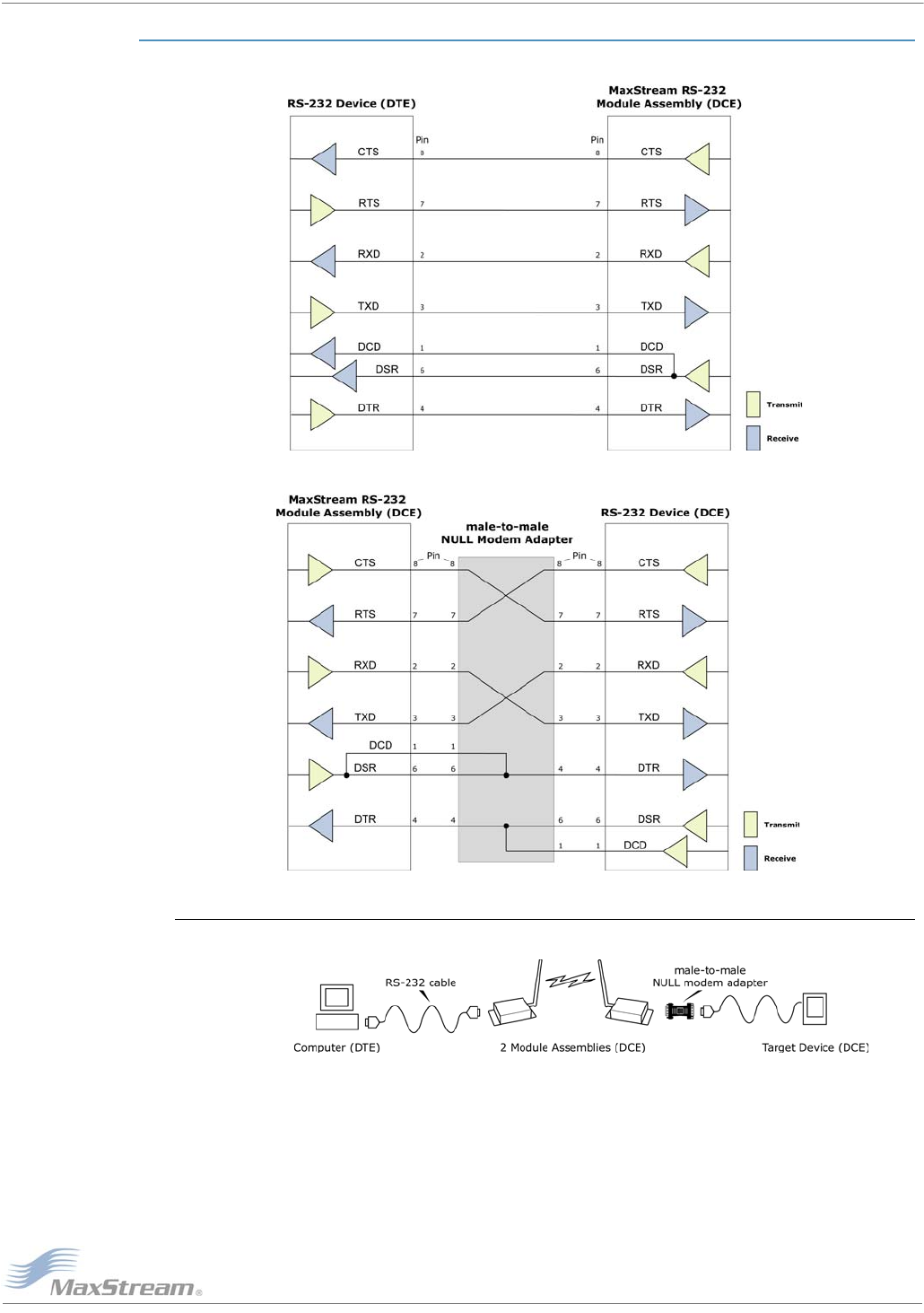
XBee™/XBee‐PROOEMRFModules–ProductManualv1.x7CBETA[2005.12.02]
©2005MaxStream,Inc.,Confidential&Proprietary‐AllRightsReserved 54
Wiring Diagrams
FigureB‐04. DTEDevice(RS‐232,maleDB‐9connector)wiredtoaDCEModuleAssembly(femaleDB‐9)
FigureB‐05. DCEModuleAssembly(femaleDB‐9connector)wiredtoaDCEDevice(RS‐232,maleDB‐9)
Sample Wireless Connection: DTE <--> DCE <--> DCE <--> DCE
FigureB‐06. TypicalwirelesslinkbetweenDTEandDCEdevices
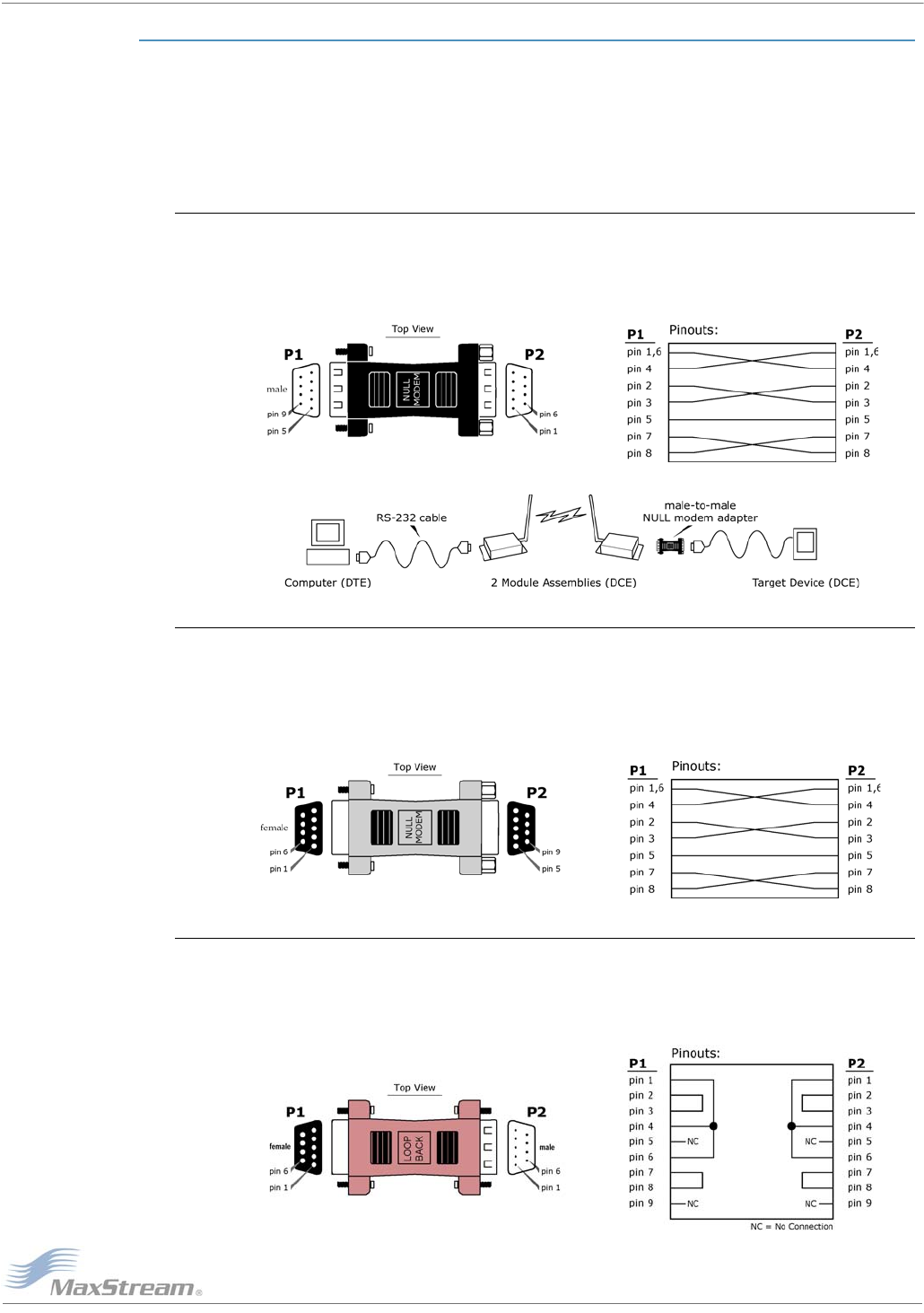
XBee™/XBee‐PROOEMRFModules–ProductManualv1.x7CBETA[2005.12.02]
©2005MaxStream,Inc.,Confidential&Proprietary‐AllRightsReserved 55
Adapters
The development kit includes several adapters that support the following functions:
• Performing Range Tests
• Testing Cables
• Connecting to other RS-232 DCE and DTE devices
• Connecting to terminal blocks or RJ-45 (for RS-485/422 devices)
NULL Modem Adapter (male-to-male)
Part Number: JD2D2-CDN-A (Black, DB-9 M-M) The male-to-male NULL modem adapter is
used to connect two DCE devices. A DCE device connects with a straight-through cable to the male
serial port of a computer (DTE).
FigureB‐07. MaleNULLmodemadapterandpinouts
FigureB‐08. ExampleofaMaxStreamRadioModem(DCEDevice)connectingtoanotherDCEdevice)
NULL Modem Adapter (female-to-female)
Part Number: JD3D3-CDN-A (Gray, DB-9 F-F) The female-to-female NULL modem adapter is
used to verify serial cabling is functioning properly. To test cables, insert the female-to-female
NULL modem adapter in place of a pair of module assemblies (RS-232 interface board + XTend
Module) and test the connection without radio modules in the connection.
FigureB‐09. FemaleNULLmodemadapterandpinouts
Serial Loopback Adapter
Part Number: JD2D3-CDL-A (Red, DB-9 M-F) The serial loopback adapter is used for range
testing. During a range test, the serial loopback adapter configures the module to function as a
repeater by looping serial data back into the radio for retransmission.
FigureB‐10. Serialloopbackadapterandpinouts
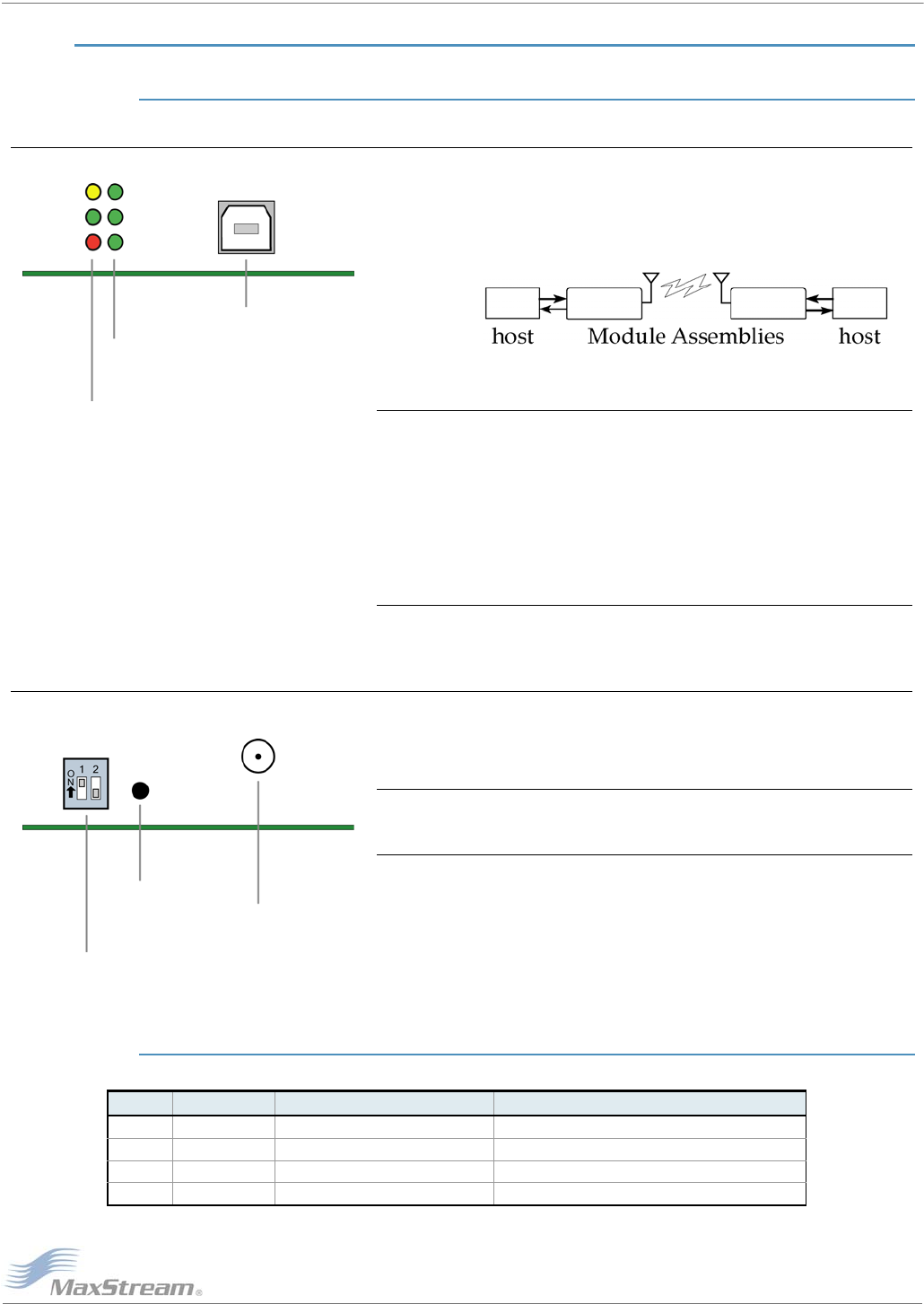
XBee™/XBee‐PROOEMRFModules–ProductManualv1.x7CBETA[2005.12.02]
©2005MaxStream,Inc.,Confidential&Proprietary‐AllRightsReserved 56
USB Interface Board
Physical Interface
USB Pin Signals
B-11a. I/O & Power LEDs
FigureB‐11. FrontView LEDs indicate RF module activity as follows:
Yellow (top LED) = Serial Data Out (to host)
Green (middle) = Serial Data In (from host)
Red (bottom) = Power/TX Indicator (Red LED is illuminated
when RF module is powered)
B-11b. RSSI LEDs
RSSI LEDs indicate the amount of fade margin present in an active
wireless link. Fade margin is defined as the difference between the
incoming signal strength and the module's receiver sensitivity.
3 LEDs ON = Very Strong Signal (> 30 dB fade margin)
2 LEDs ON = Strong Signal (> 20 dB fade margin)
1 LED ON = Moderate Signal (> 10 dB fade margin)
0 LED ON = Weak Signal (< 10 dB fade margin)
B-11c. USB Port
Standard Type-B OEM connector is used to communicate with OEM
host and power the RF module.
B-12a. DIP Switch
FigureB‐12. BackView DIP Switch functions are not supported in this release. Future down-
loadable firmware versions will support the DIP Switch configurations.
B-12b Reset Switch
The Reset Switch is used to reset (re-boot) the RF module.
B-12c. Antenna Port
Port is a 50Ω RF signal connector for connecting to an external
antenna. The connector type is RPSMA (Reverse Polarity SMA)
female. The connector has threads on the outside of a barrel and a
male center conductor.
TableB‐03. USBsignalsandtheirimplantationsontheXBee/XBee‐PRORFModule
Pin Name Description Implementation
1 VBUS Power Power the RF module
2 D- Transmitted & Received Data Transmit data to and from the RF module
3 D+ Transmitted & Received Data Transmit data to and from the RF module
4 GND Ground Signal Ground
B-11a. I/O & Power LEDs
B-11b. RSSI LEDs
B-11c. USB Port
B-12a. DIP Switch
B-12b. Reset Switch
B-12c. Antenna Port
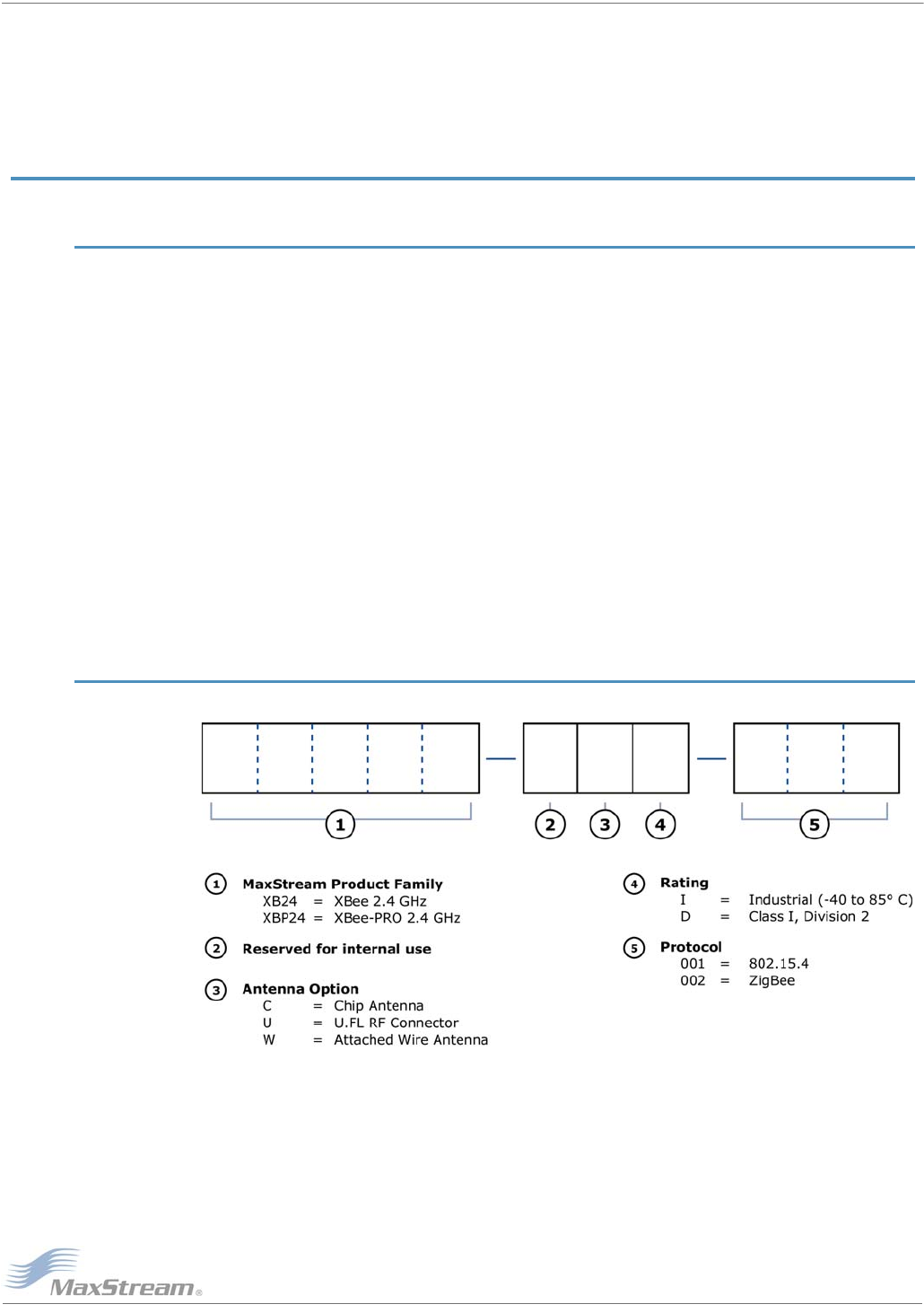
XBee™/XBee‐PROOEMRFModules–ProductManualv1.x7CBETA[2005.12.02]
©2005MaxStream,Inc.,Confidential&Proprietary‐AllRightsReserved 57
AppendixC:AdditionalInformation
1-Year Warranty
XBee/XBee-PRO RF Modules from MaxStream, Inc. (the "Product") are warranted against defects
in materials and workmanship under normal use, for a period of 1-year from the date of purchase.
In the event of a product failure due to materials or workmanship, MaxStream will repair or
replace the defective product. For warranty service, return the defective product to MaxStream,
shipping prepaid, for prompt repair or replacement.
The foregoing sets forth the full extent of MaxStream's warranties regarding the Product. Repair or
replacement at MaxStream's option is the exclusive remedy. THIS WARRANTY IS GIVEN IN LIEU
OF ALL OTHER WARRANTIES, EXPRESS OR IMPLIED, AND MAXSTREAM SPECIFICALLY DISCLAIMS
ALL WARRANTIES OF MERCHANTABILITY OR FITNESS FOR A PARTICULAR PURPOSE. IN NO
EVENT SHALL MAXSTREAM, ITS SUPPLIERS OR LICENSORS BE LIABLE FOR DAMAGES IN EXCESS
OF THE PURCHASE PRICE OF THE PRODUCT, FOR ANY LOSS OF USE, LOSS OF TIME, INCONVE-
NIENCE, COMMERCIAL LOSS, LOST PROFITS OR SAVINGS, OR OTHER INCIDENTAL, SPECIAL OR
CONSEQUENTIAL DAMAGES ARISING OUT OF THE USE OR INABILITY TO USE THE PRODUCT, TO
THE FULL EXTENT SUCH MAY BE DISCLAIMED BY LAW. SOME STATES DO NOT ALLOW THE
EXCLUSION OR LIMITATION OF INCIDENTAL OR CONSEQUENTIAL DAMAGES. THEREFORE, THE
FOREGOING EXCLUSIONS MAY NOT APPLY IN ALL CASES. This warranty provides specific legal
rights. Other rights which vary from state to state may also apply.
Ordering Information
FigureC‐01.DivisionsoftheXBee/XBee‐PRORFModulePartNumbers
For example:
XBP24-AWI-001 = XBee-PRO OEM RF Module, 2.4 GHz, attached wire antenna, Industrial temper-
ature rating, IEEE 802.15.4 standard

XBee™/XBee‐PROOEMRFModules–ProductManualv1.x7CBETA[2005.12.02]
©2005MaxStream,Inc.,Confidential&Proprietary‐AllRightsReserved 58
Contact MaxStream
Free and unlimited technical support is included with every MaxStream Radio Modem sold. For the
best in wireless data solutions and support, please use the following resources:
MaxStream office hours are 8:00 am - 5:00 pm [U.S. Mountain Standard Time]
Documentation: www.maxstream.net/helpdesk/download.php
Technical Support: Phone. (866) 765-9885 toll-free U.S.A. & Canada
(801) 765-9885 Worldwide
Live Chat. www.maxstream.net
E-Mail. rf-xperts@maxstream.net